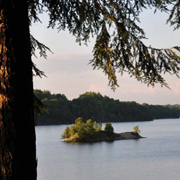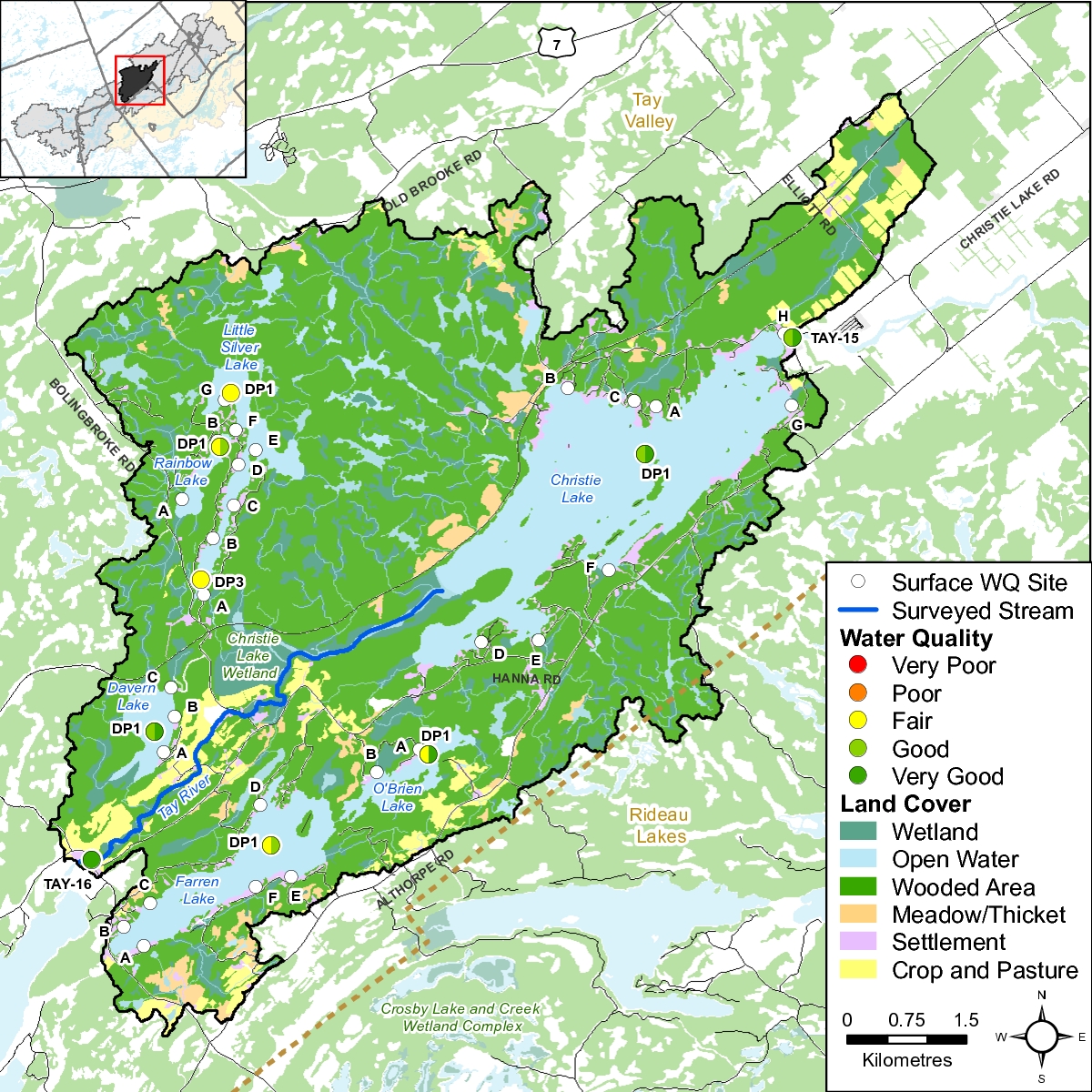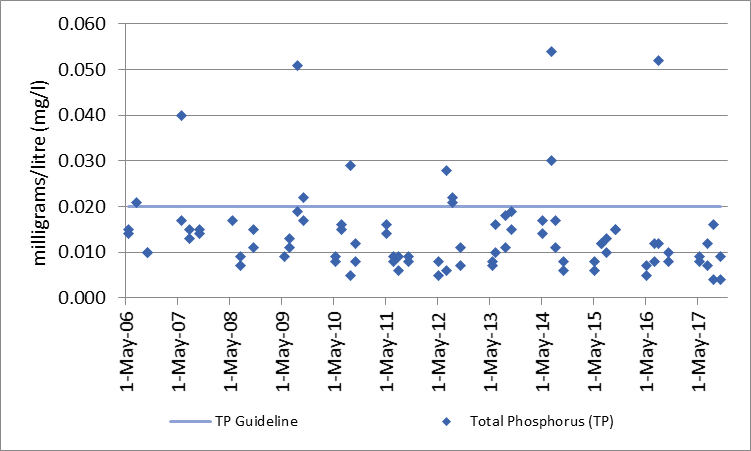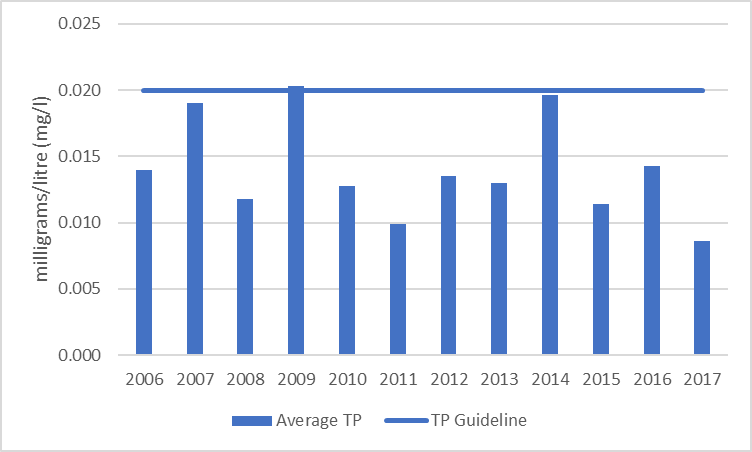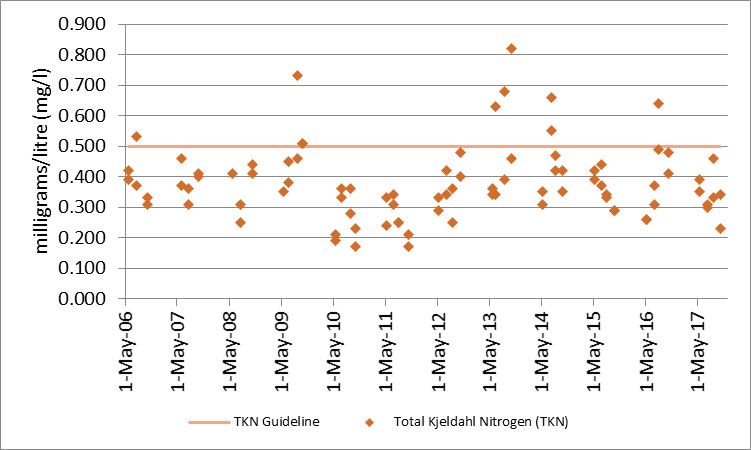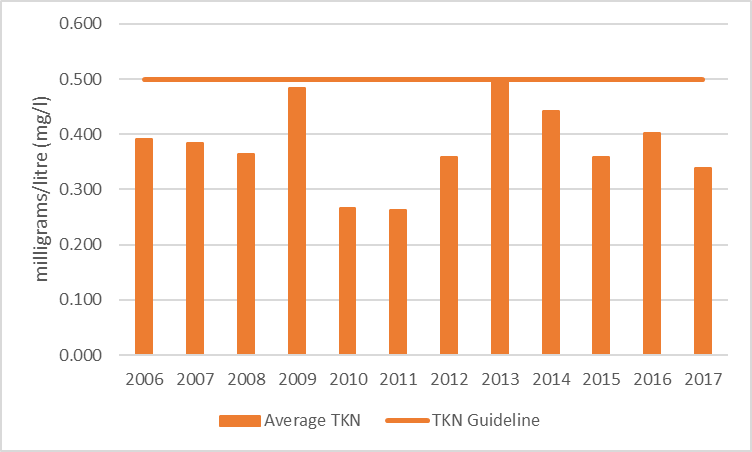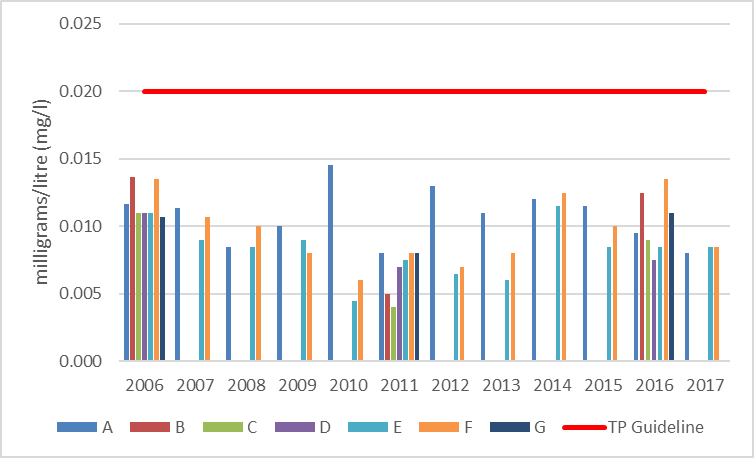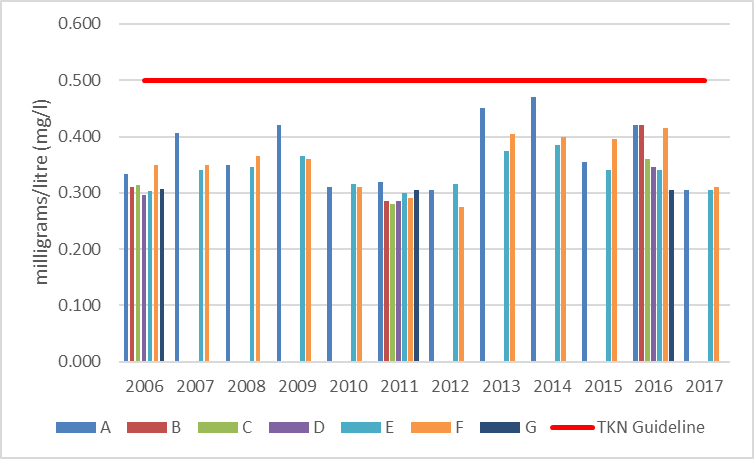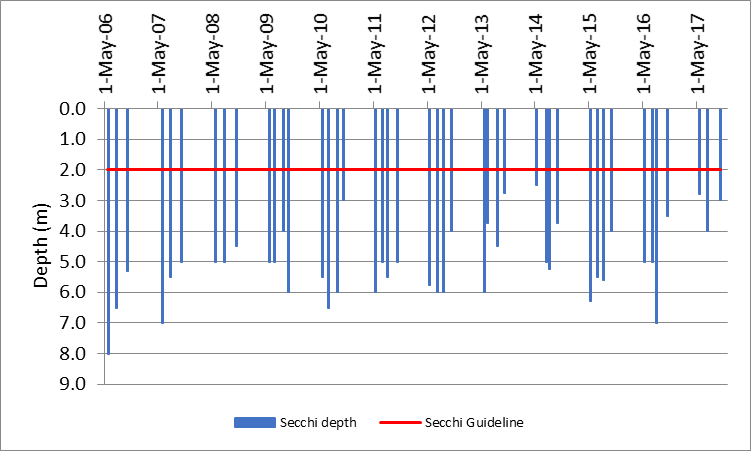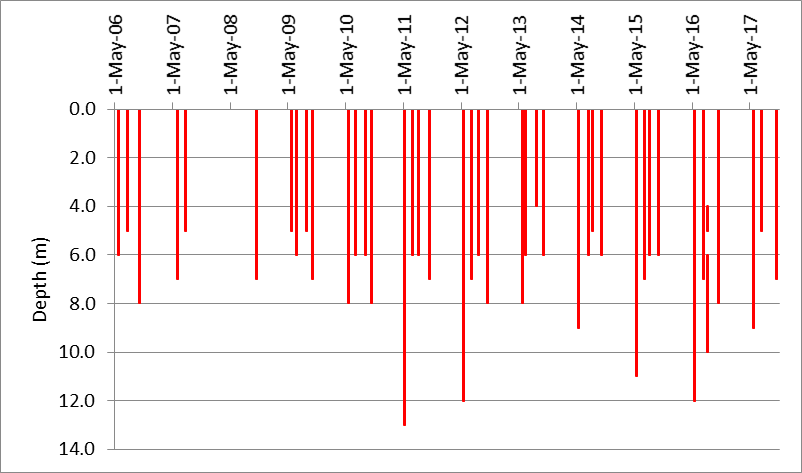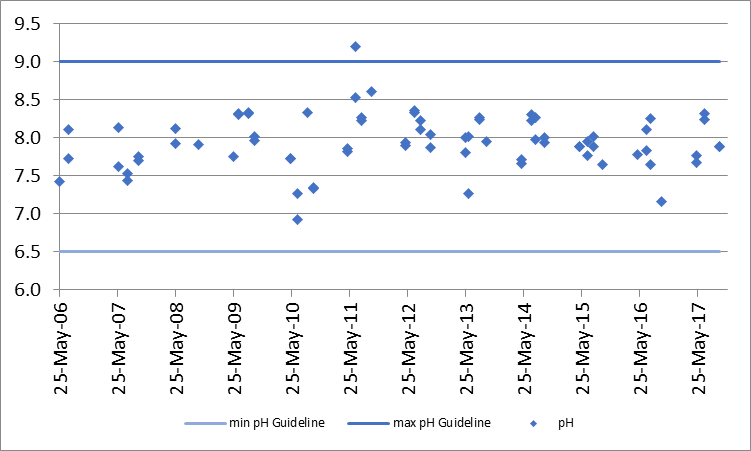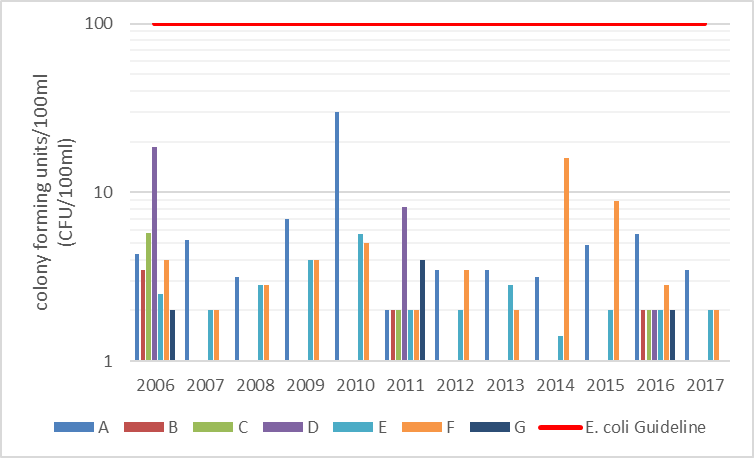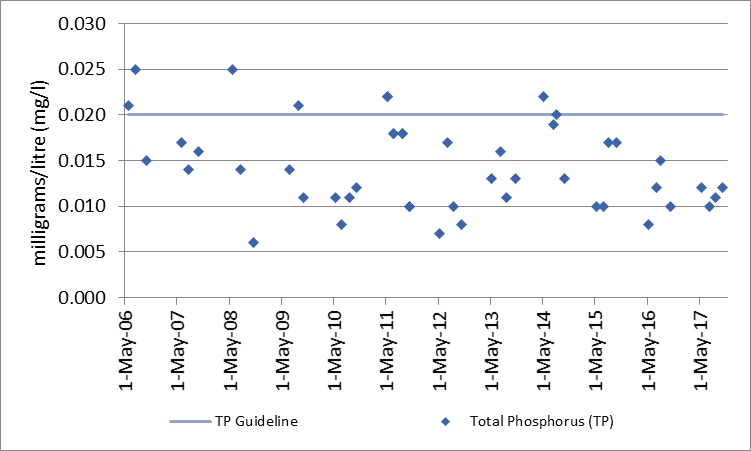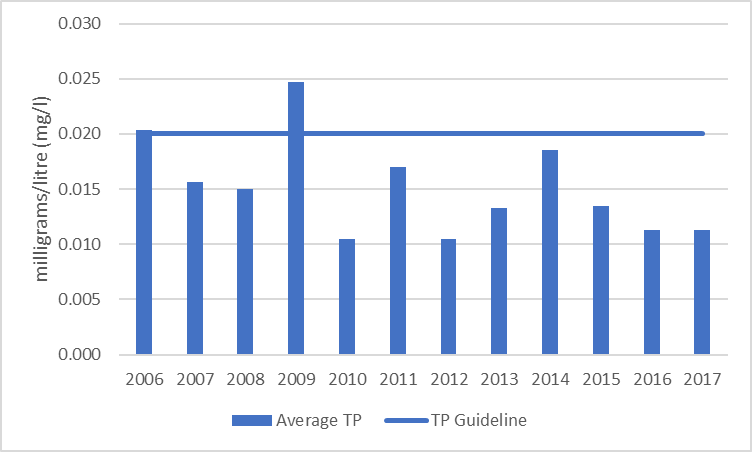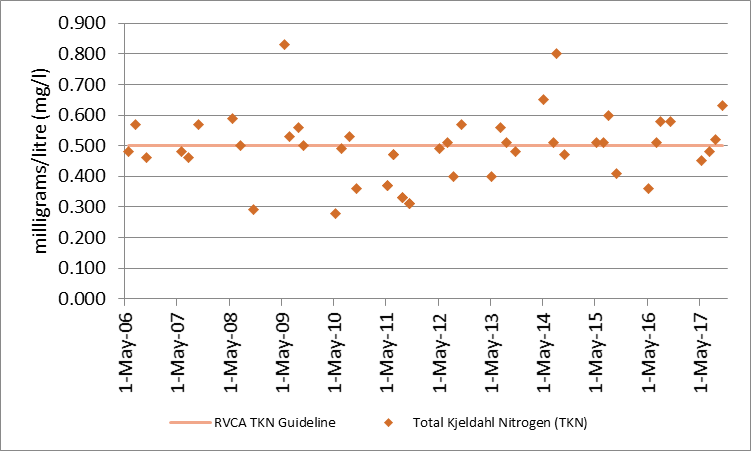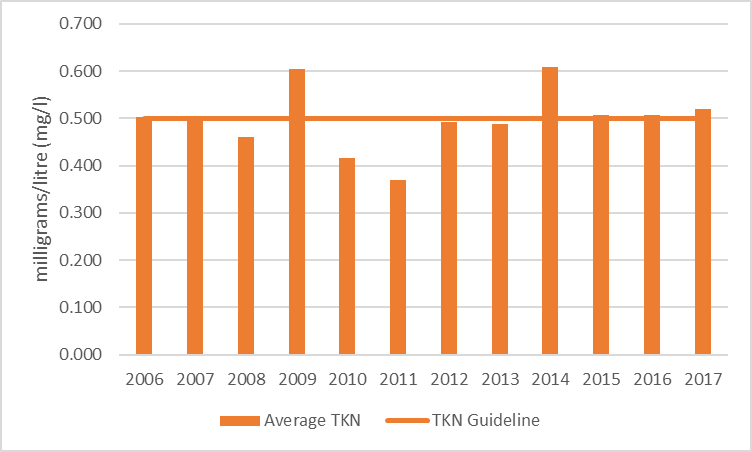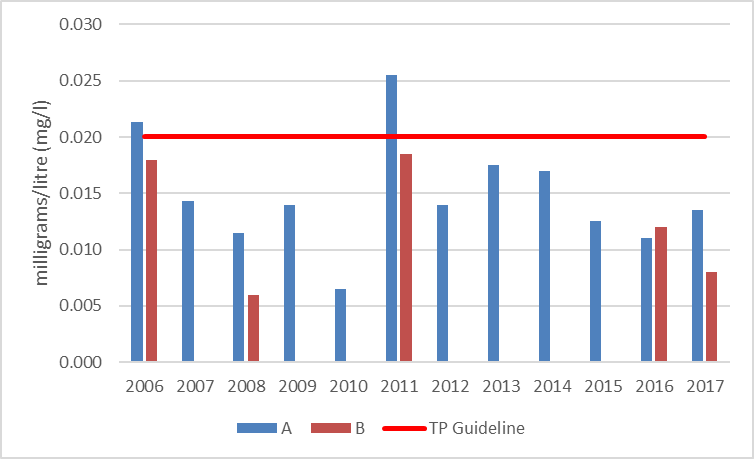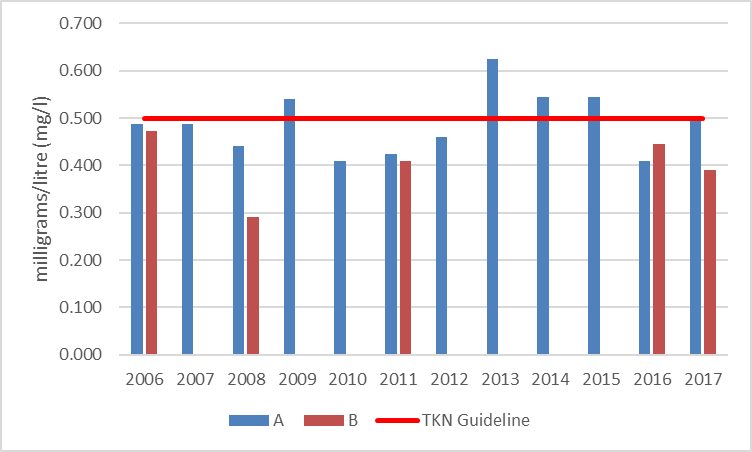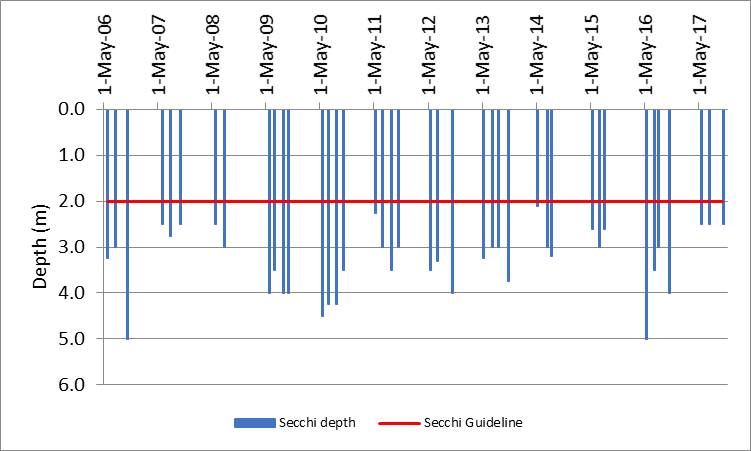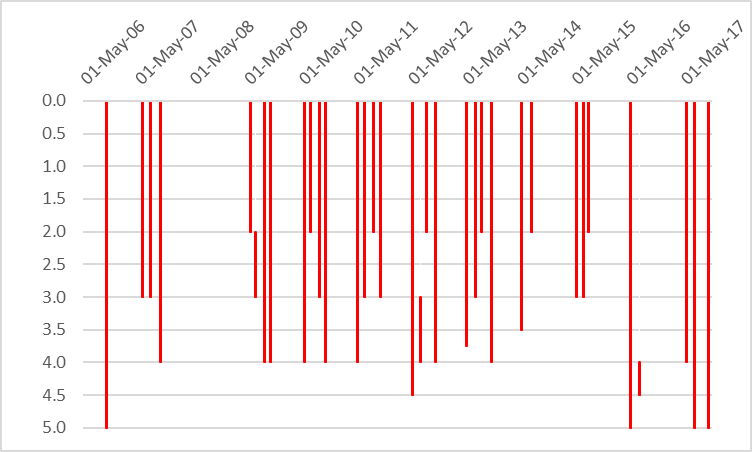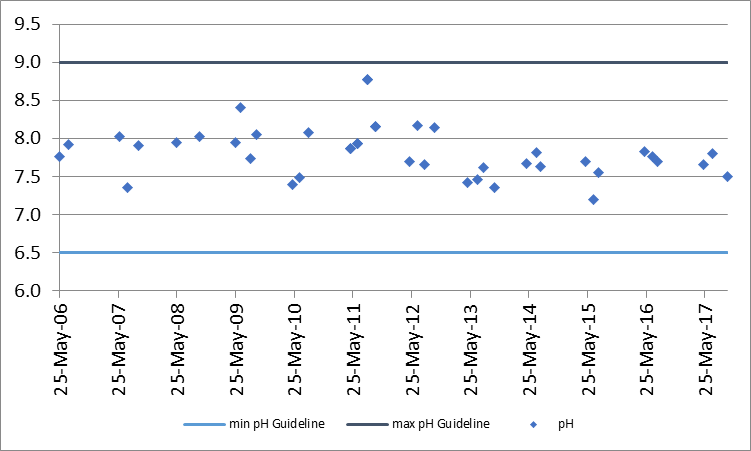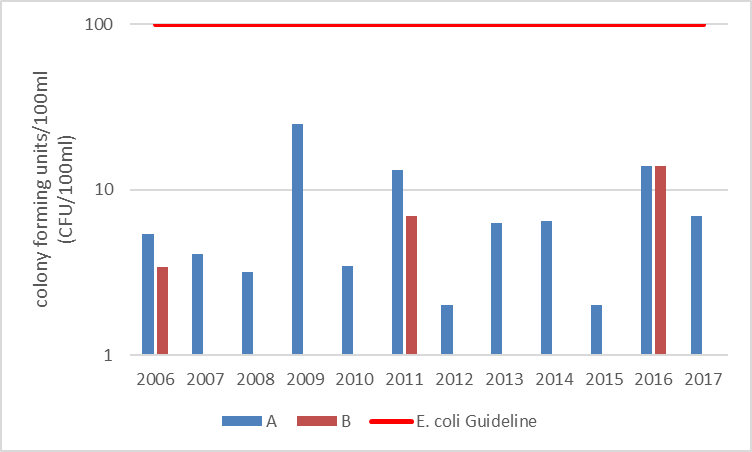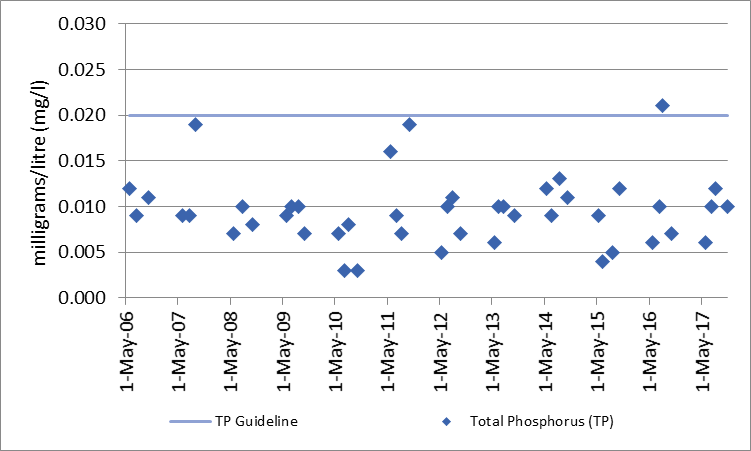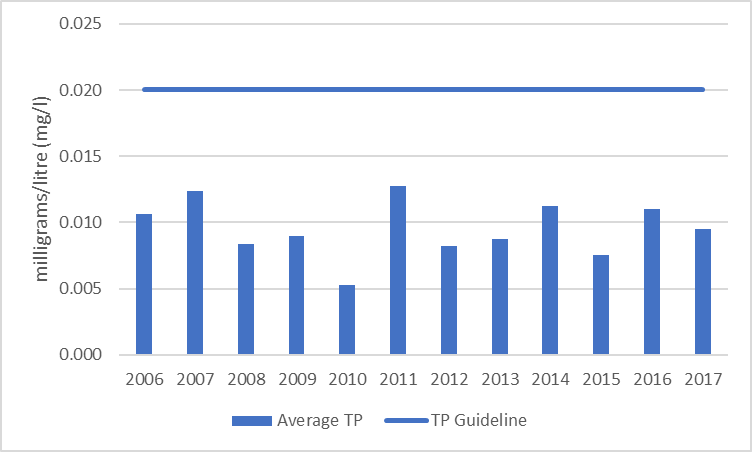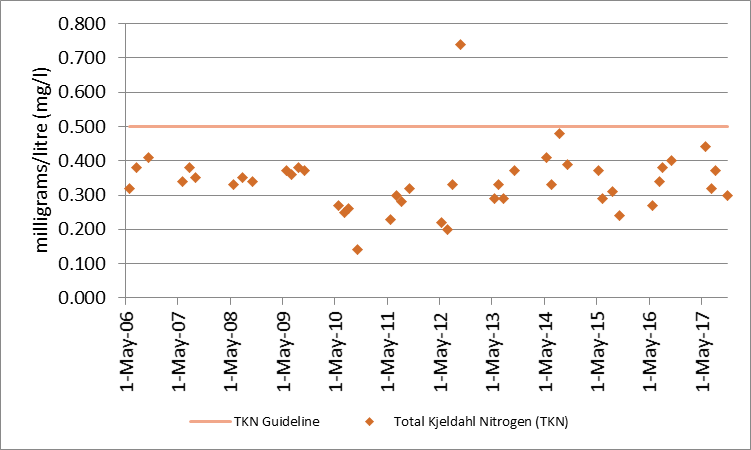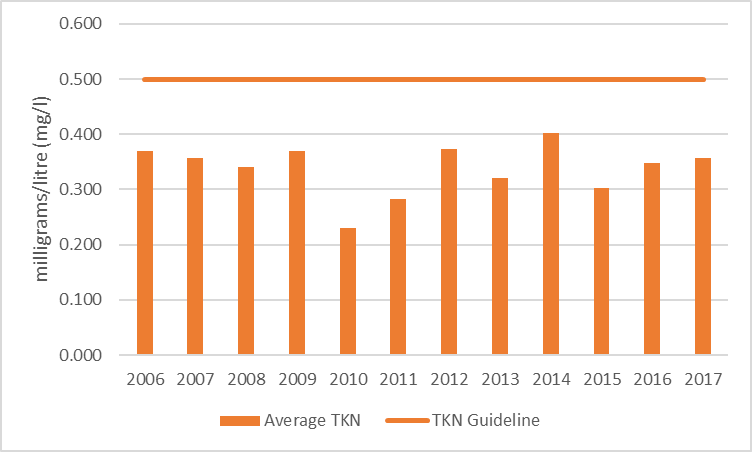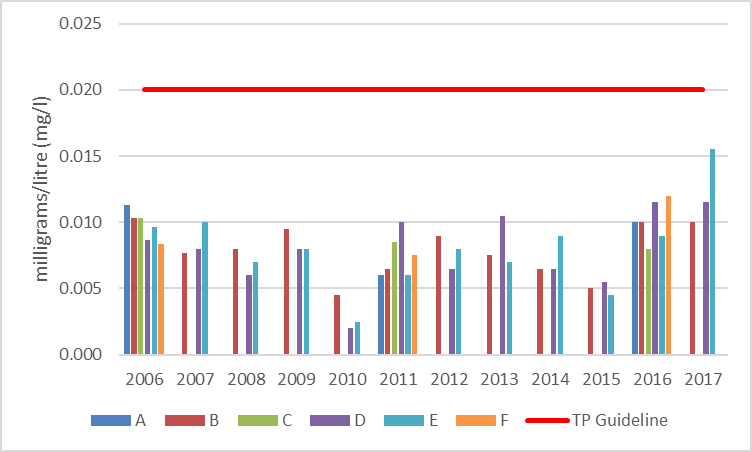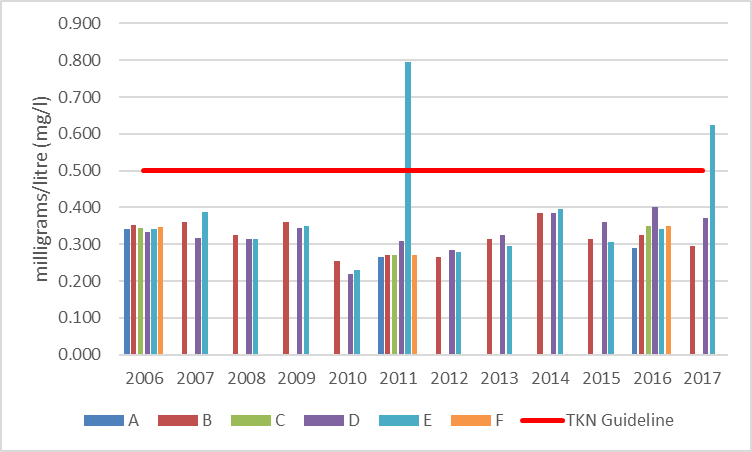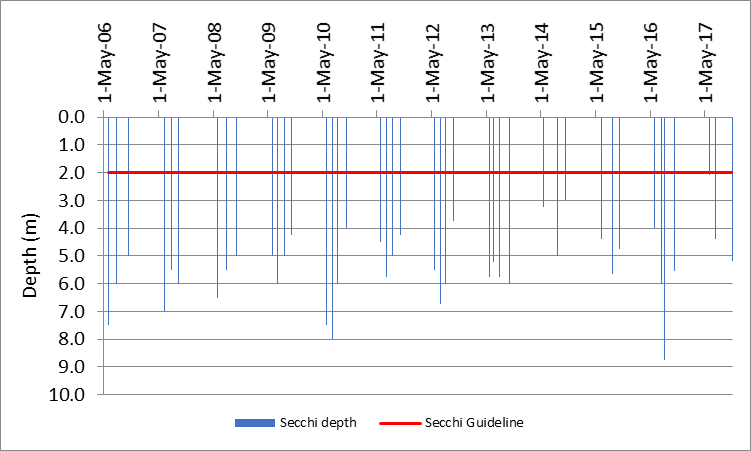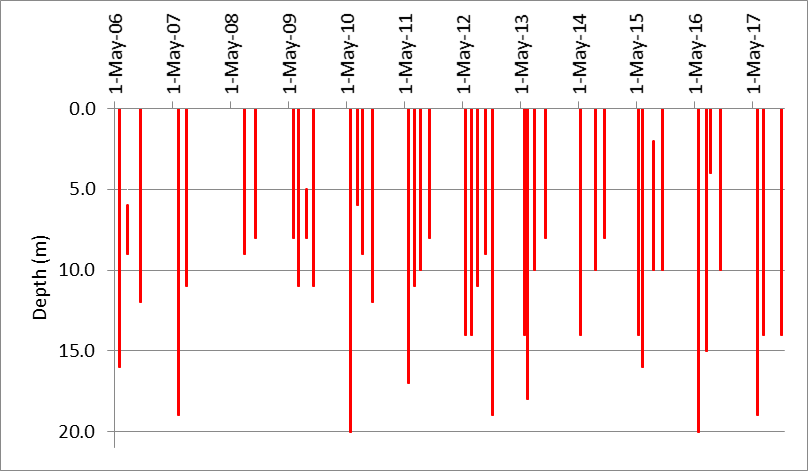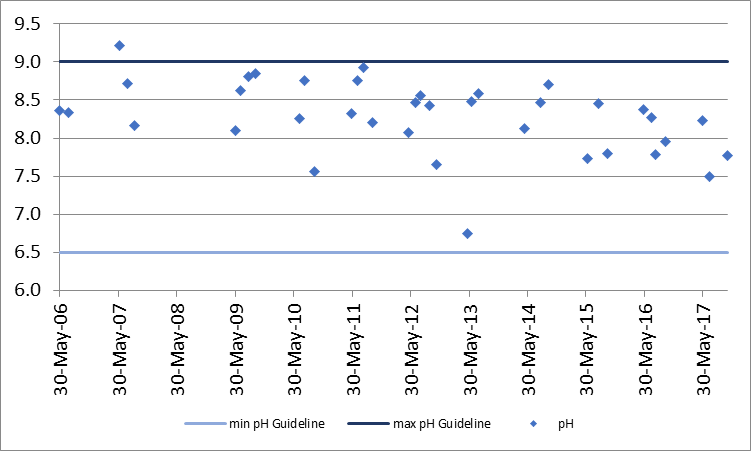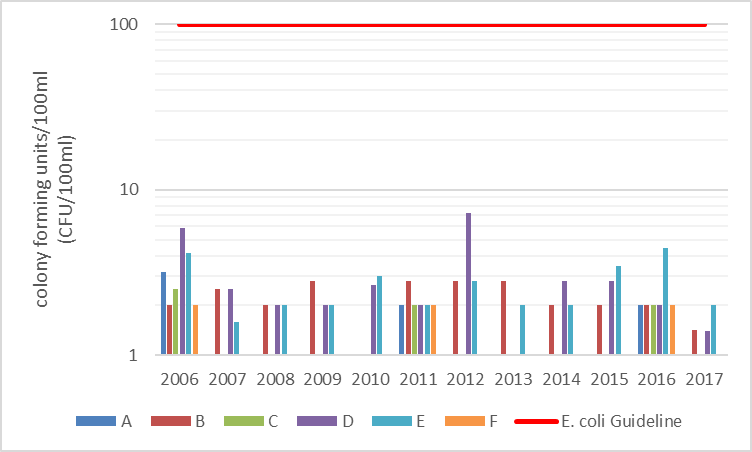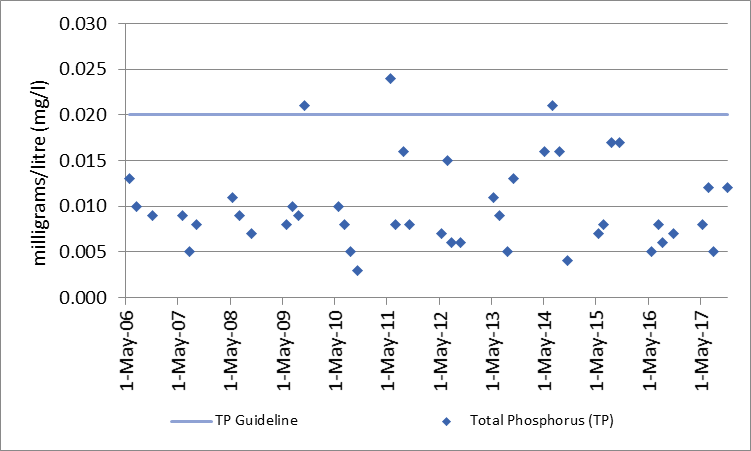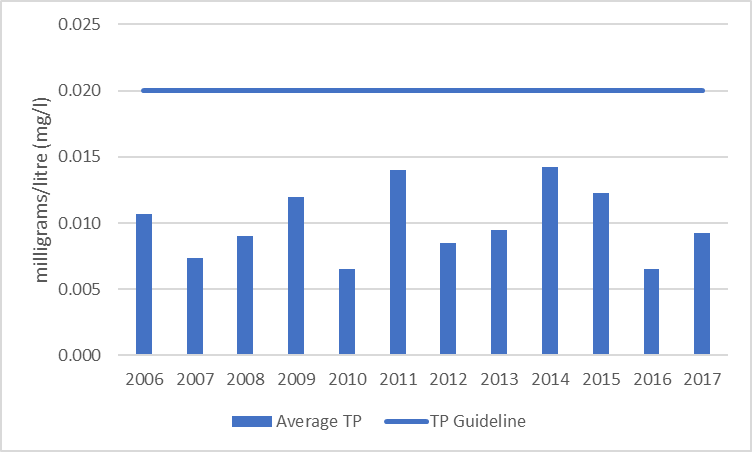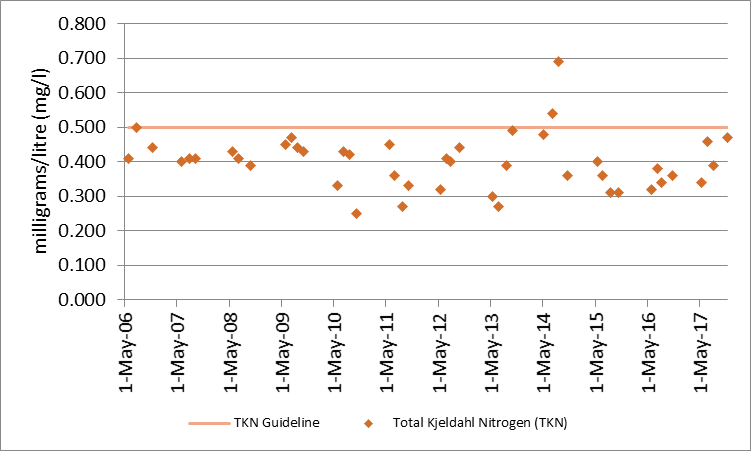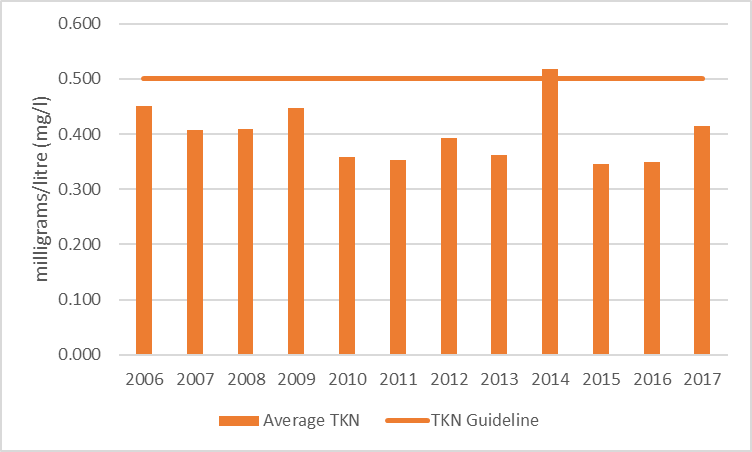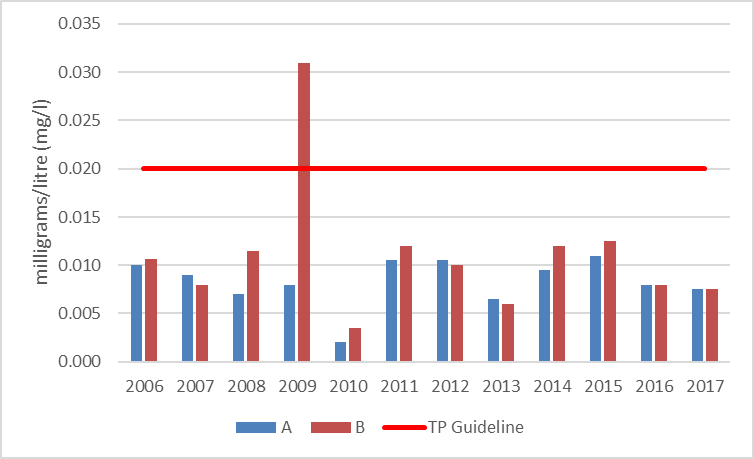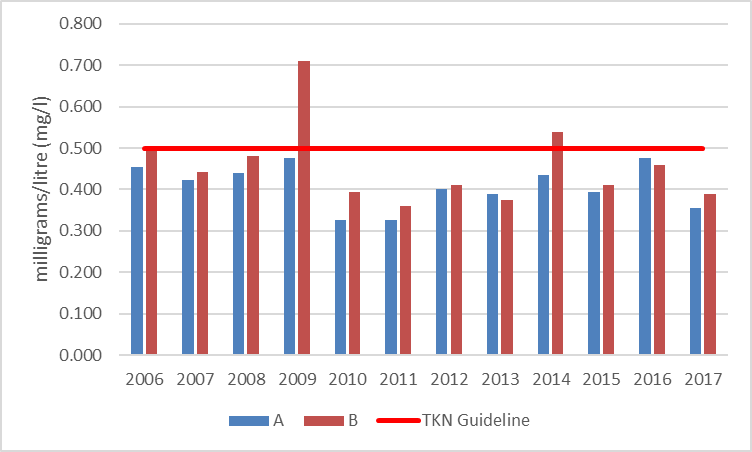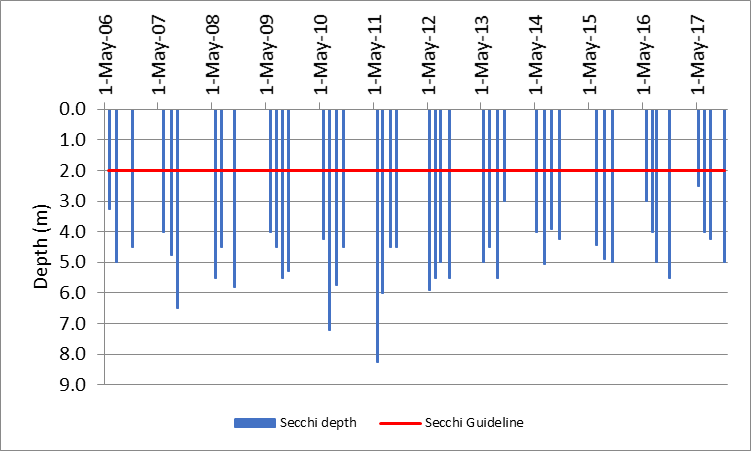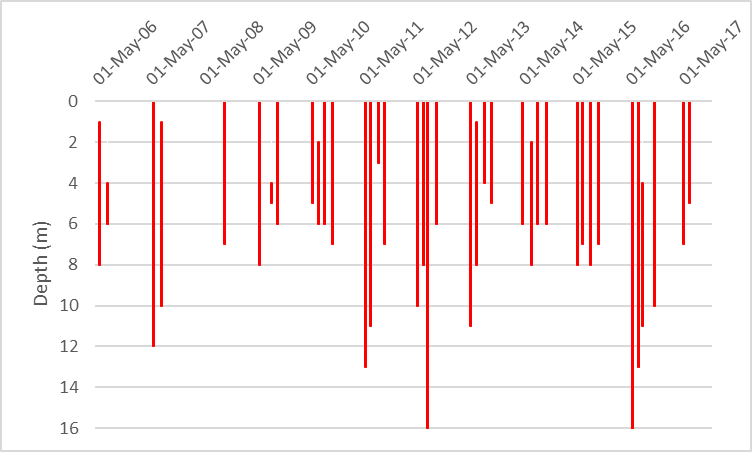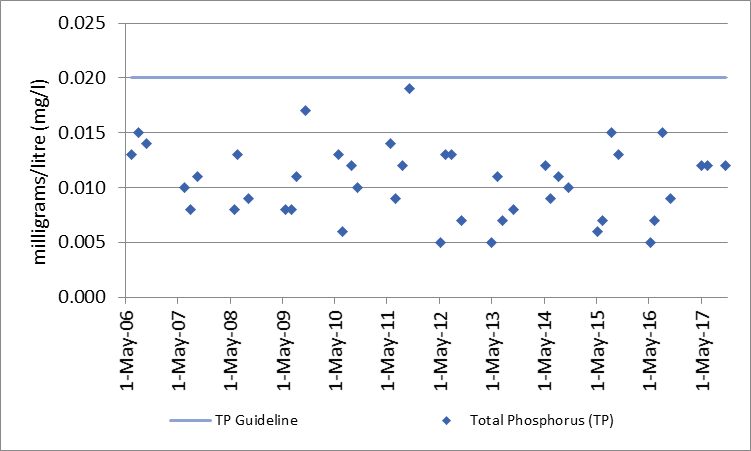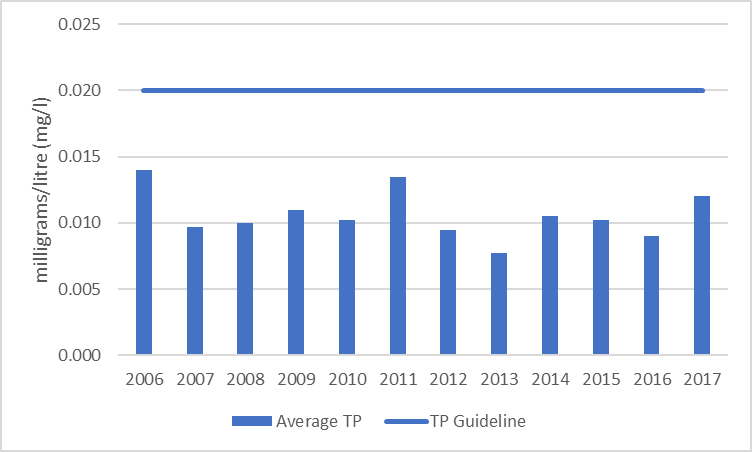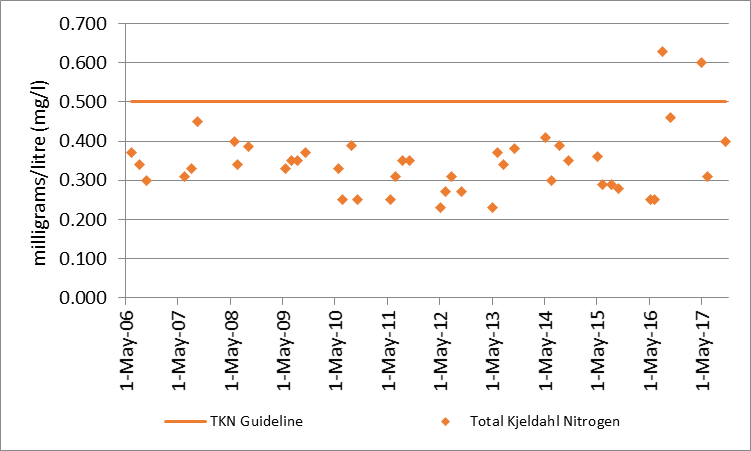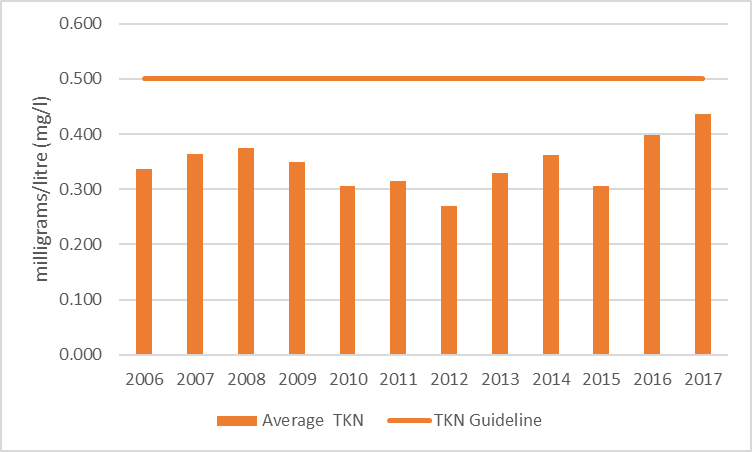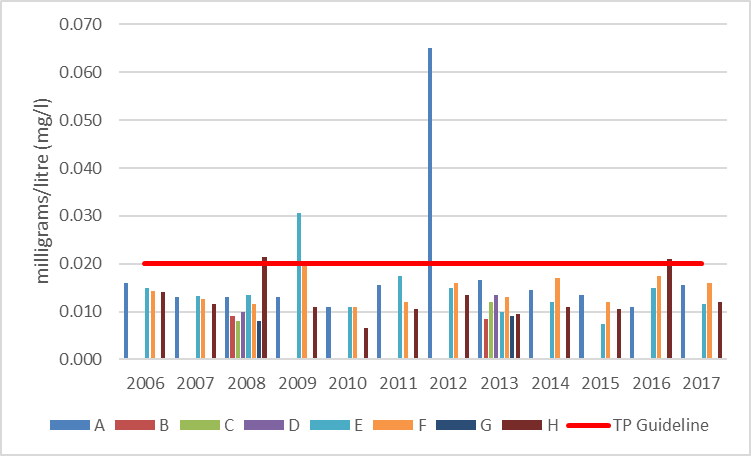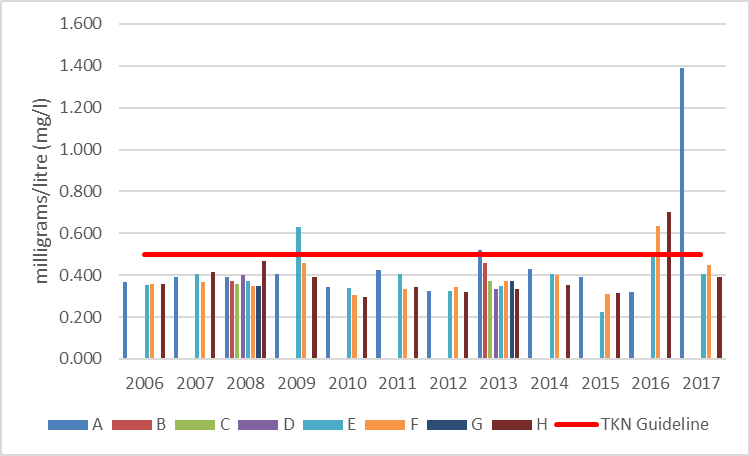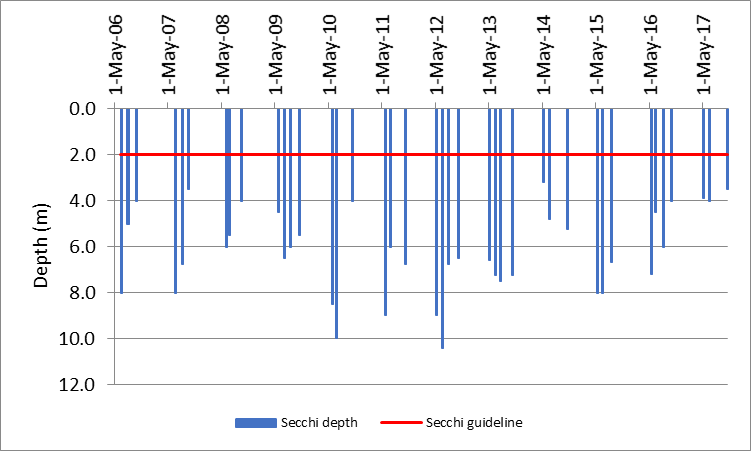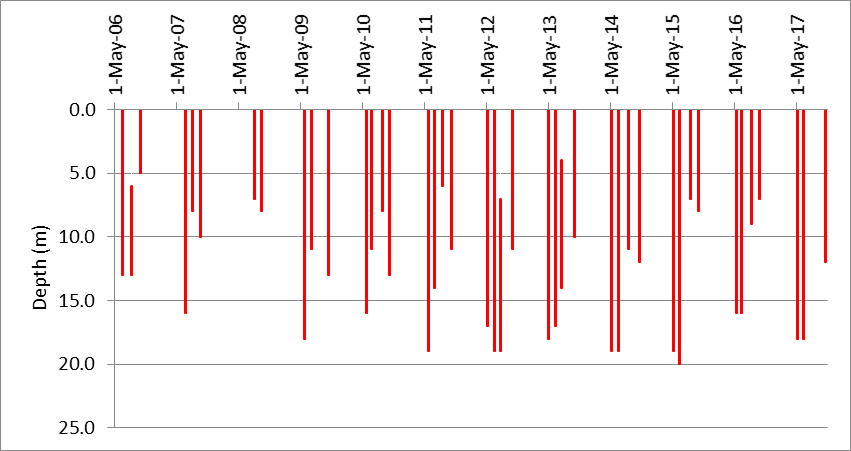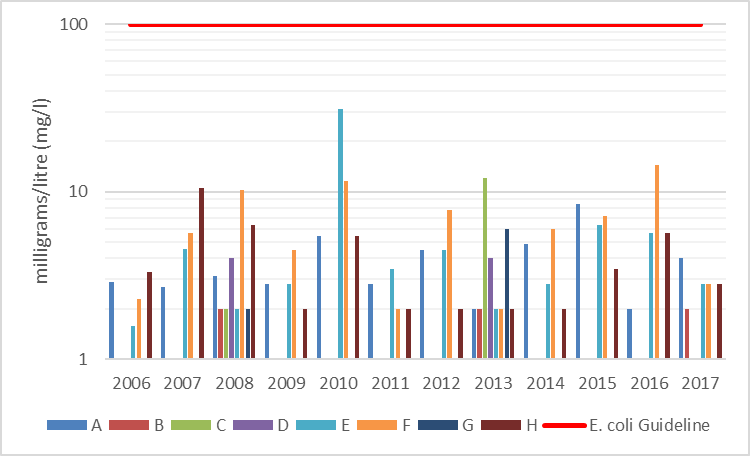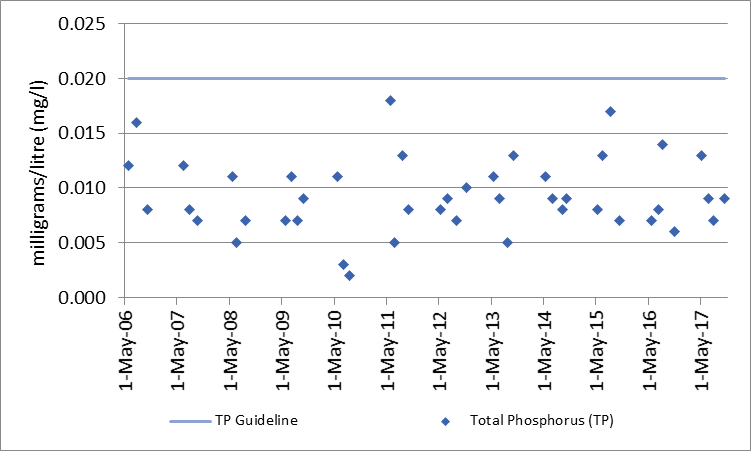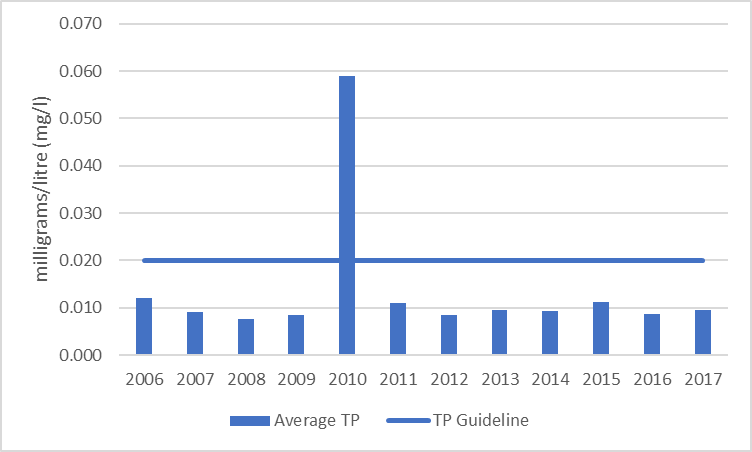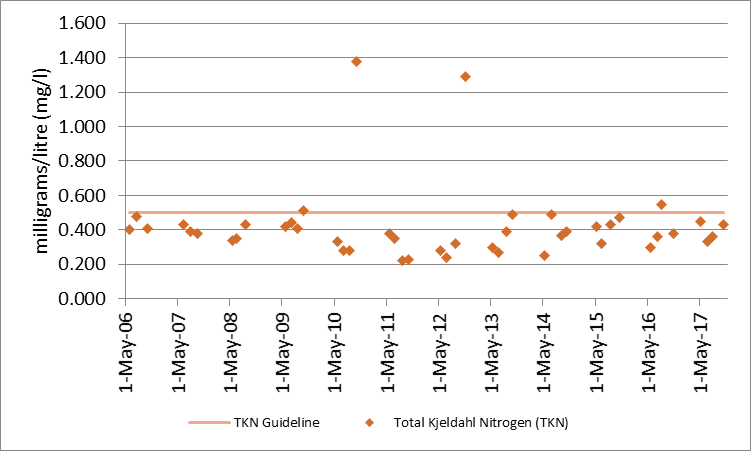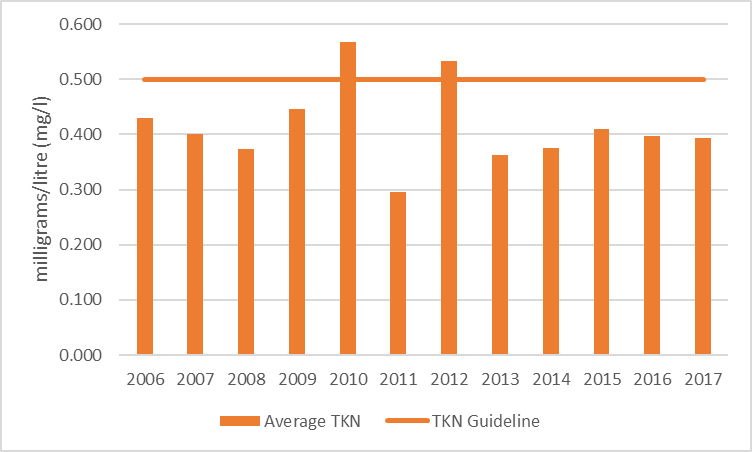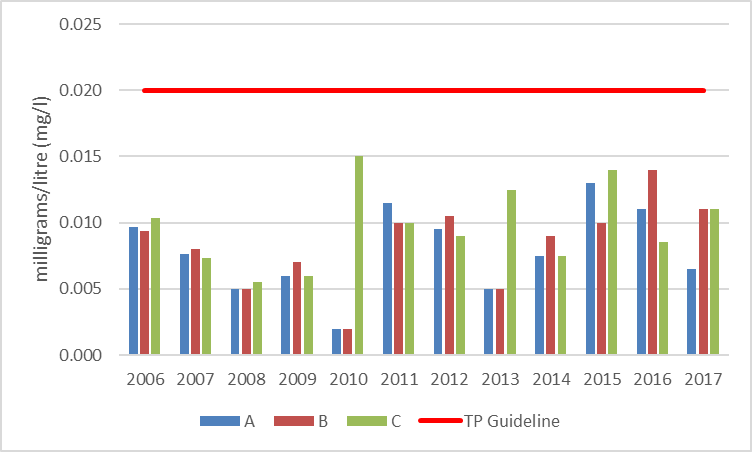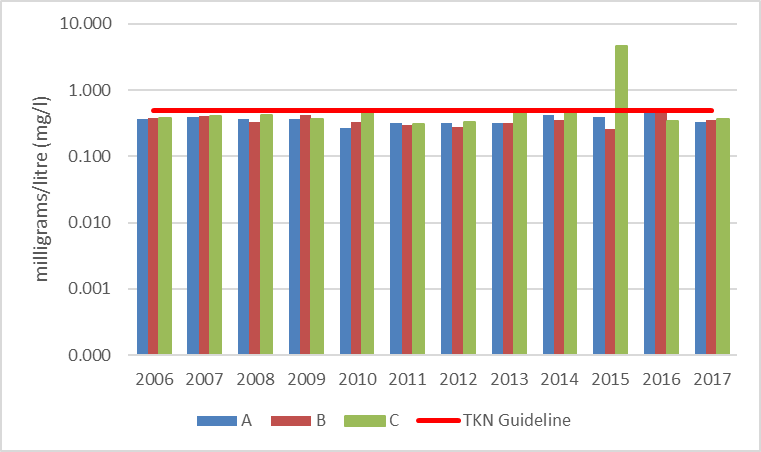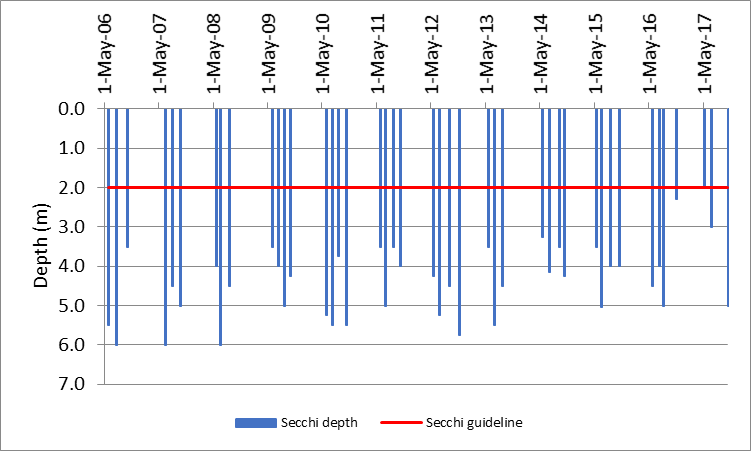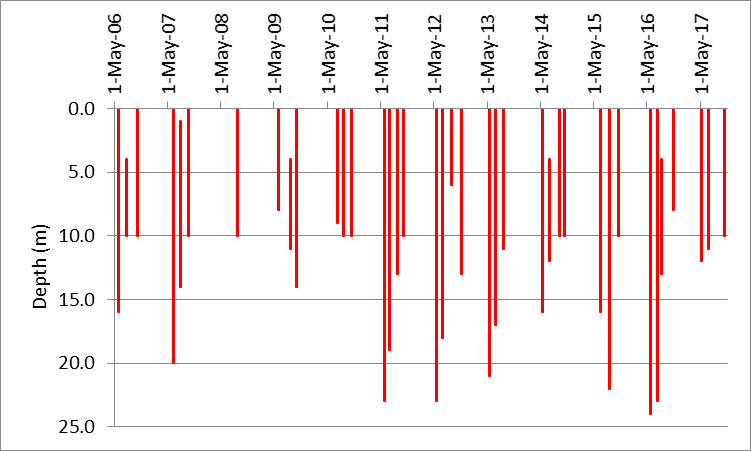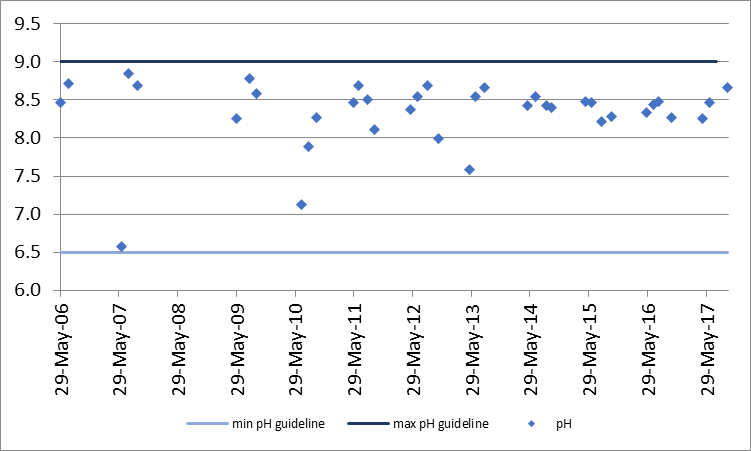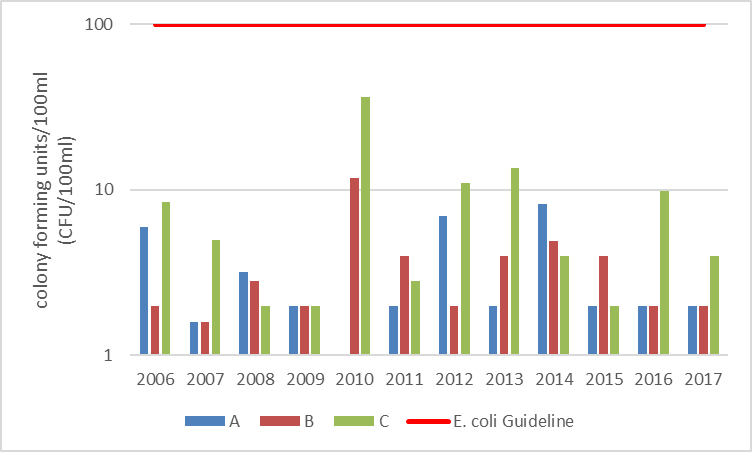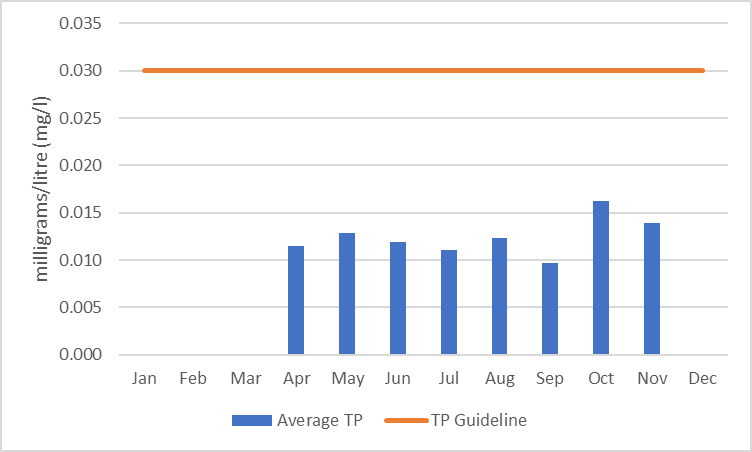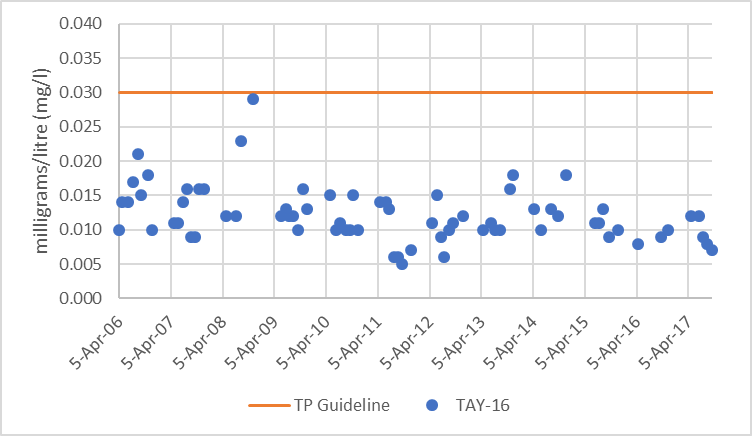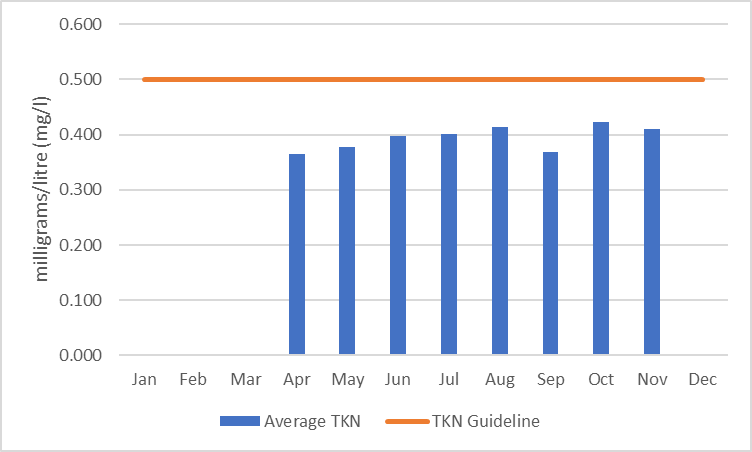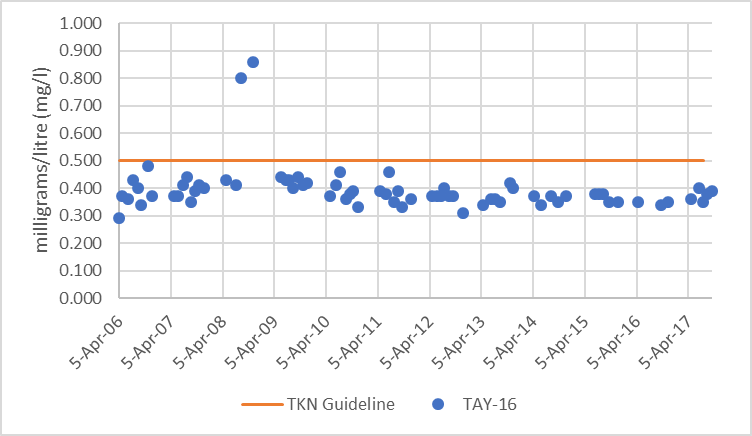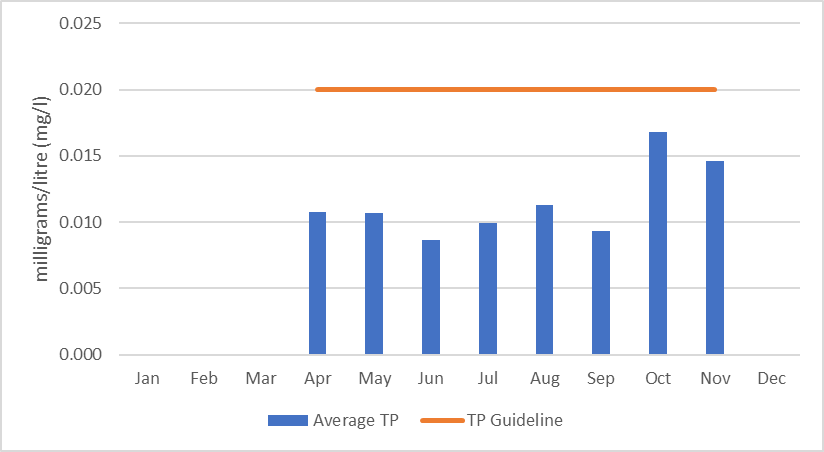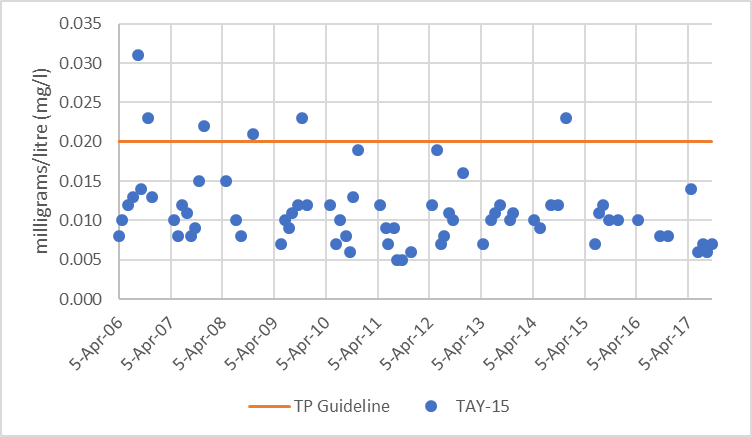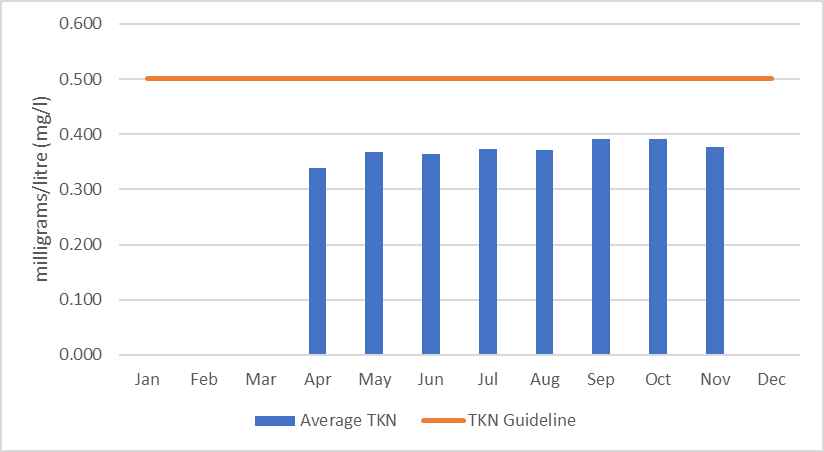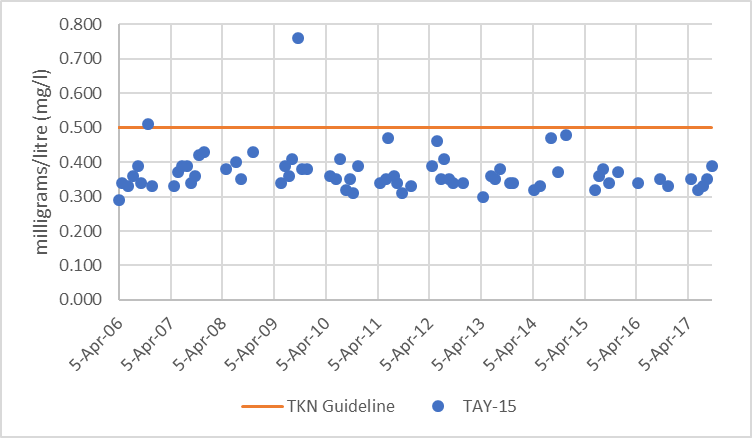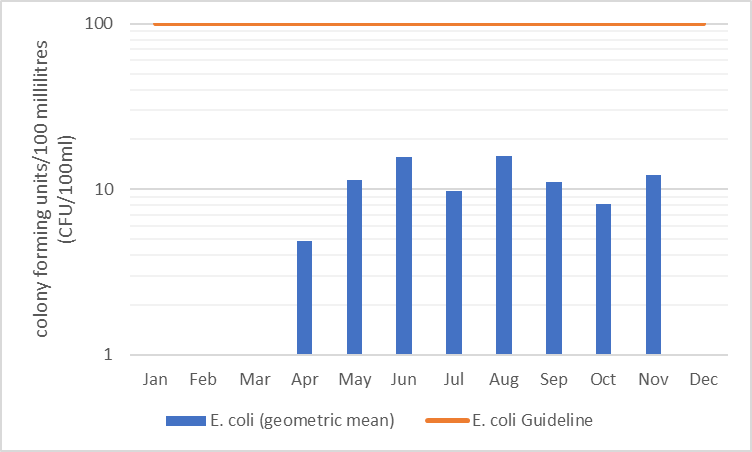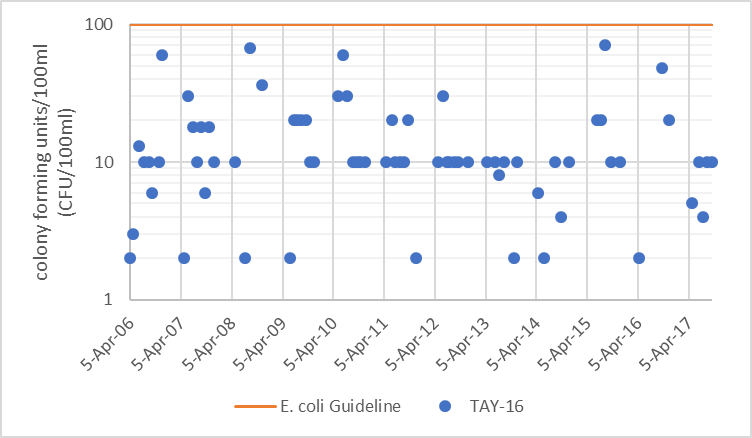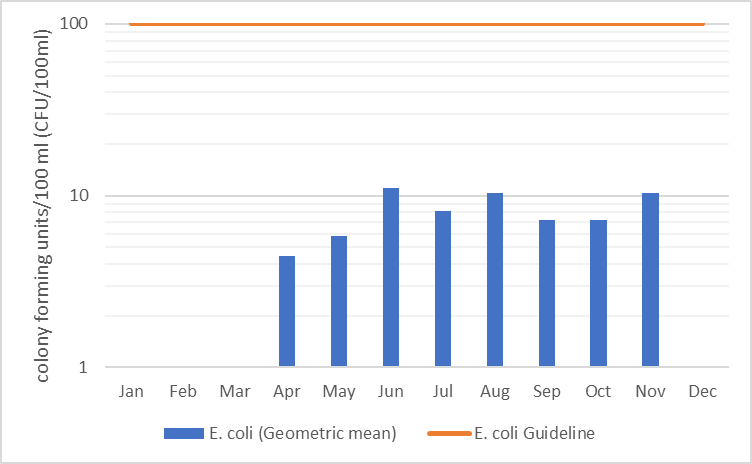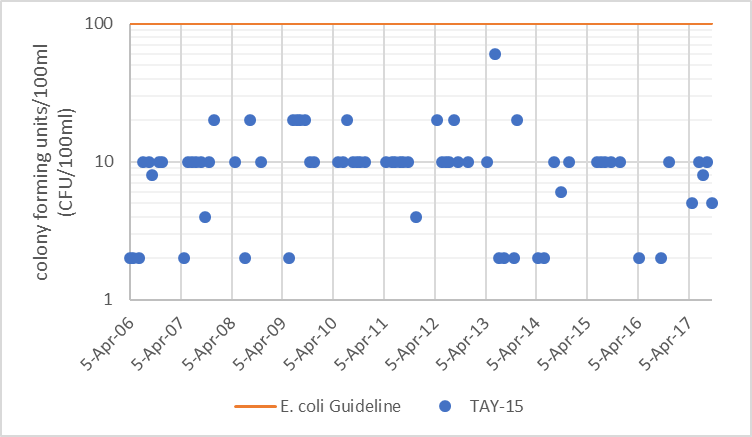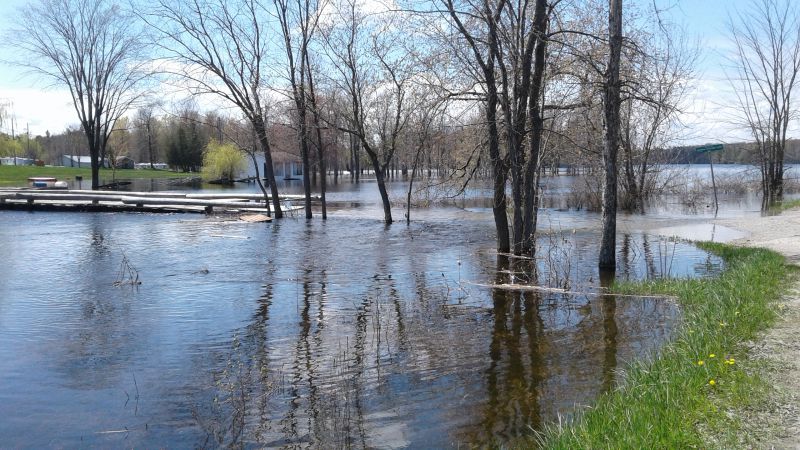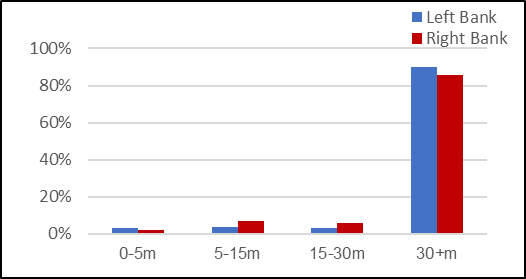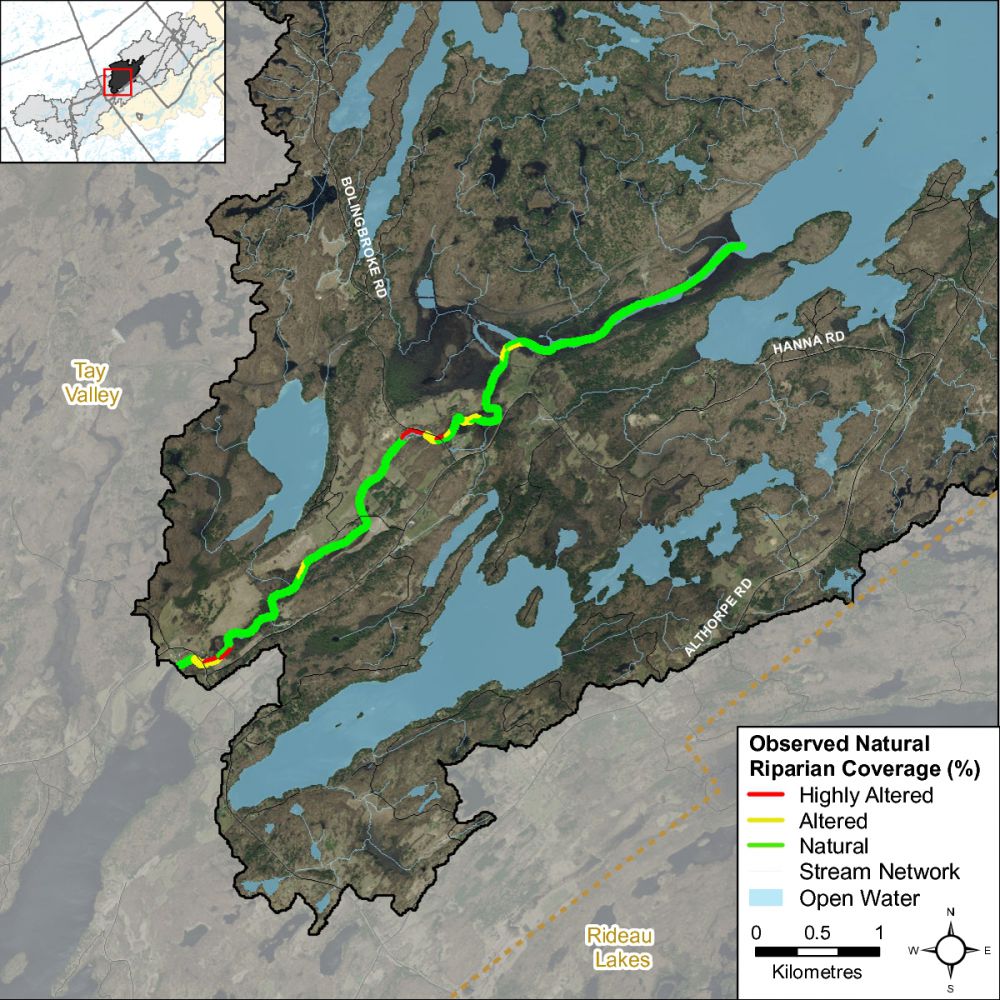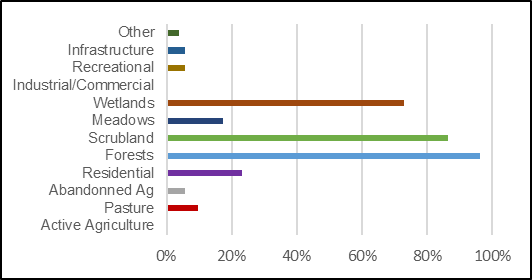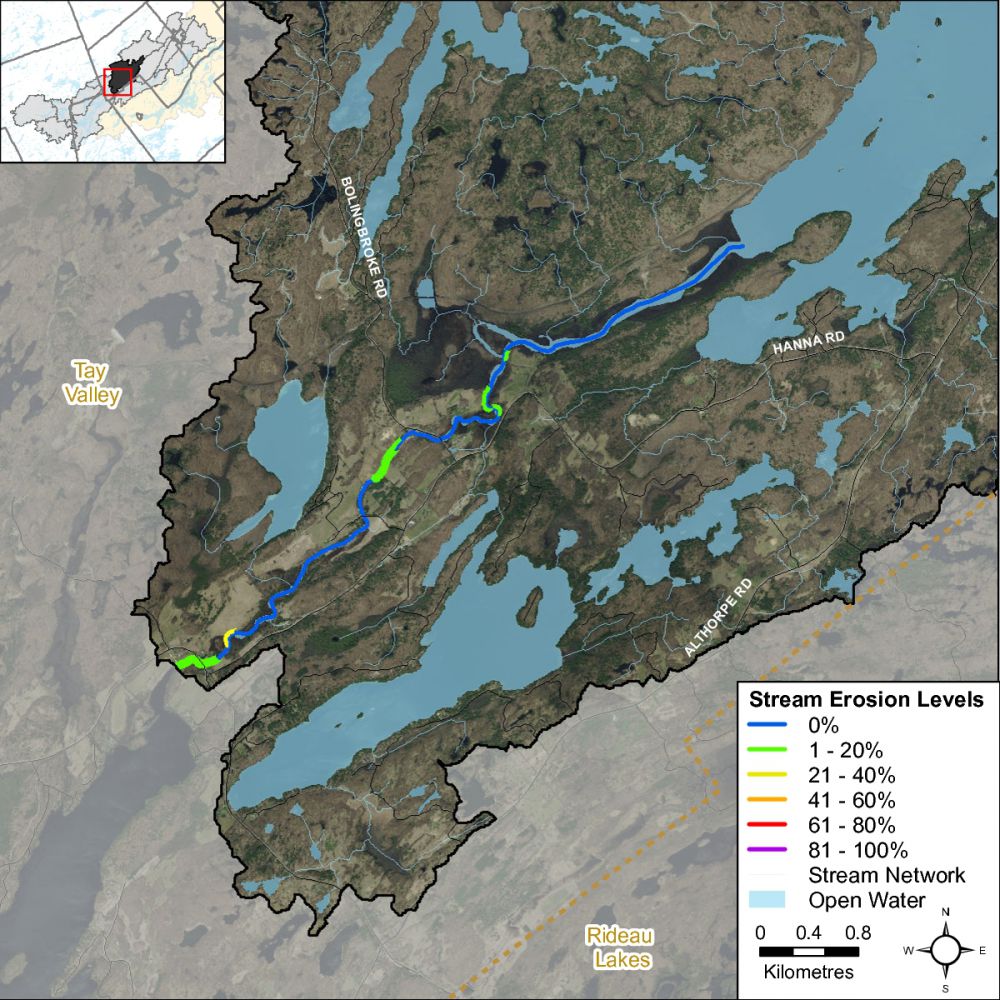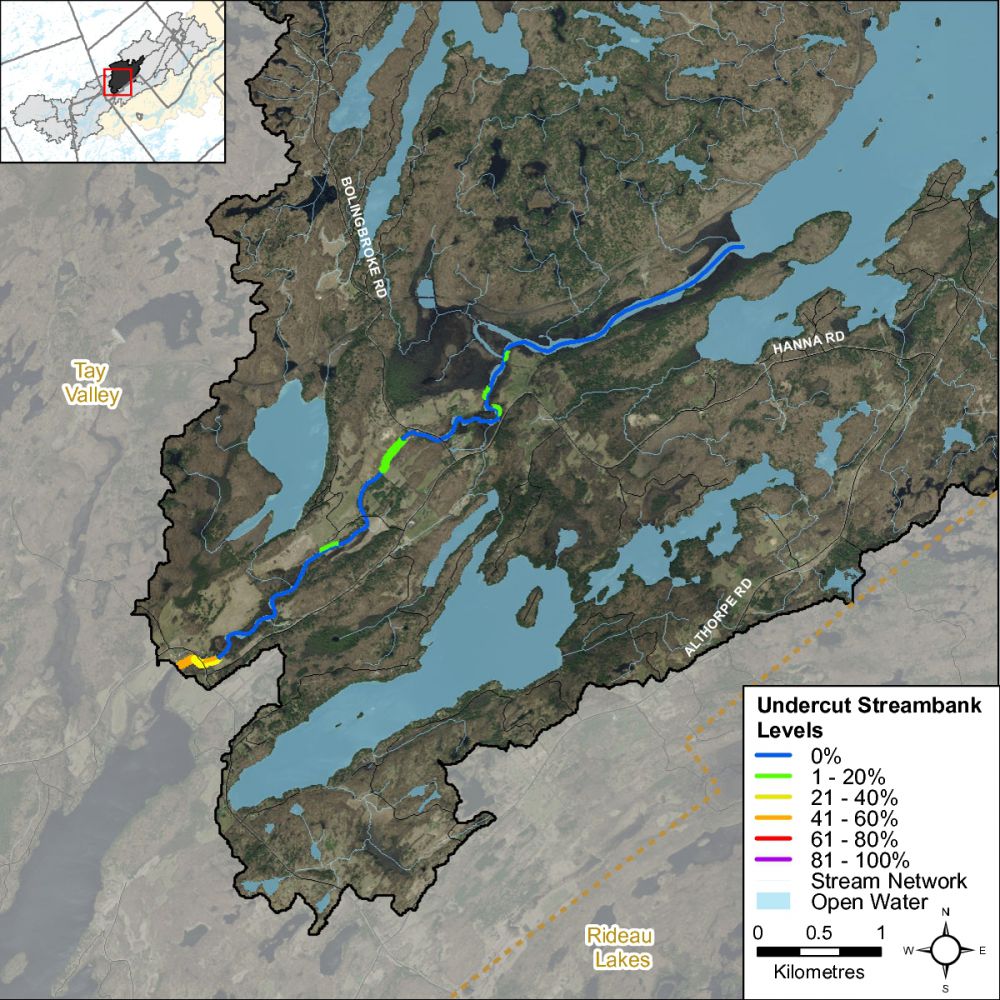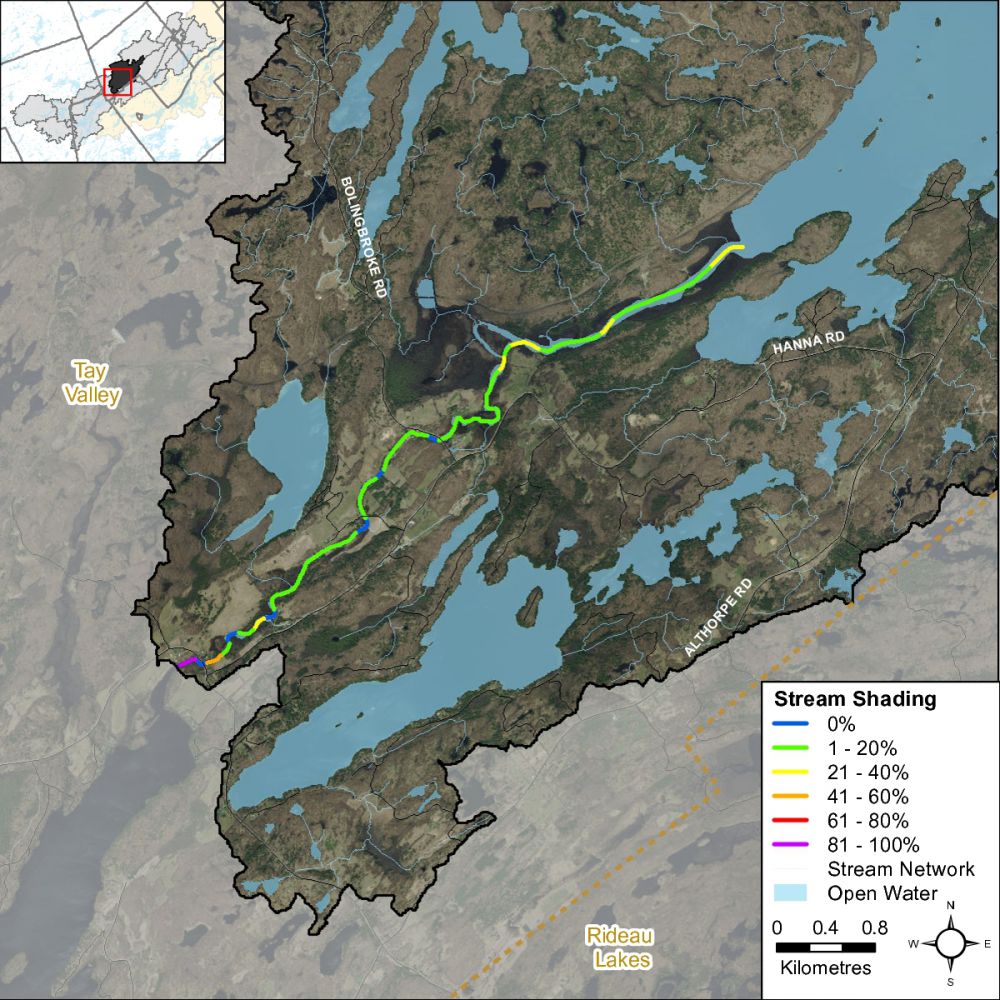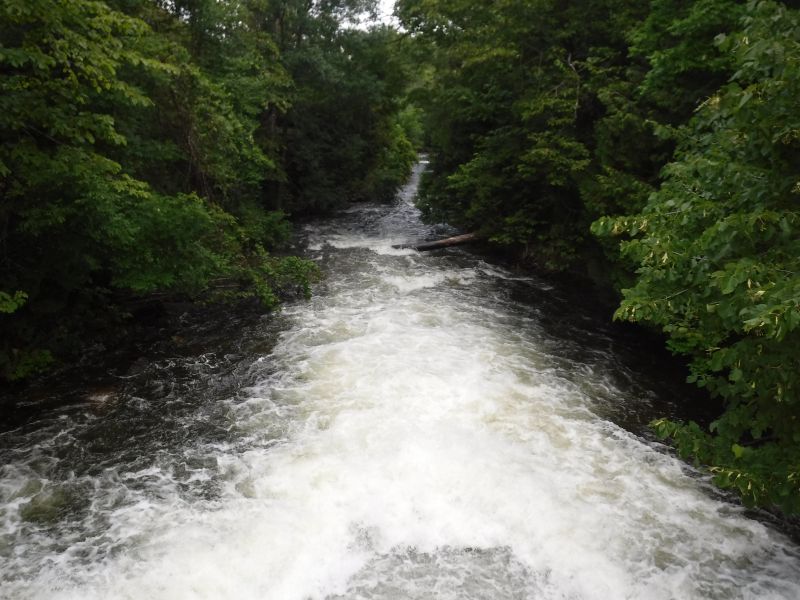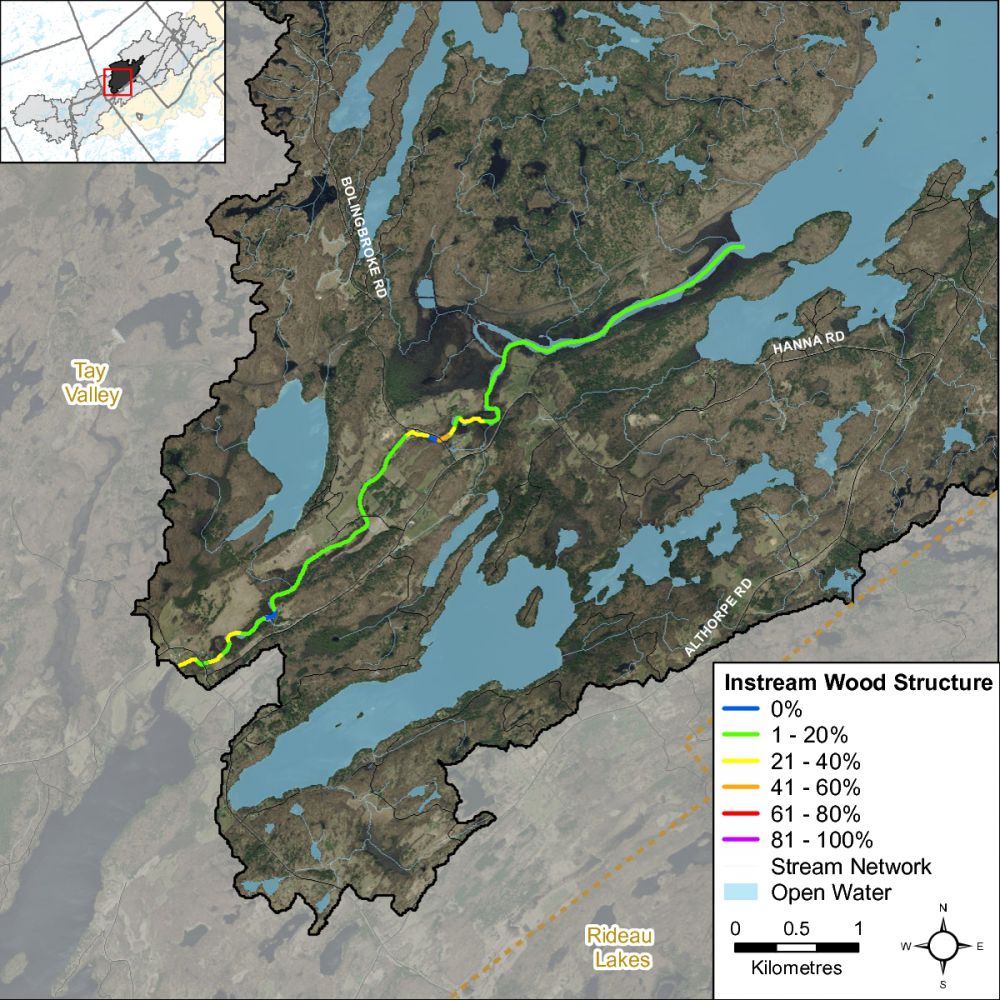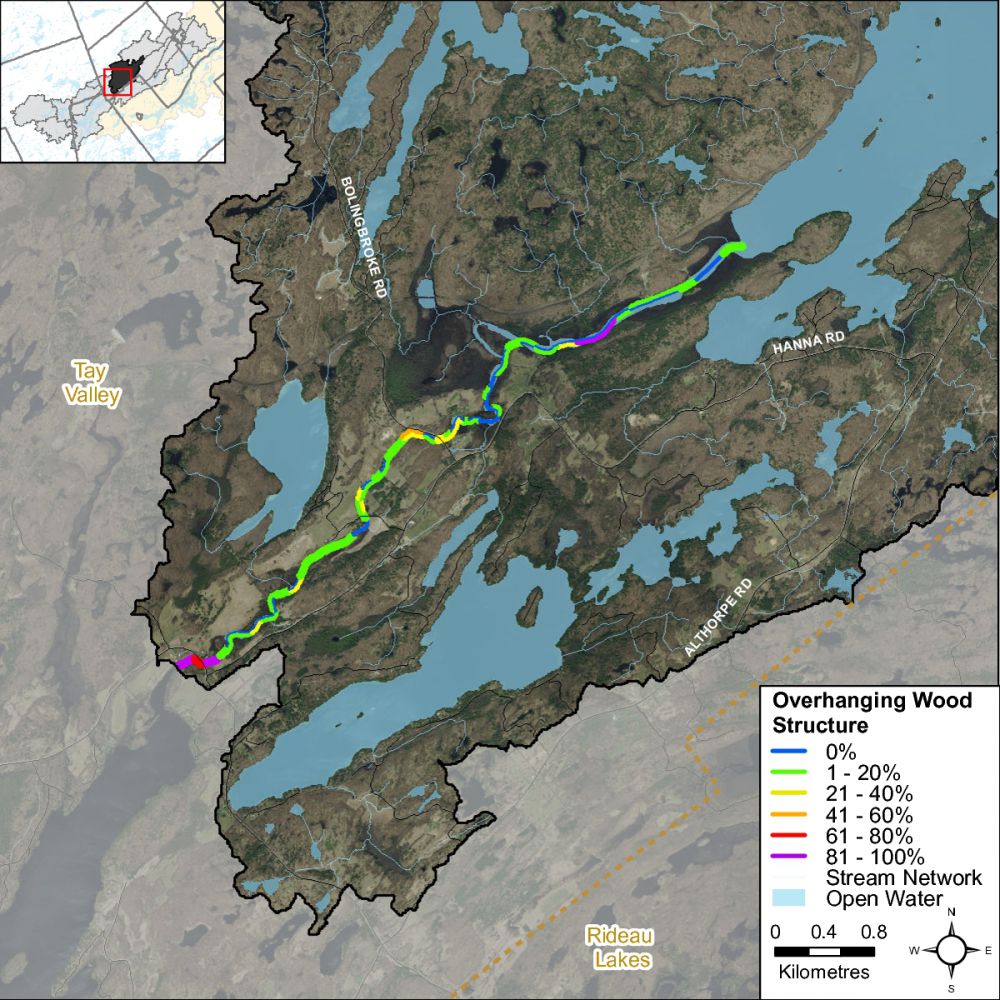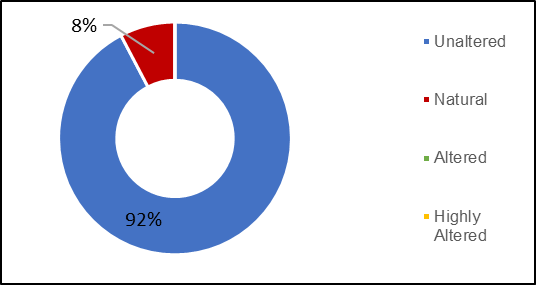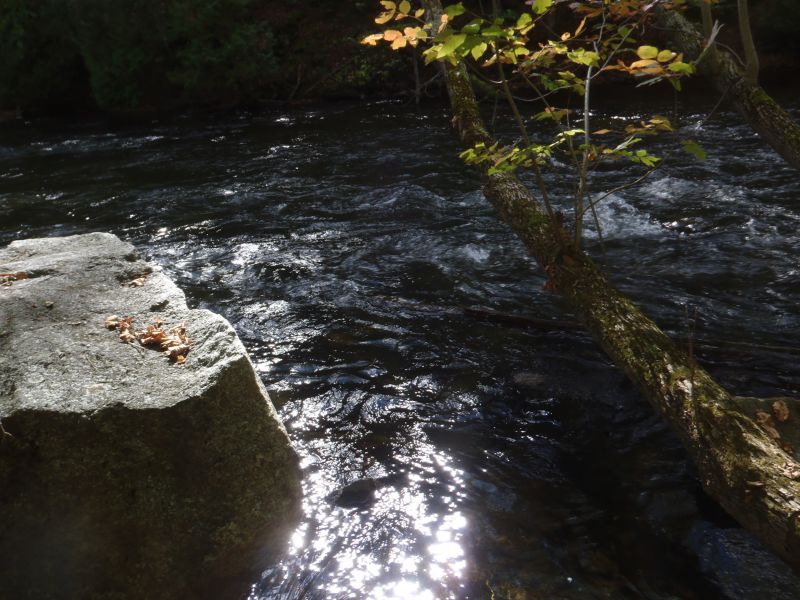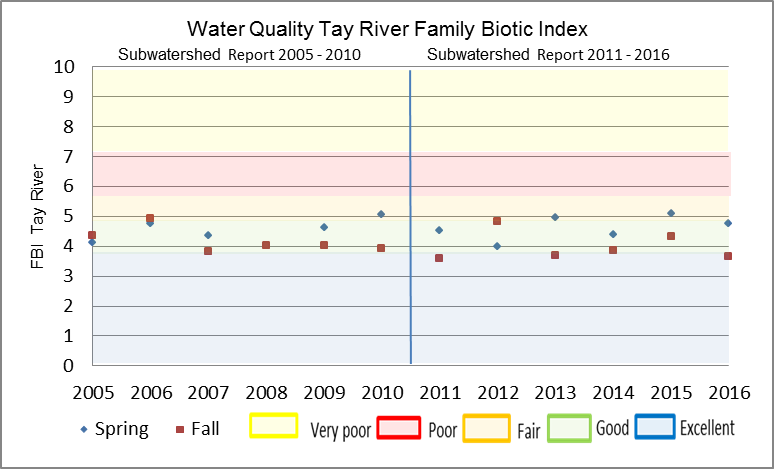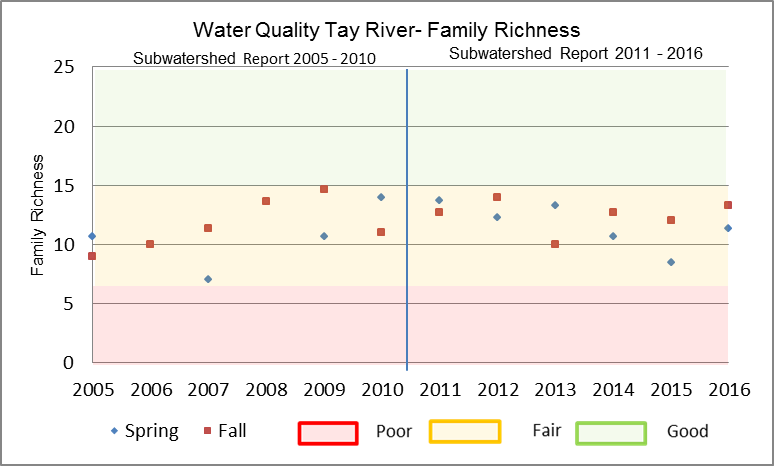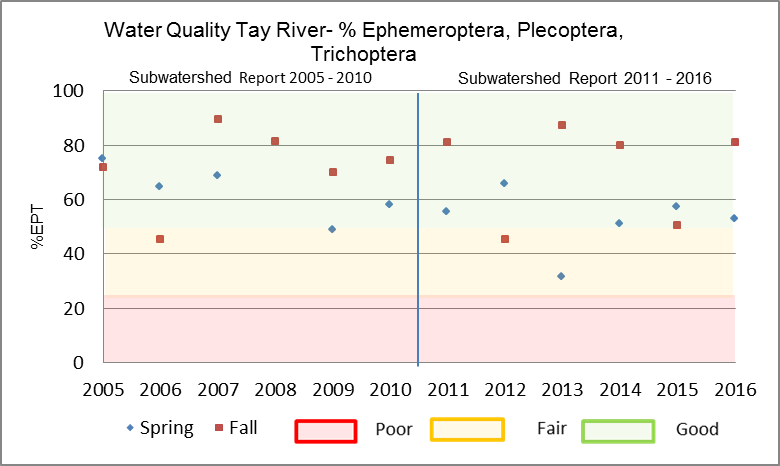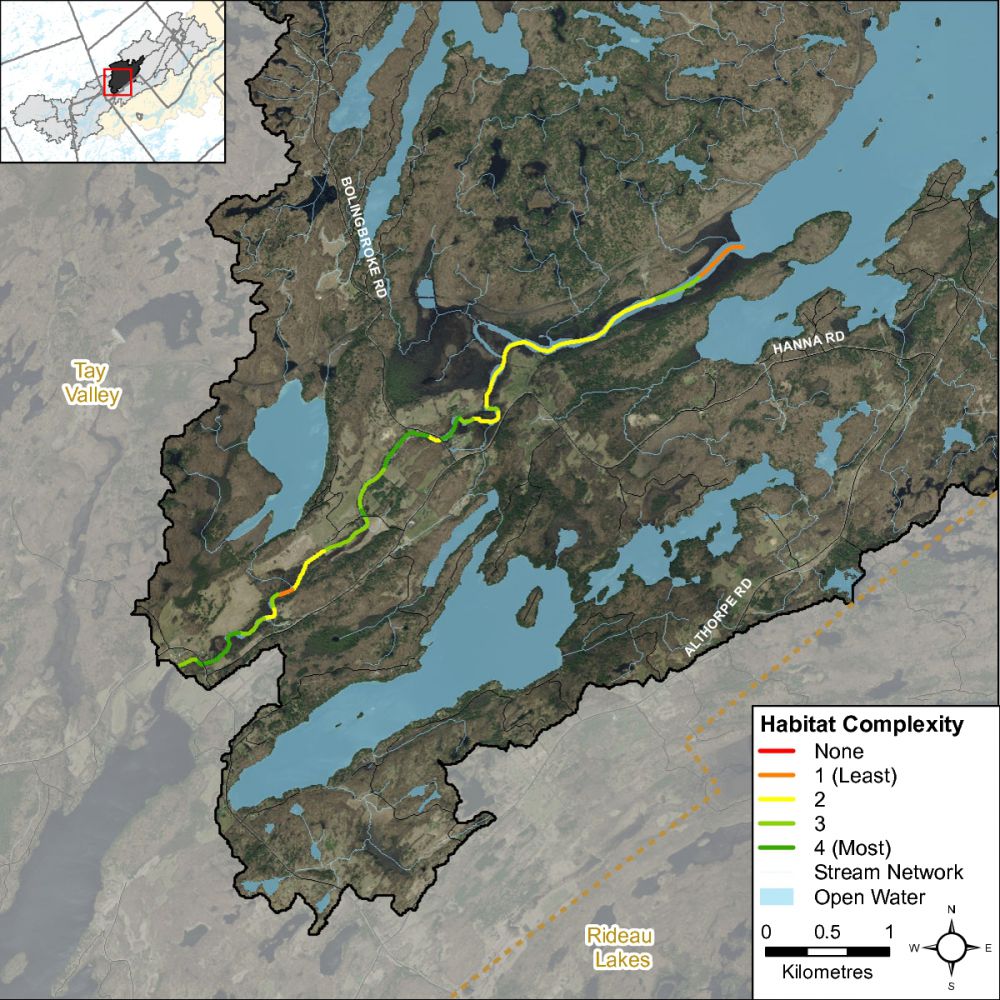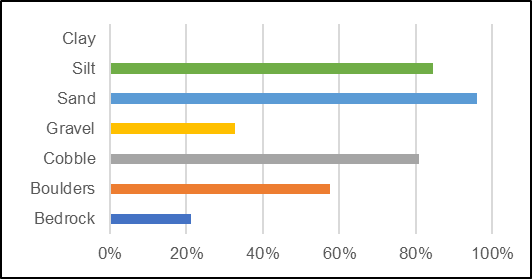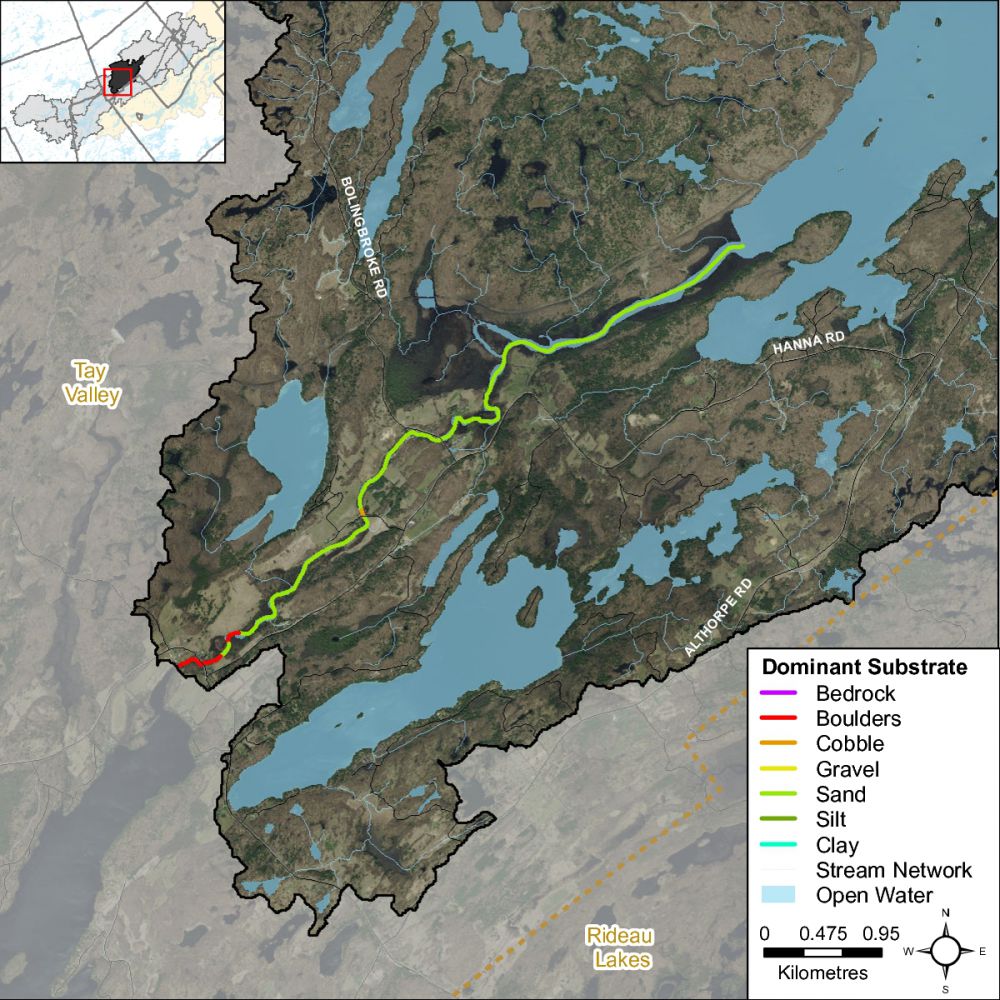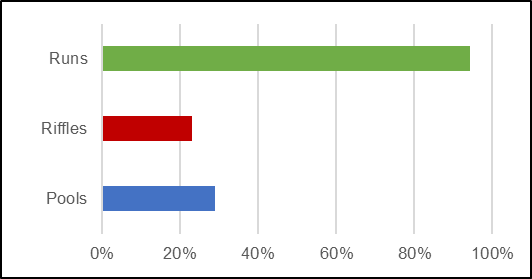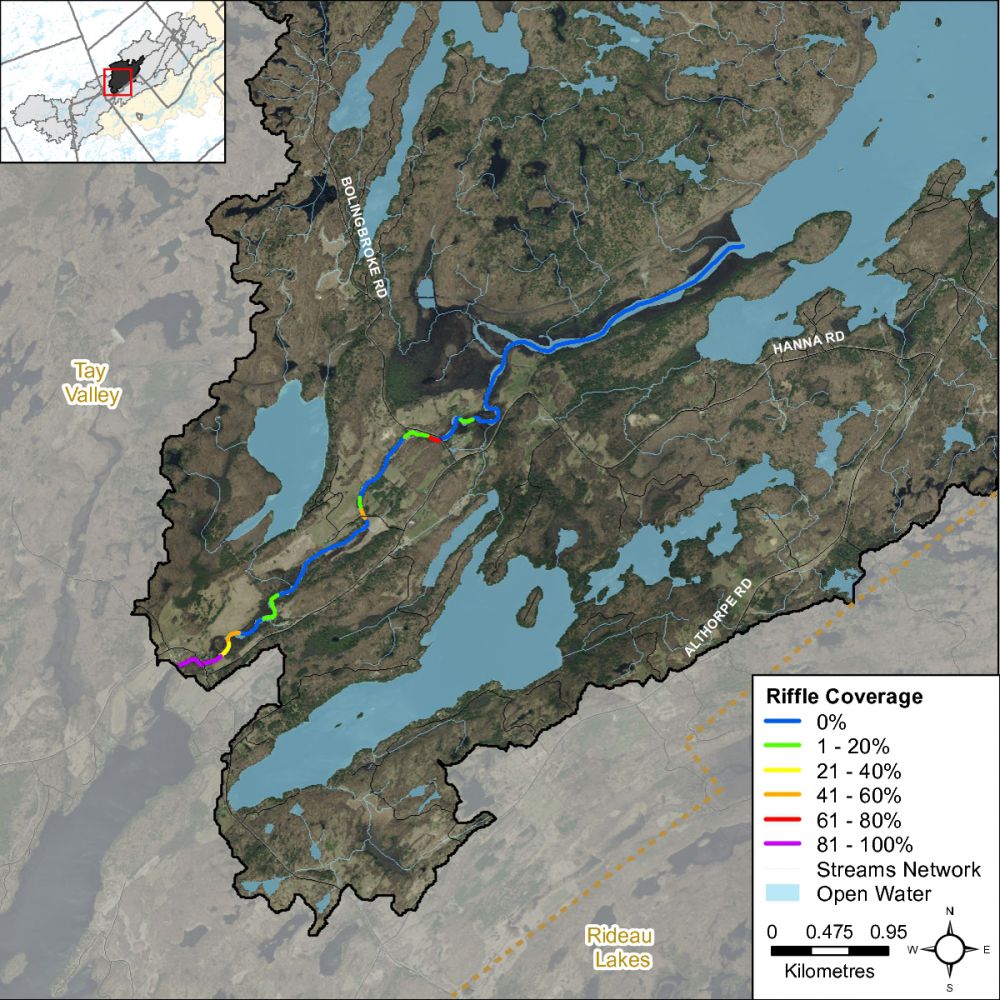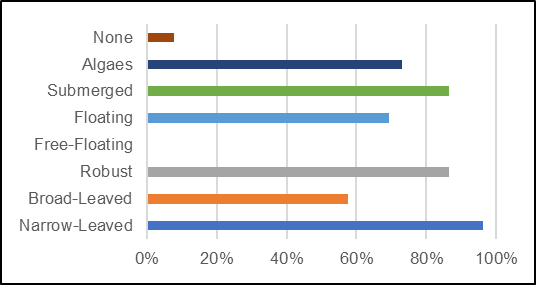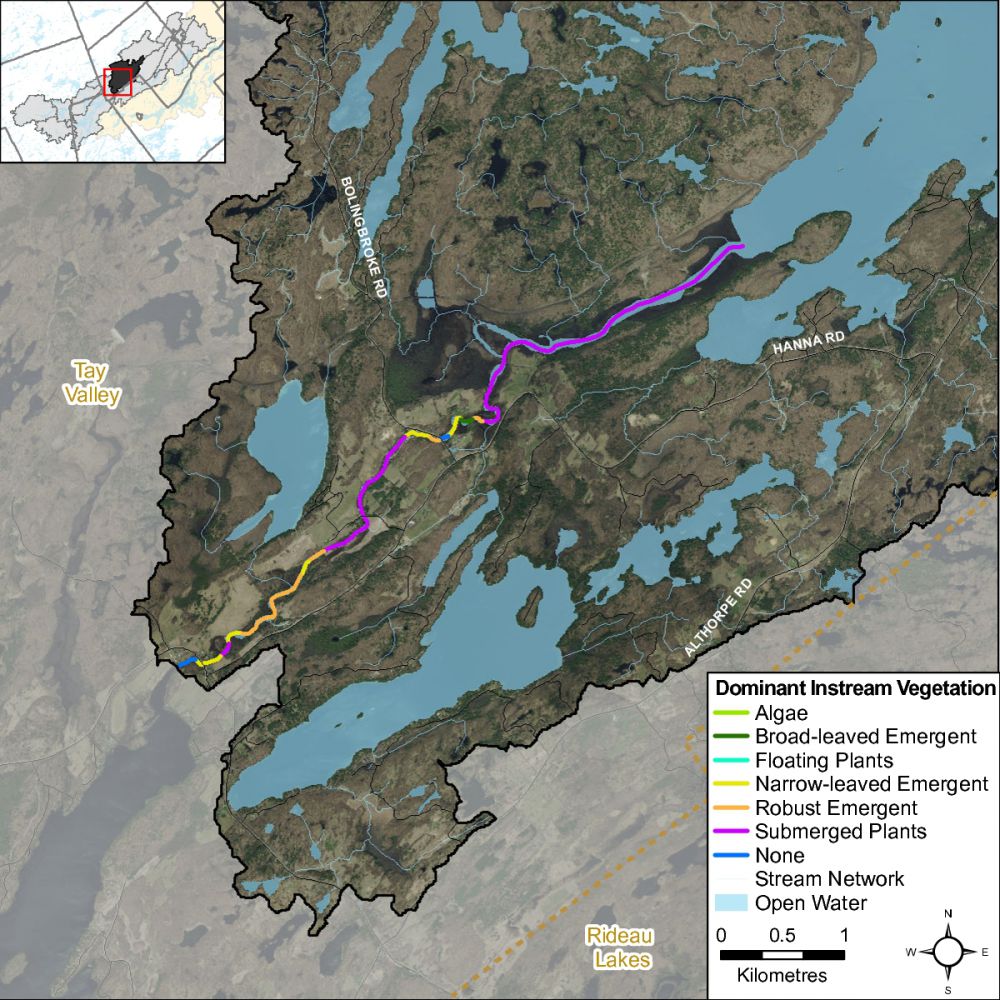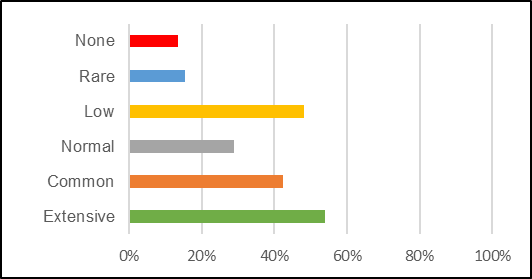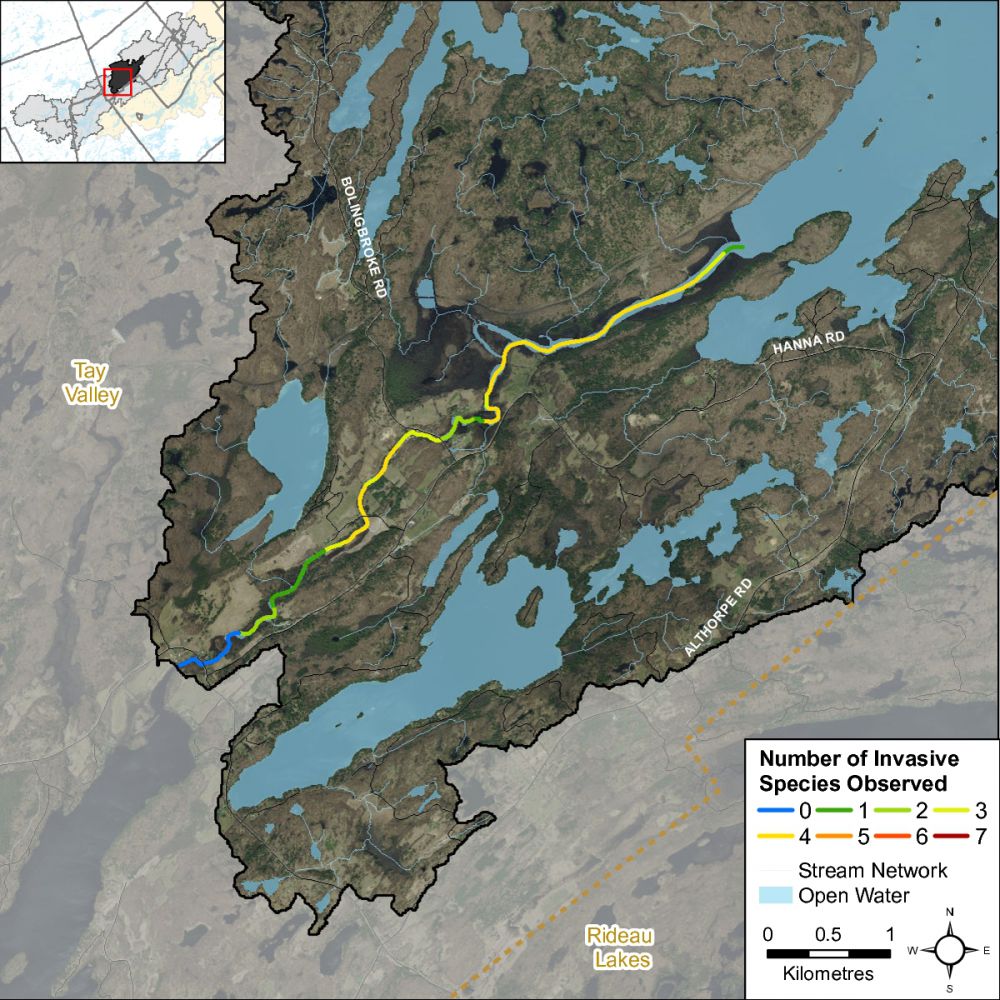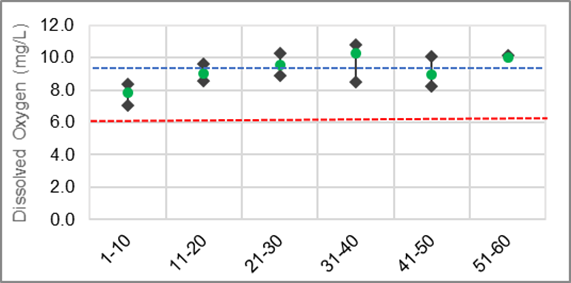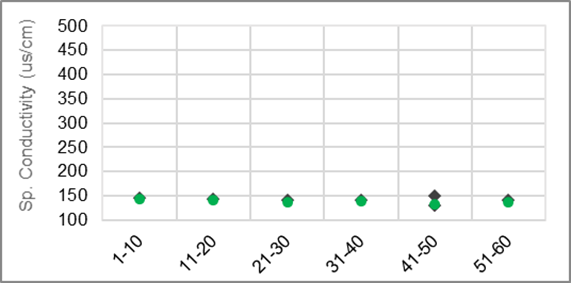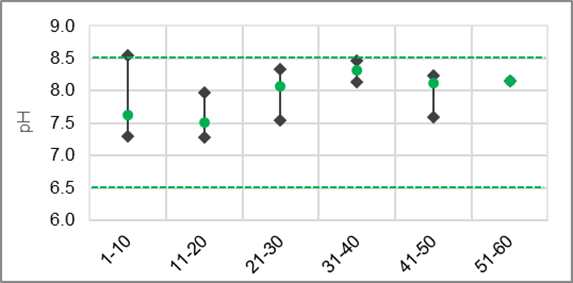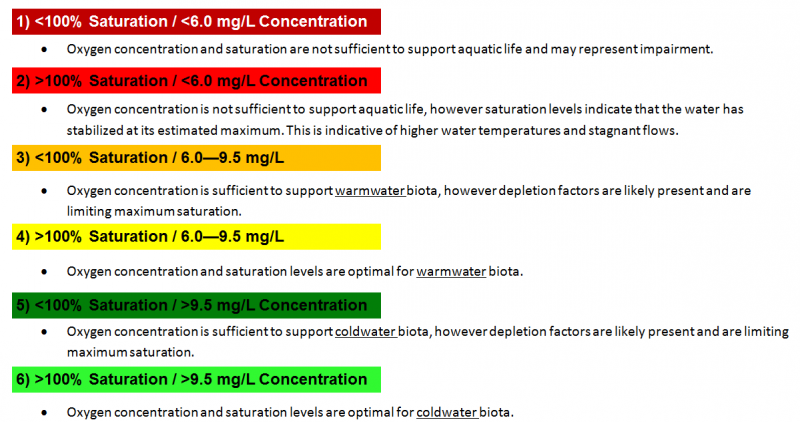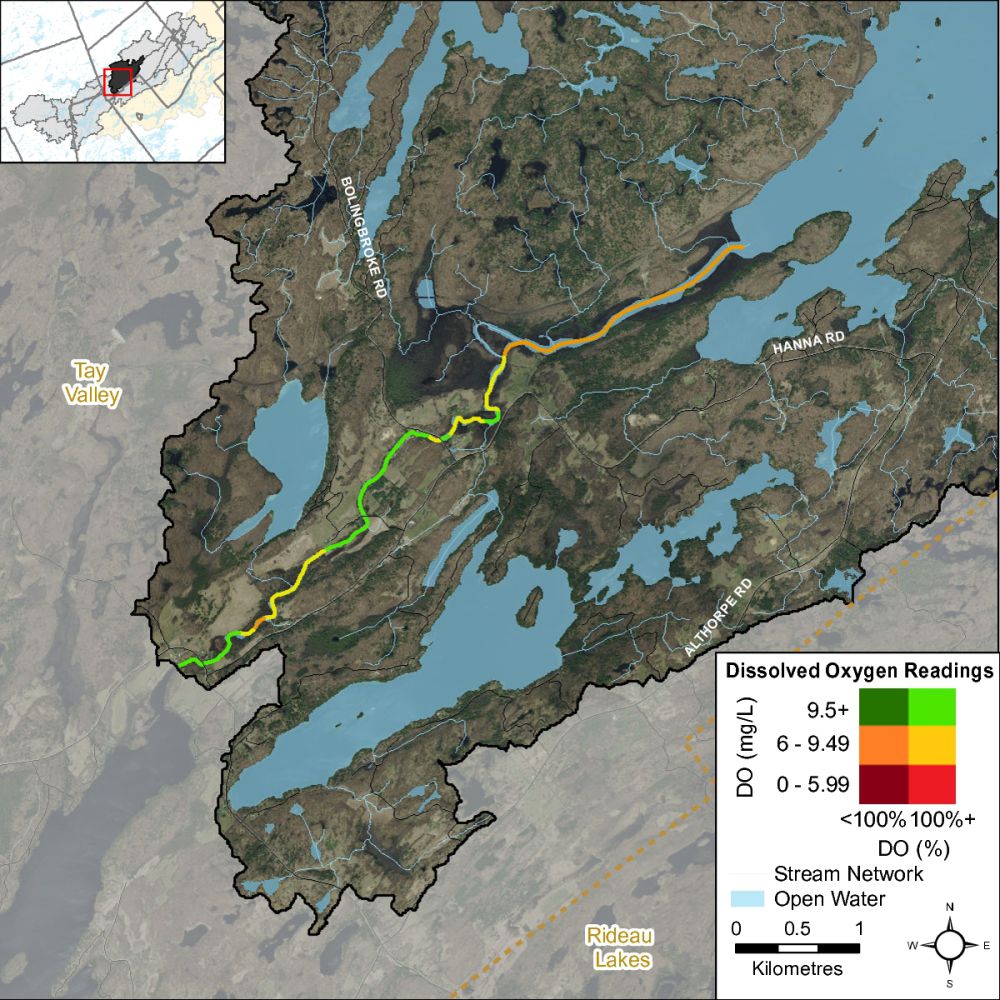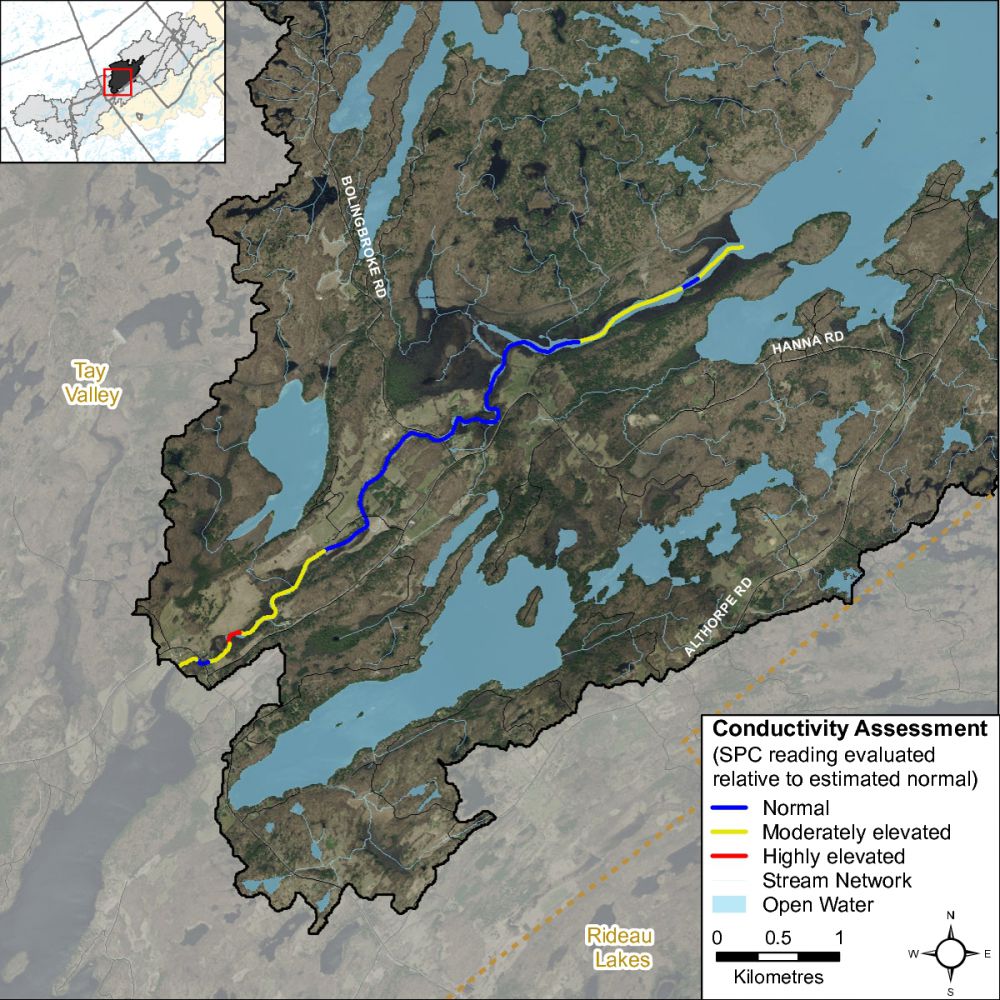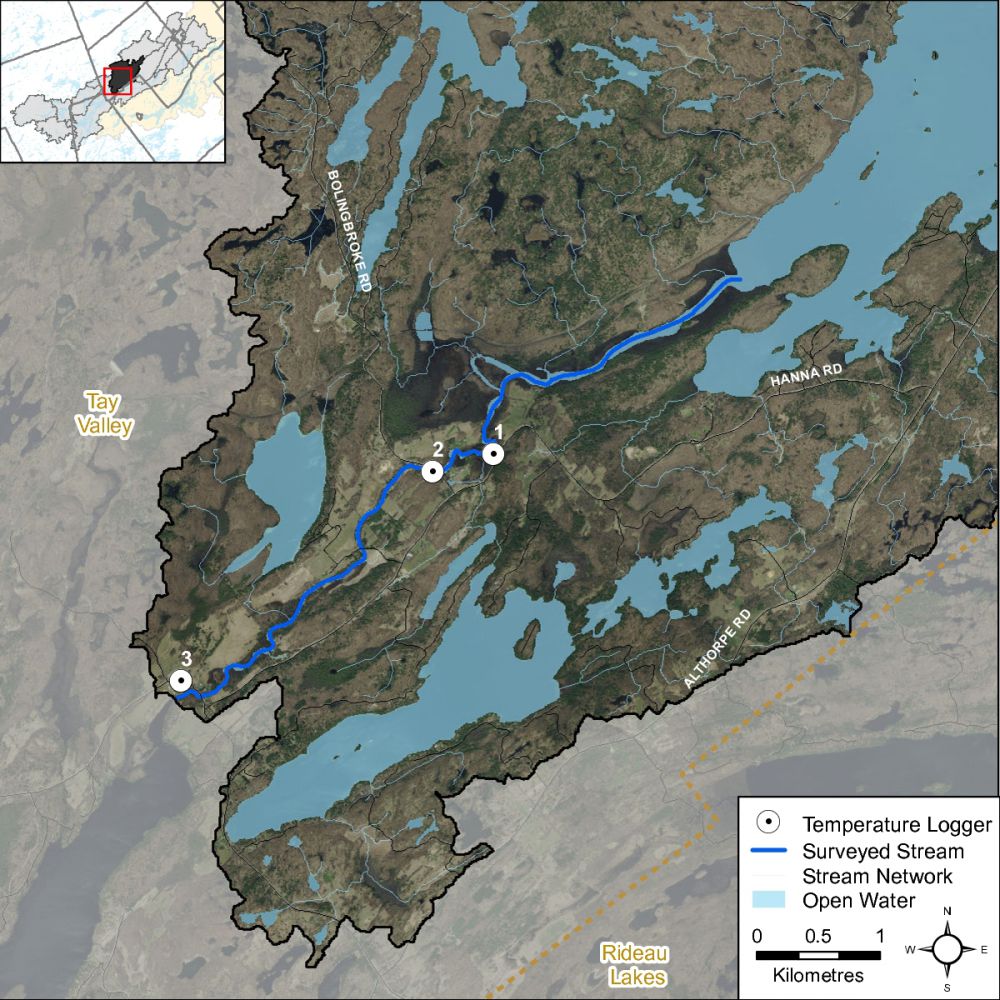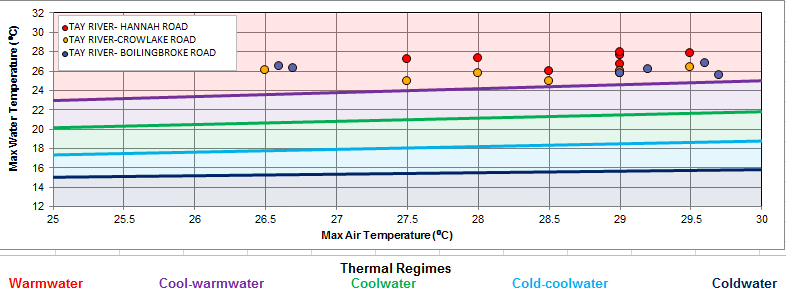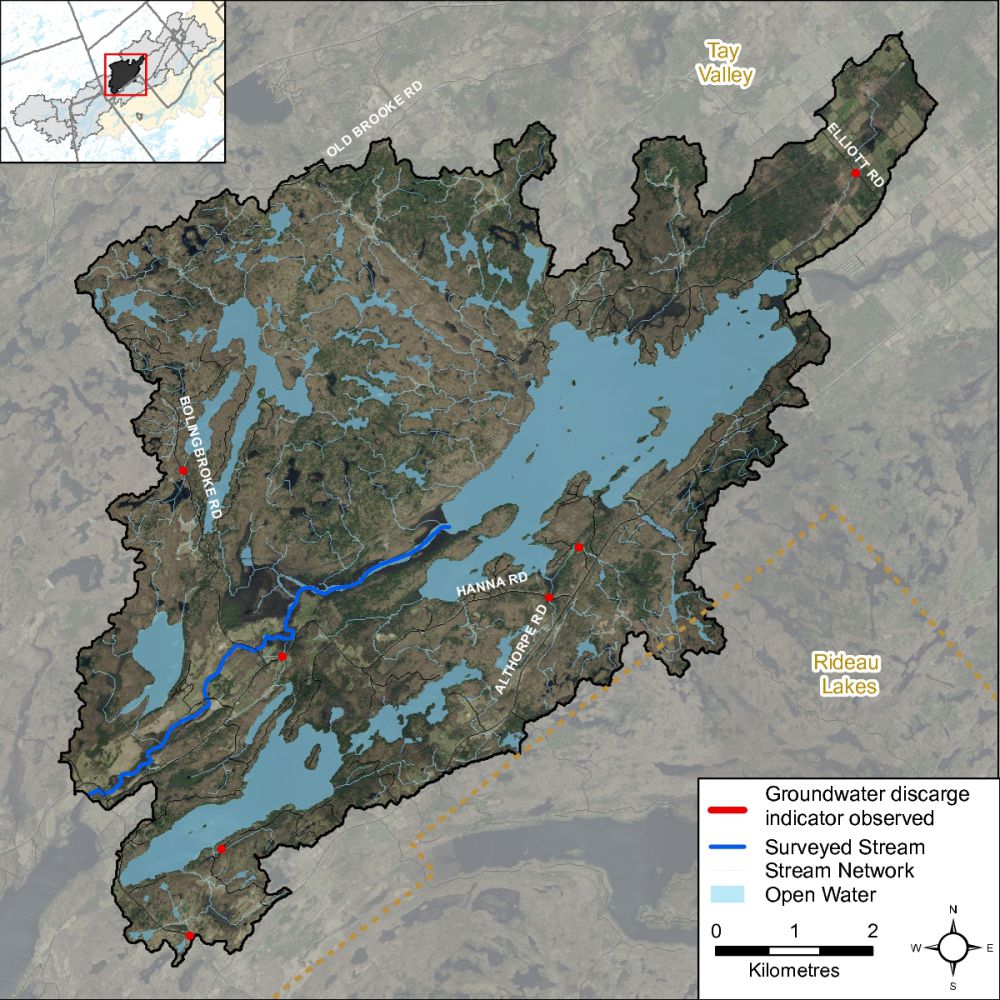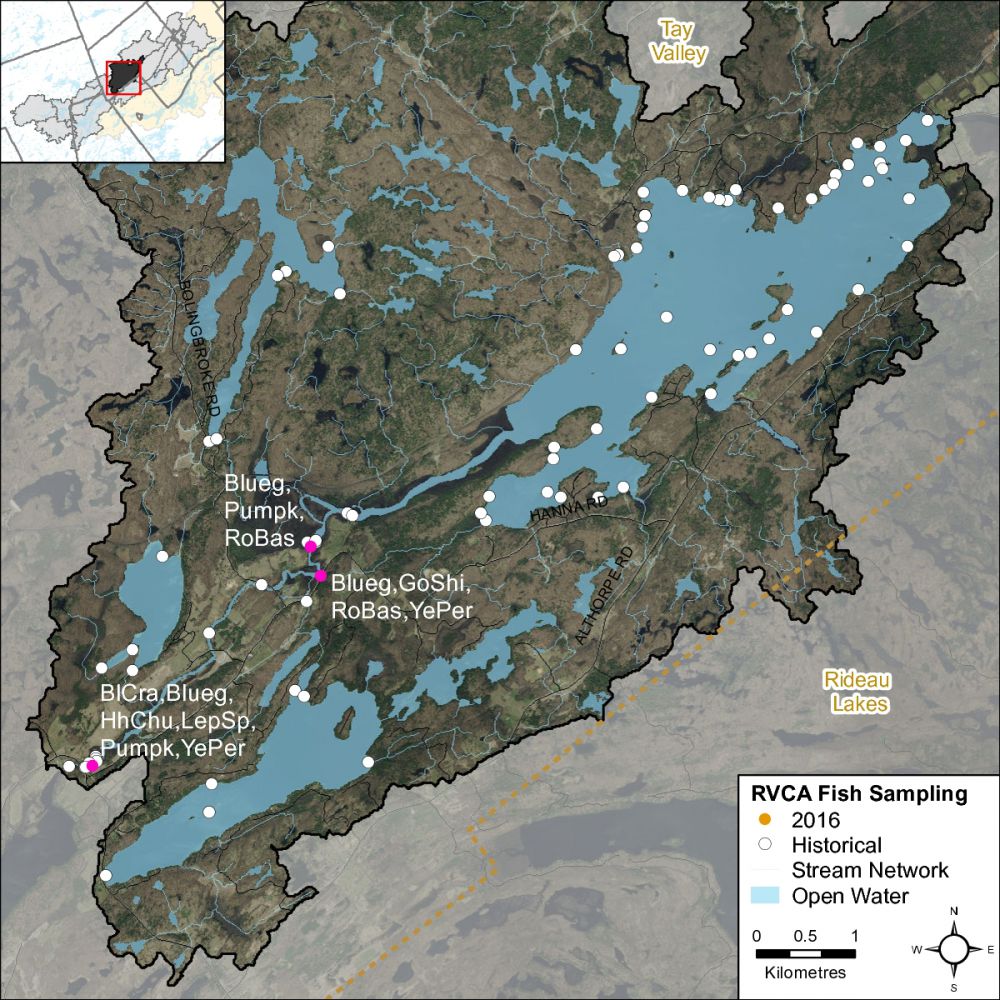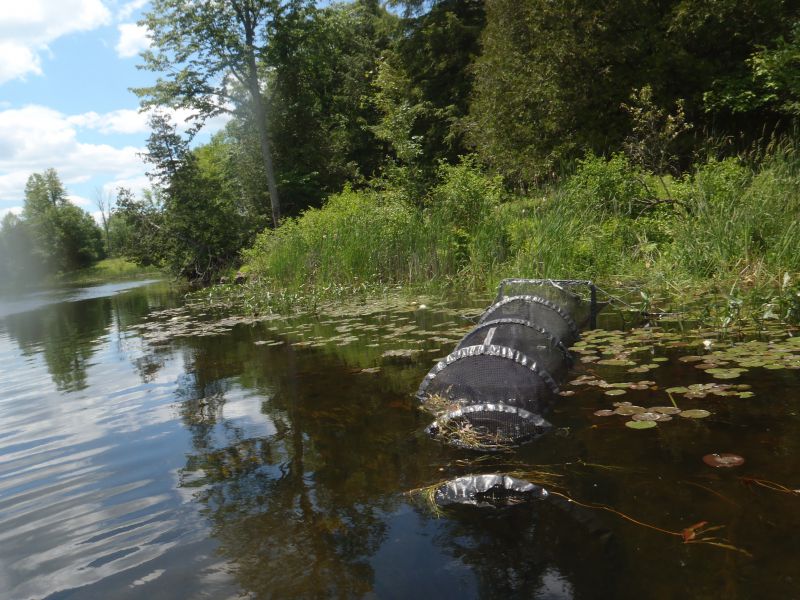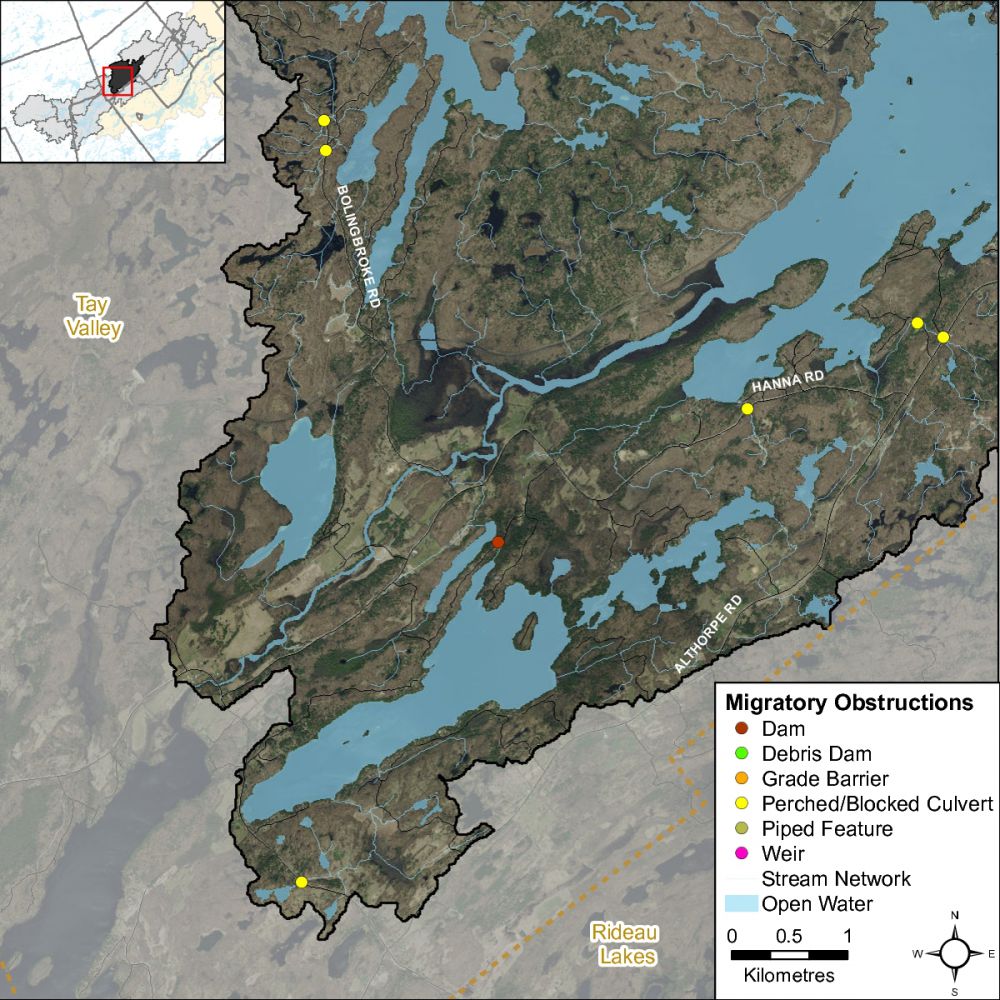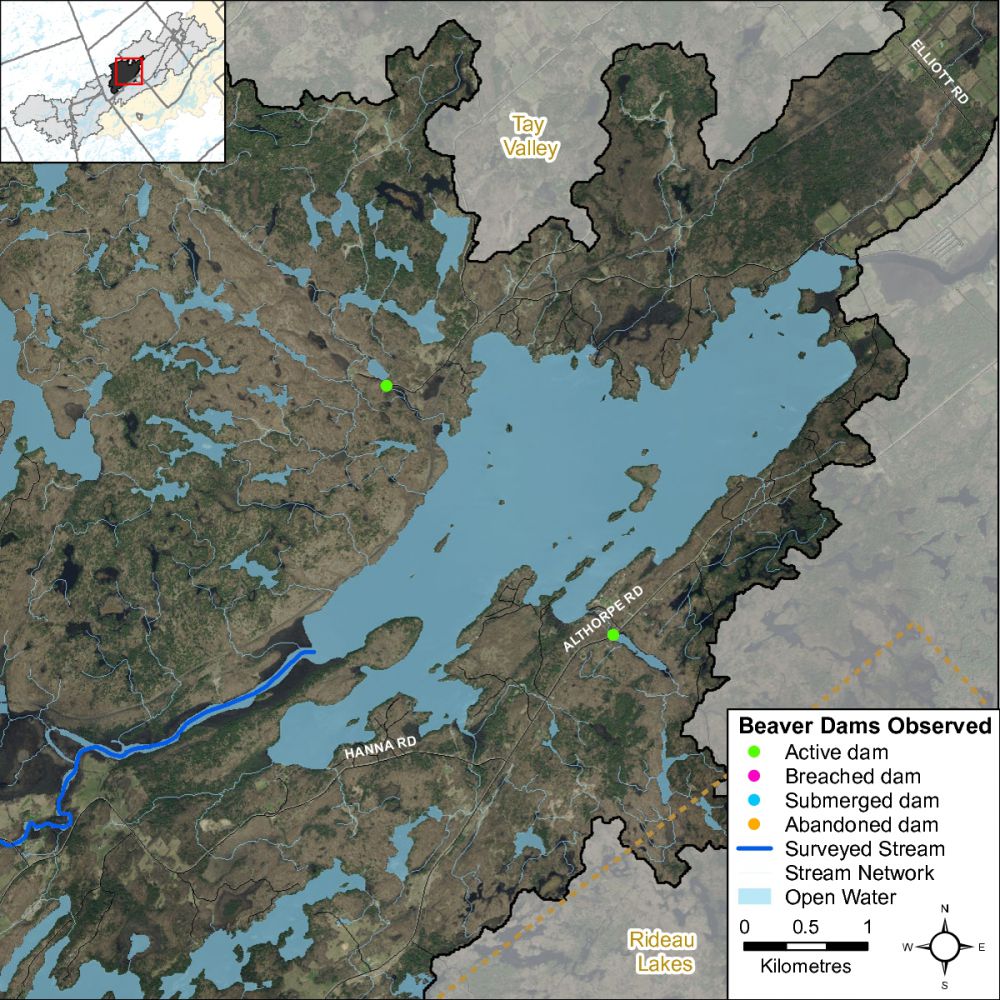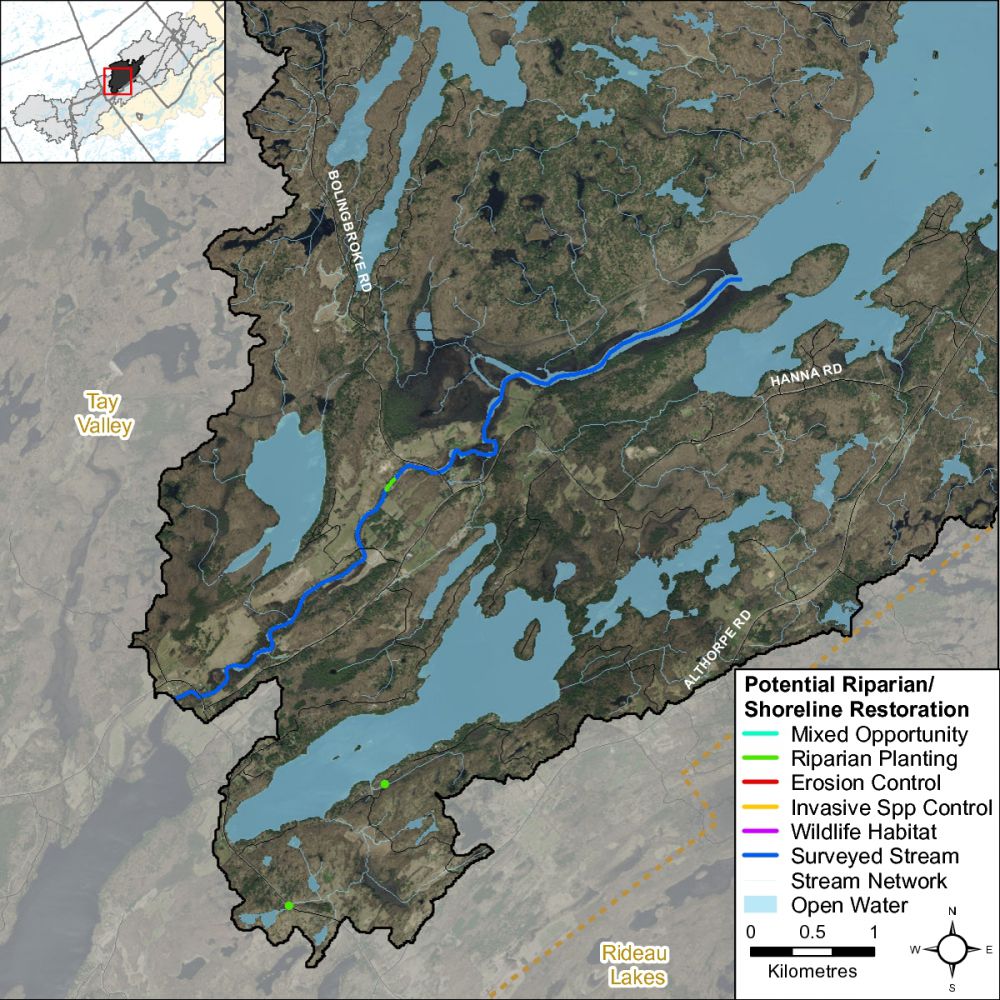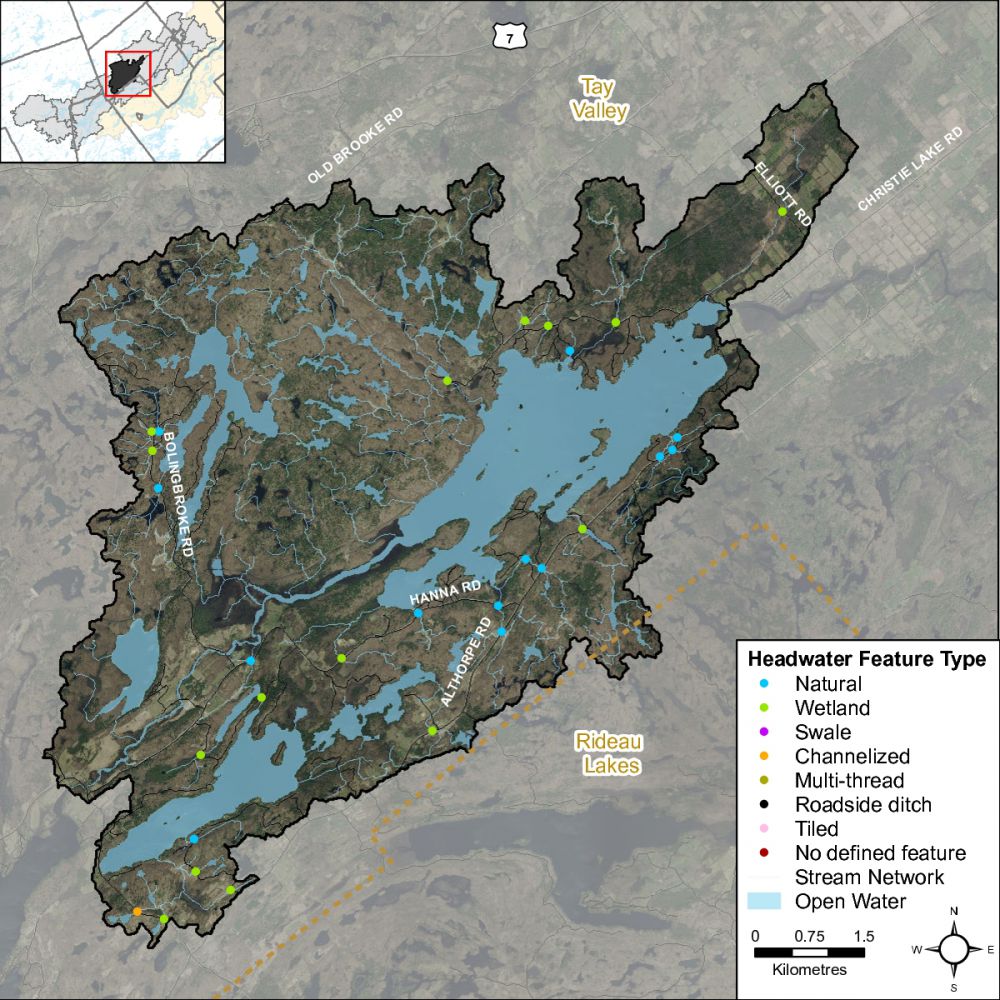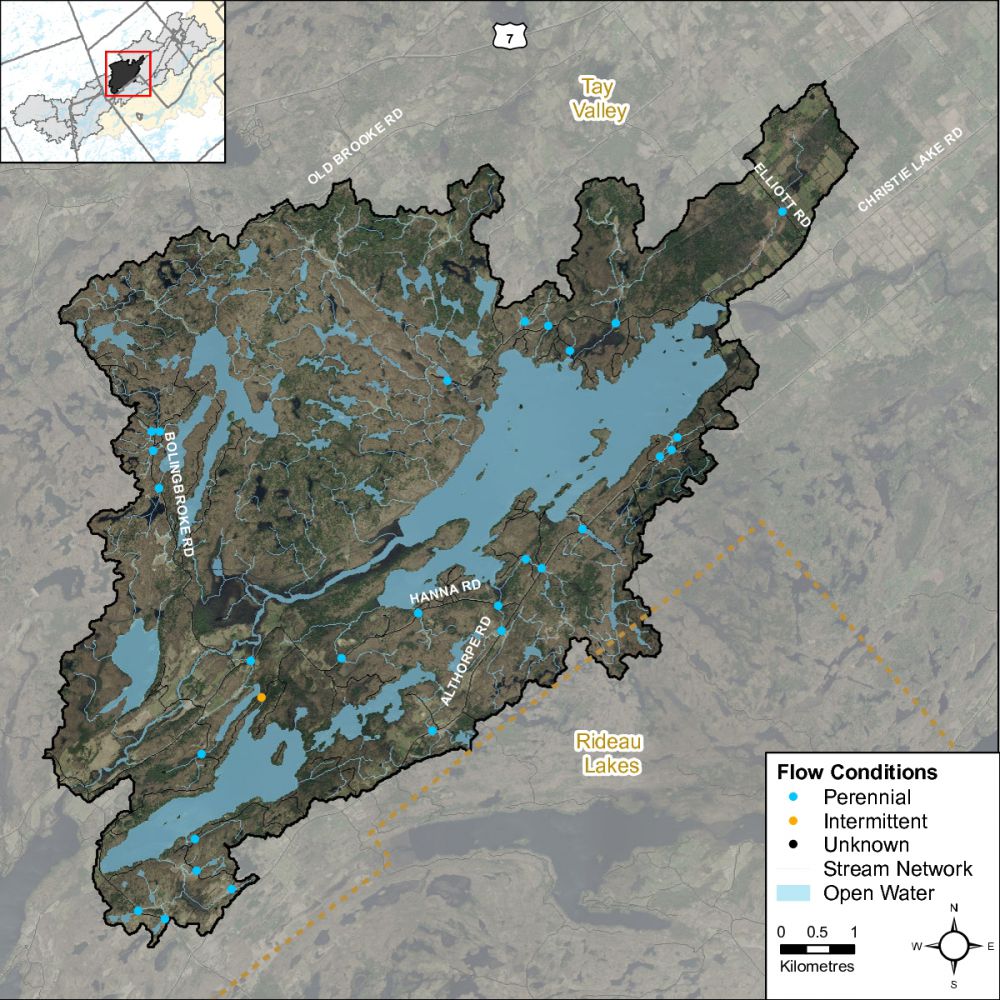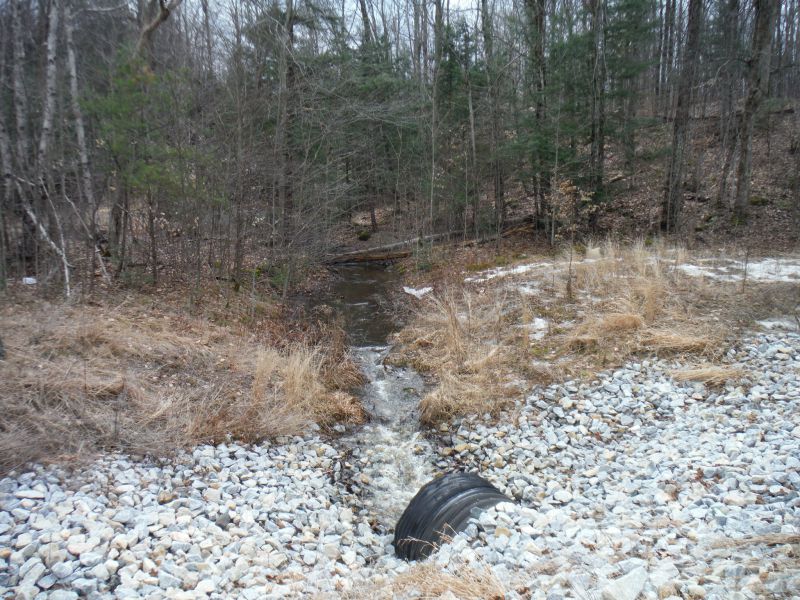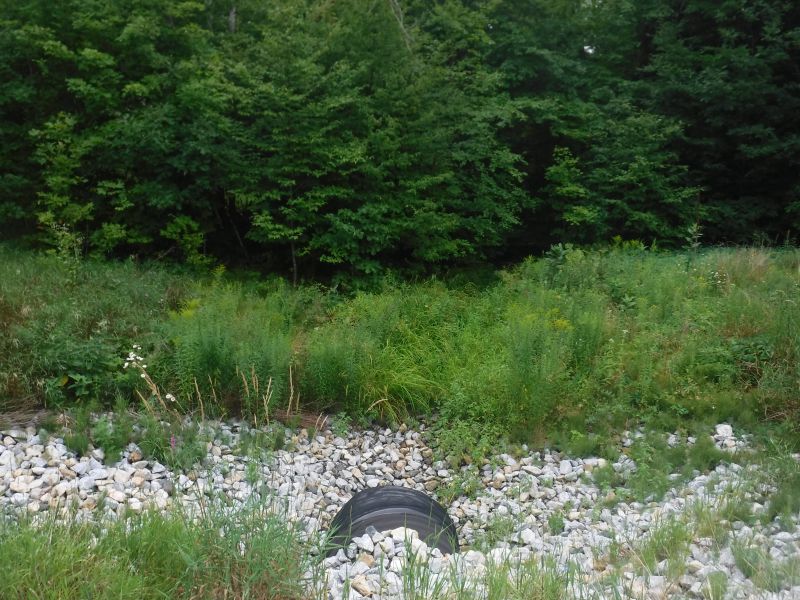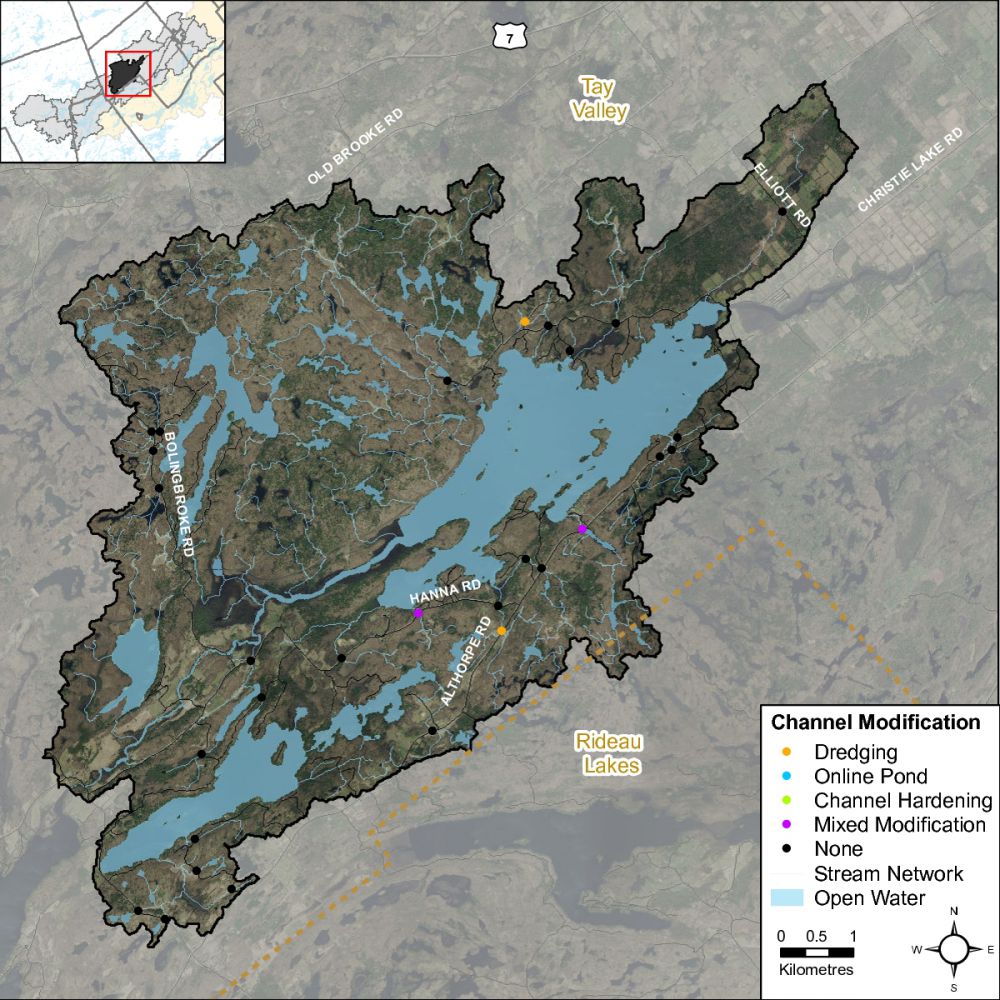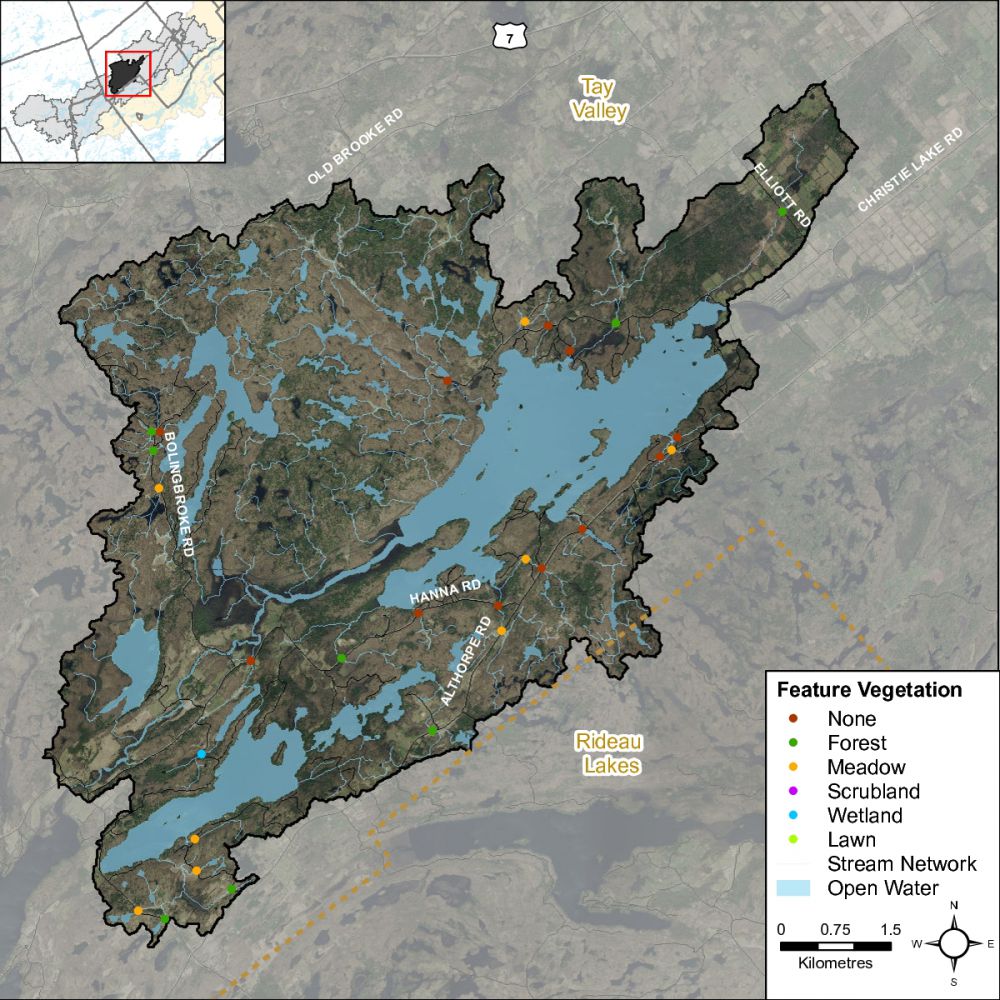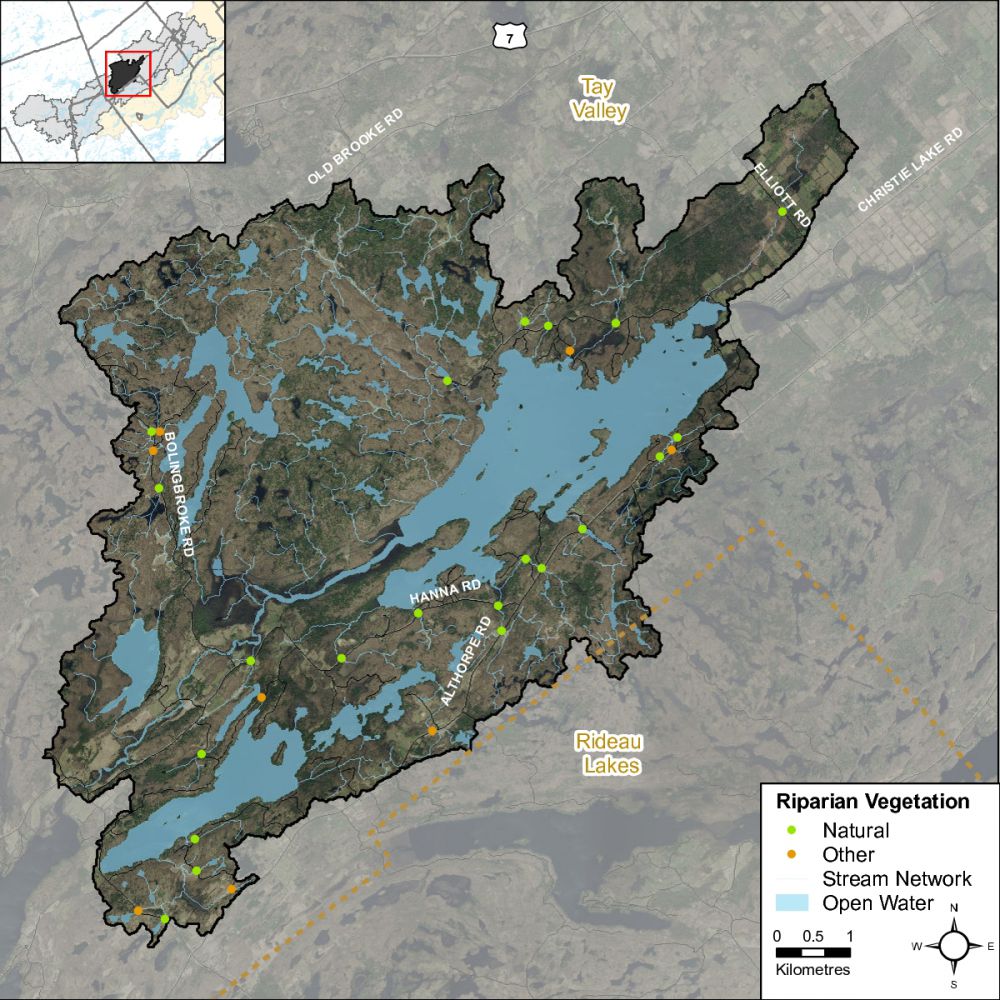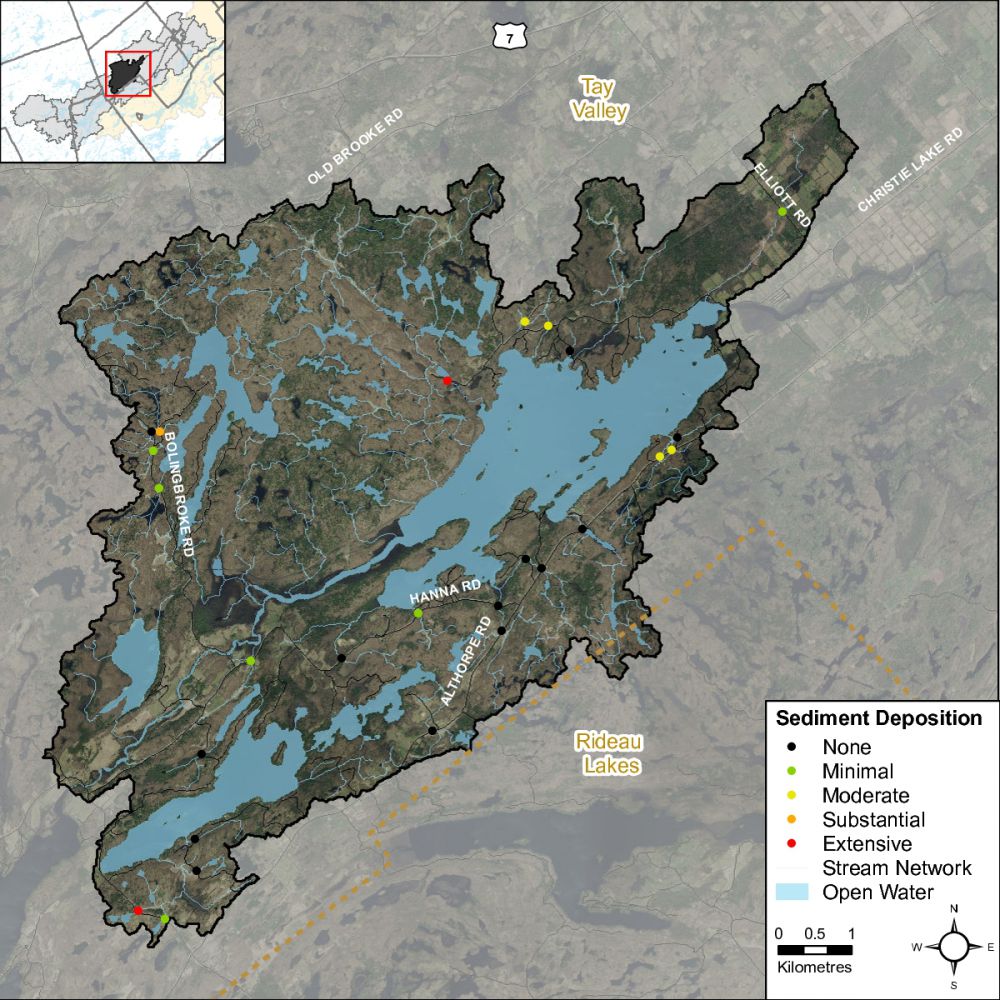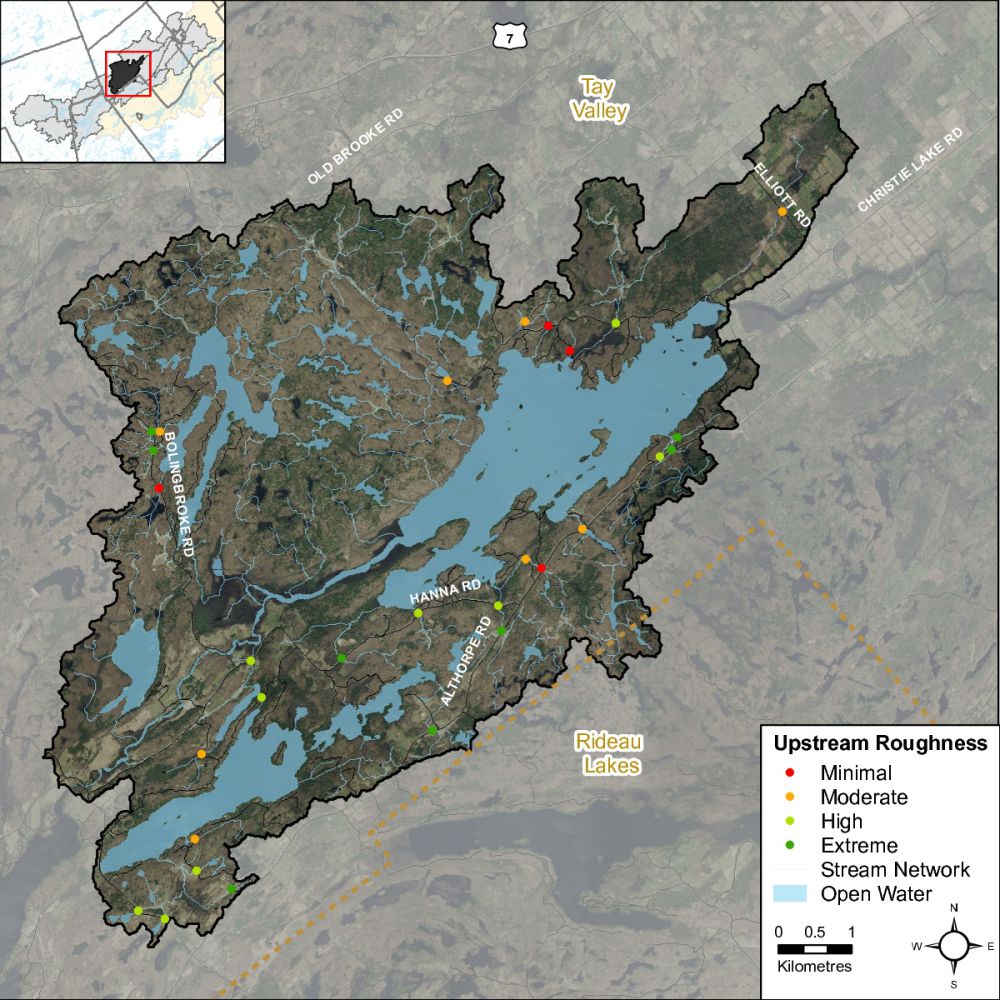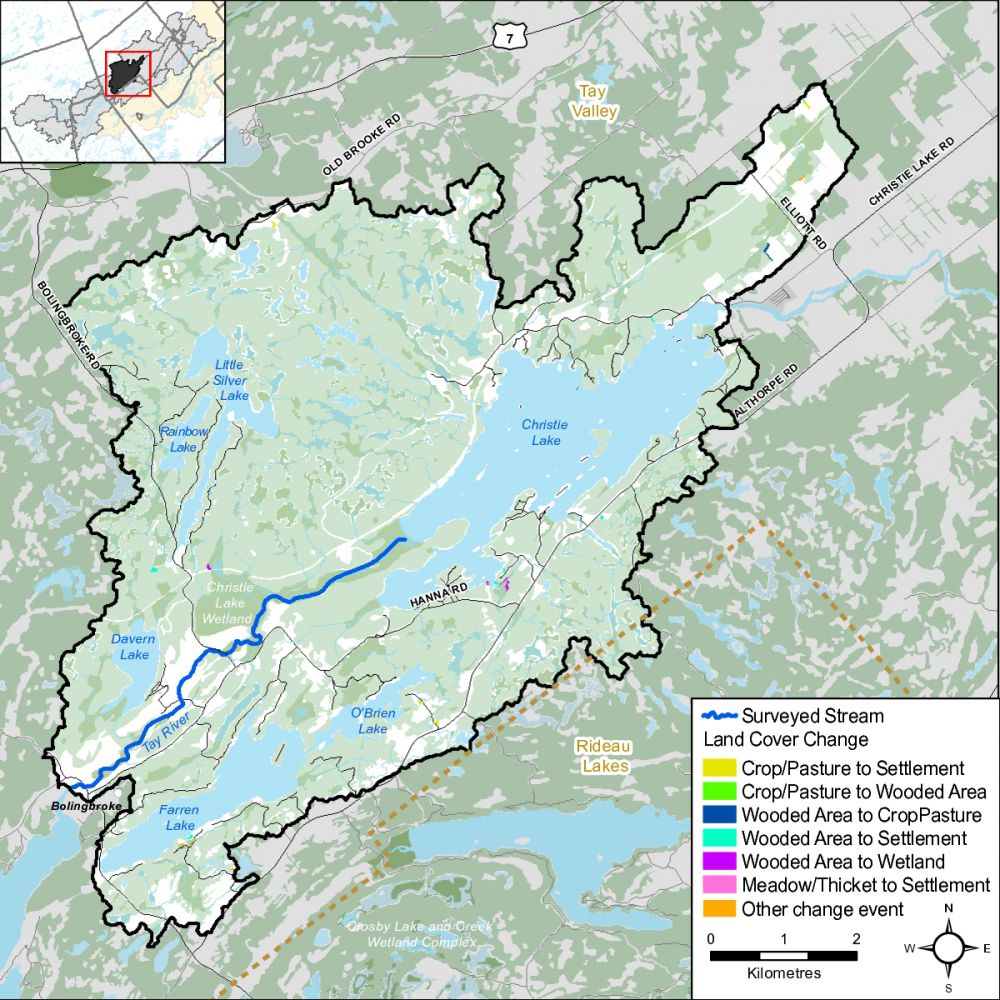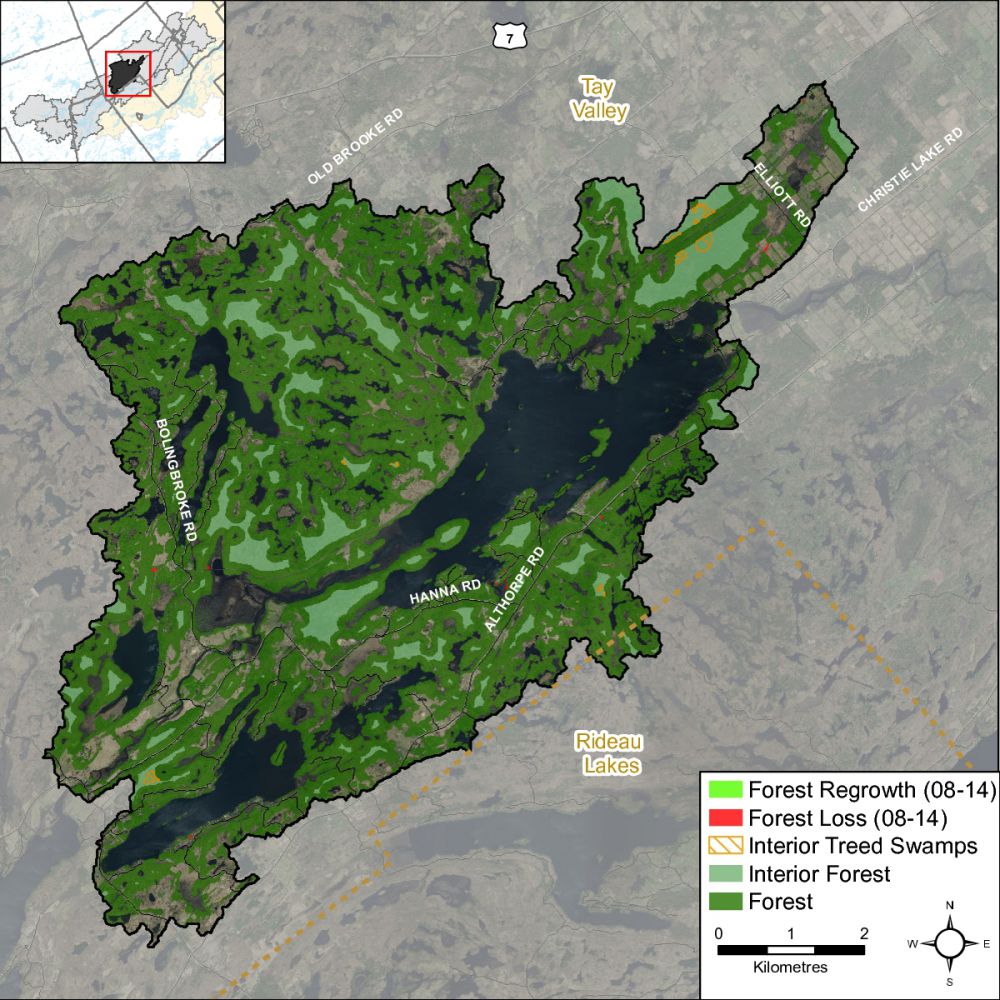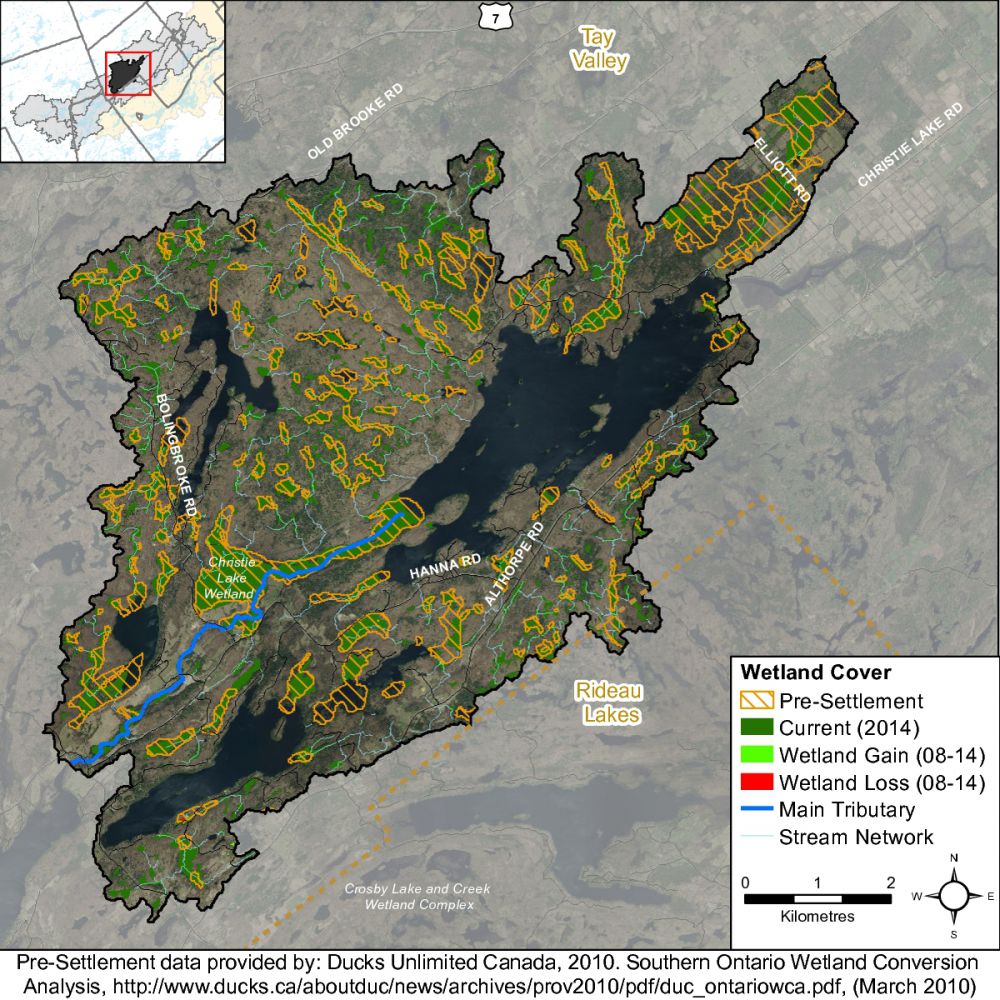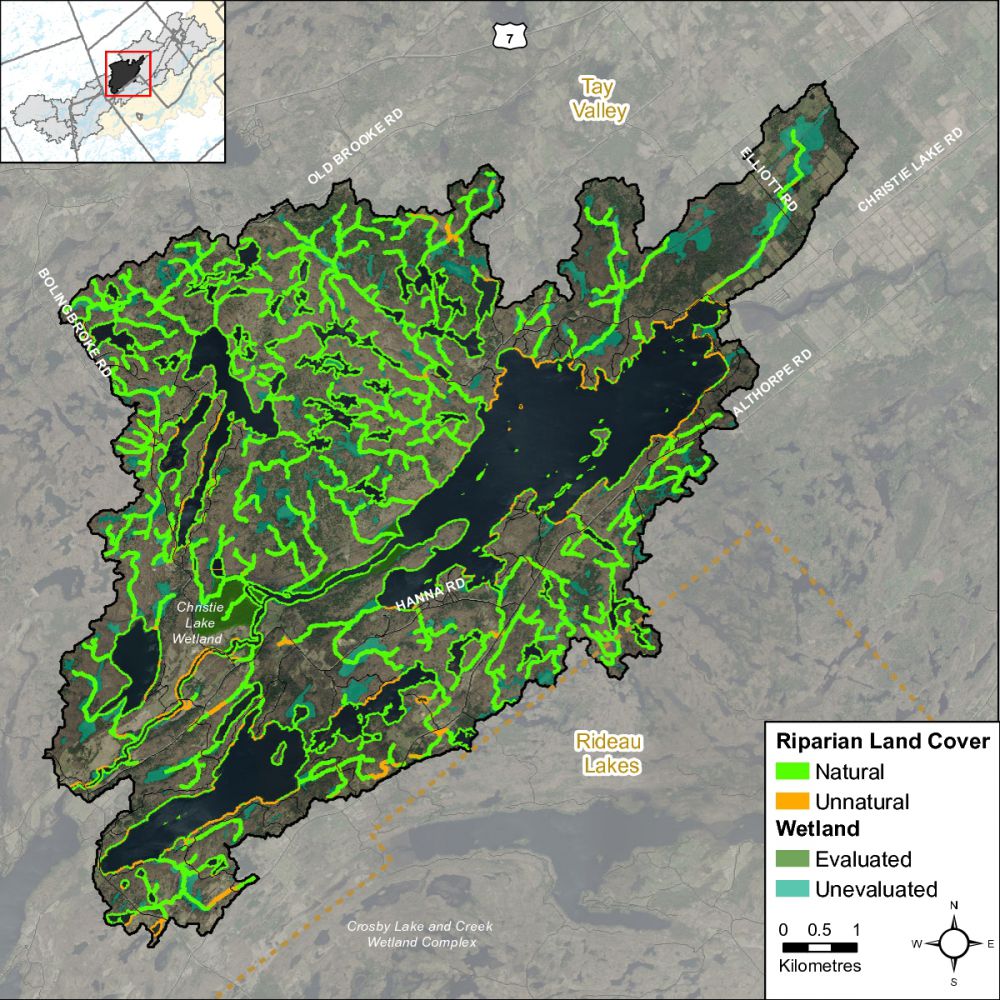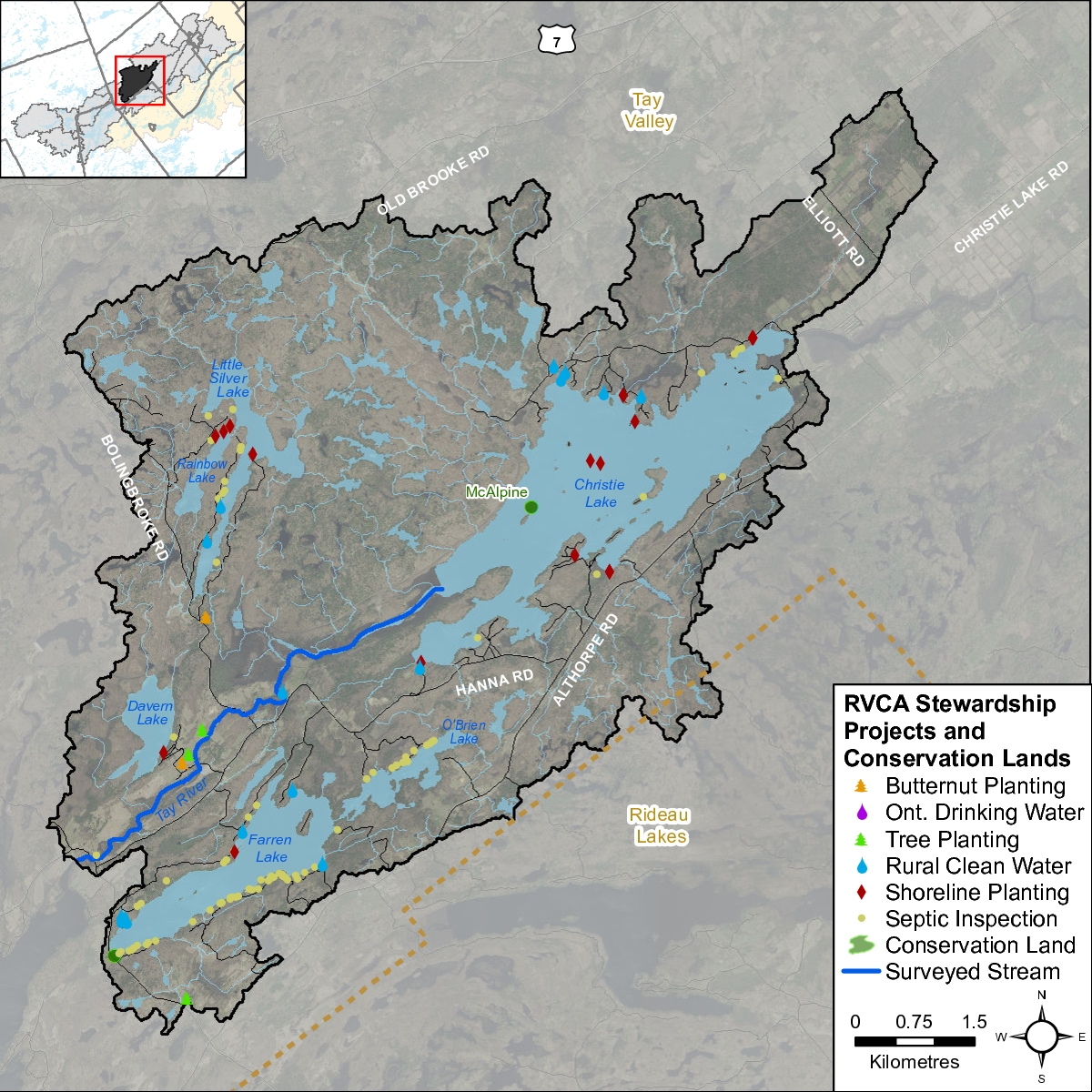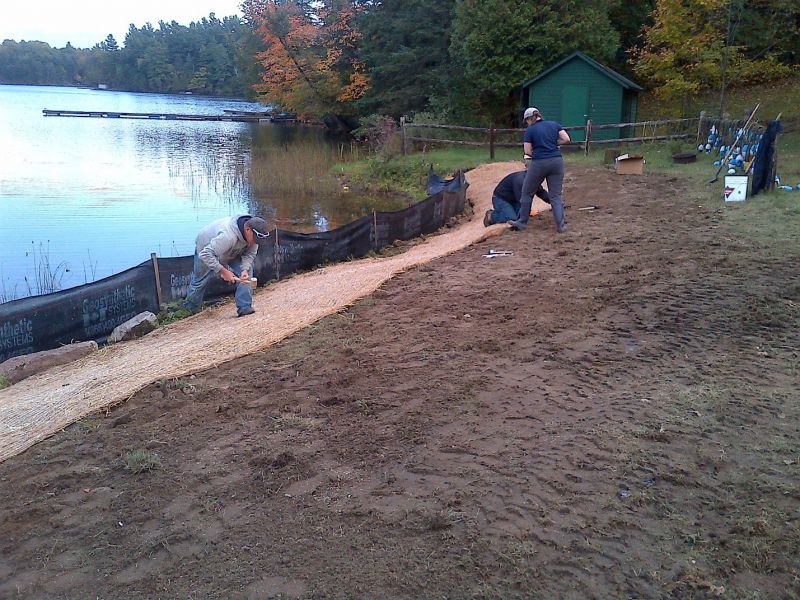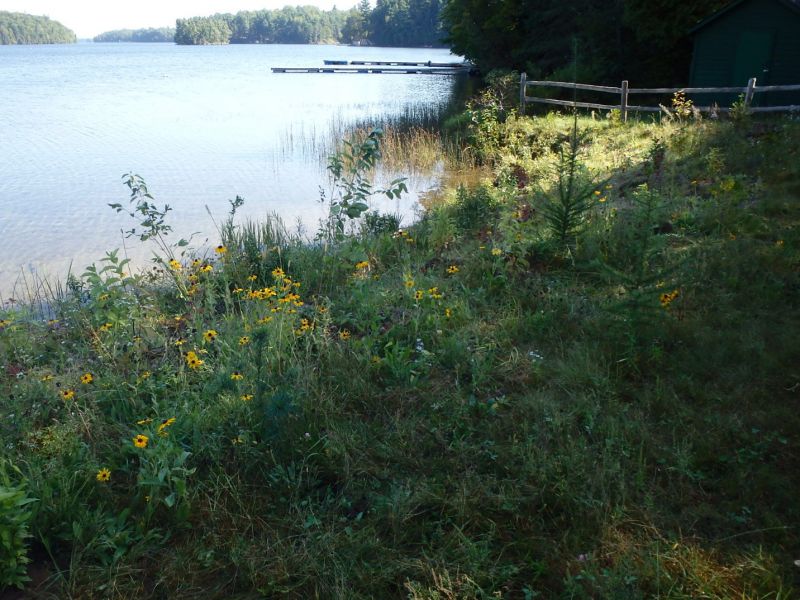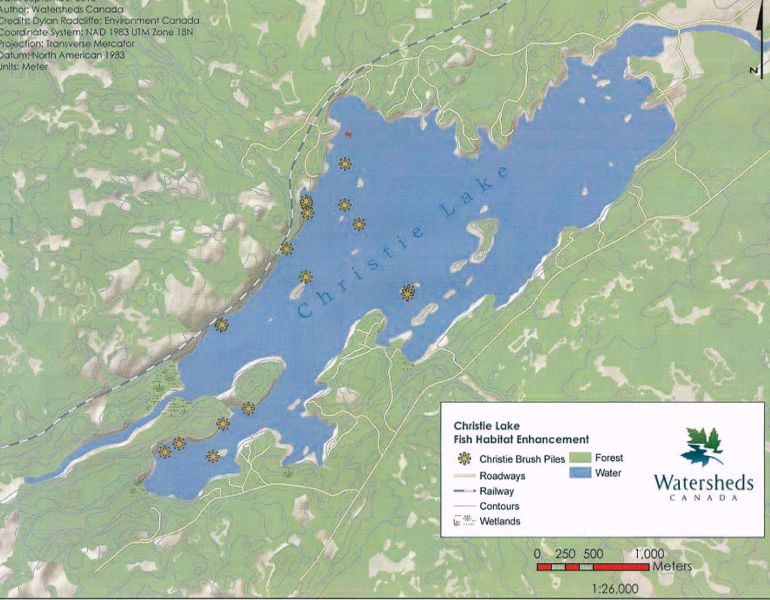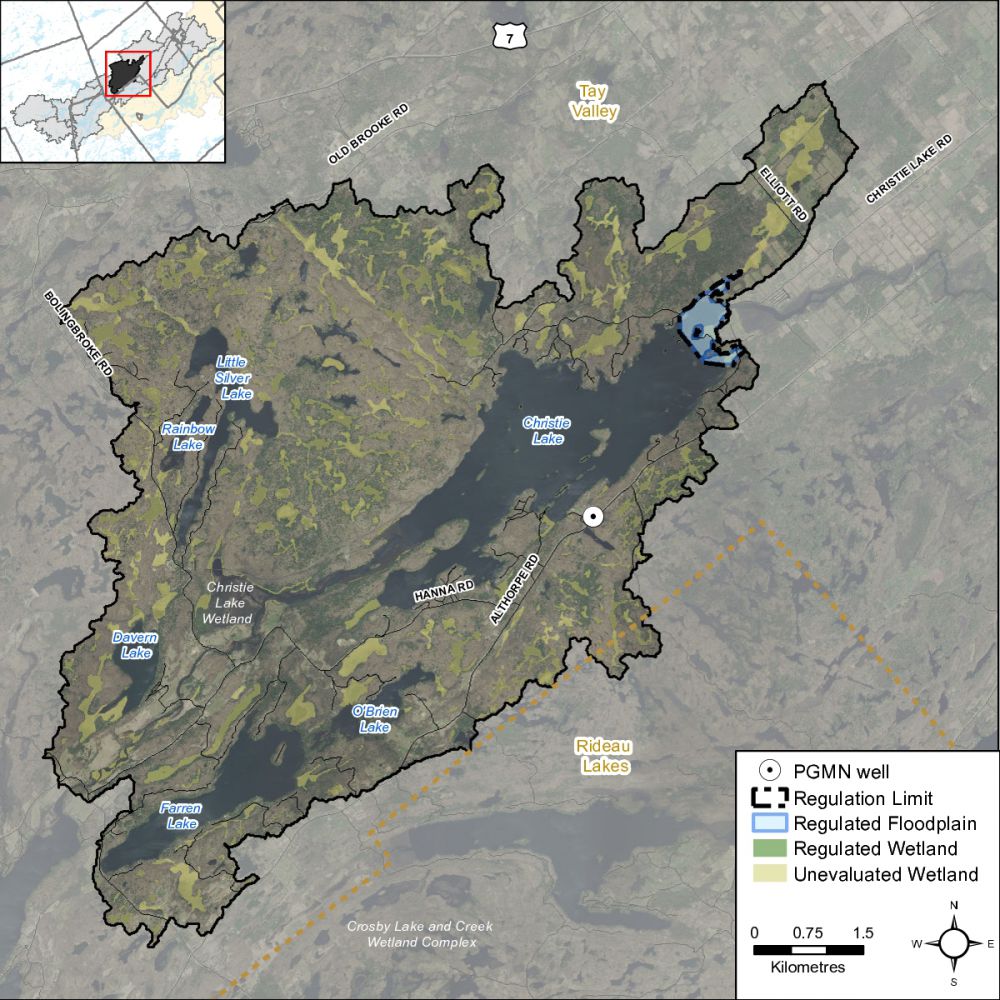Tay River Subwatershed Report 2017
CHRISTIE LAKE CATCHMENT
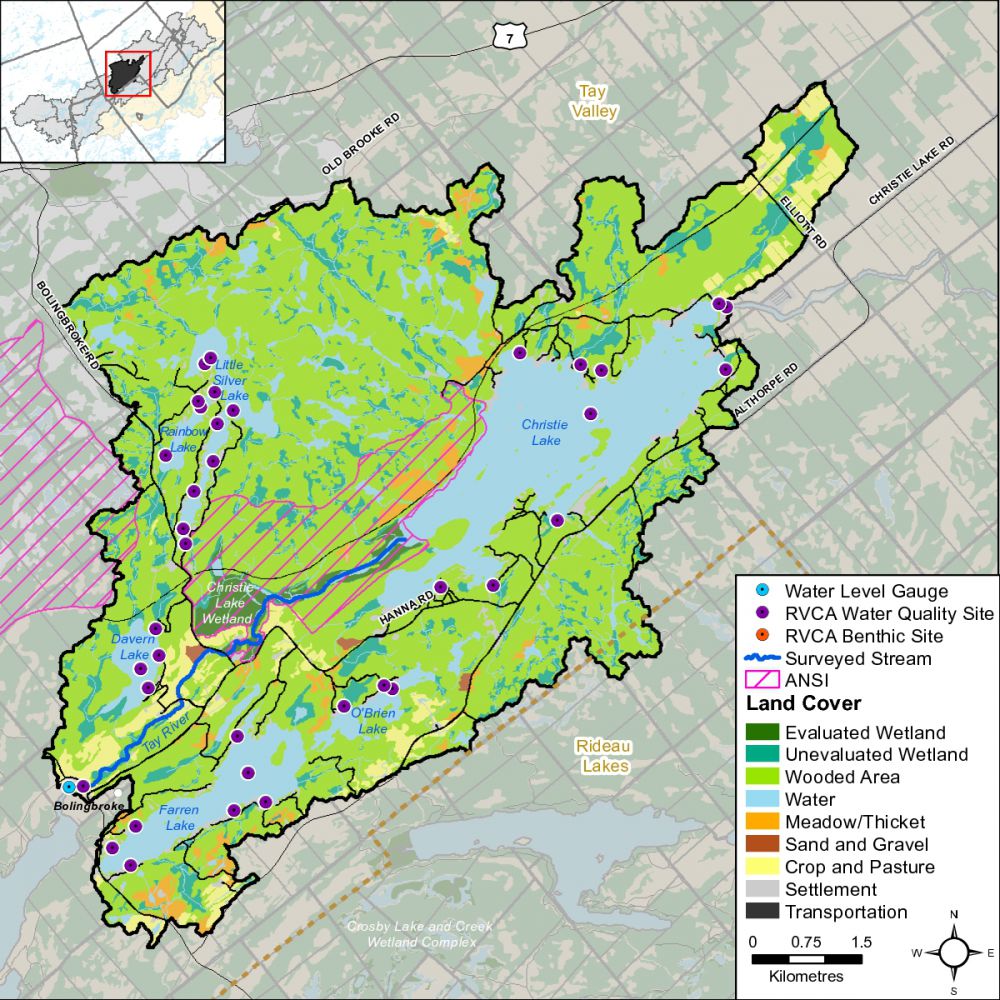 Figure 1
Figure 1 Land cover in the Christie Lake catchment
The RVCA produces individual reports for 14 catchments in the Tay River subwatershed. Using data collected and analyzed by the RVCA through its watershed monitoring and land cover classification programs, surface water quality and in-stream conditions are reported for the Tay River, Tay Watershed lakes and Tay tributaries along with a summary of environmental conditions for the surrounding countryside every six years.
This information is used to better understand the effects of human activity on our water resources, allows us to better track environmental change over time and helps focus watershed management actions where they are needed the most to help sustain the ecosystem services (cultural, aesthetic and recreational values; provisioning of food, fuel and clean water; regulation of erosion/natural hazard protection and water purification; supporting nutrient/water cycling and habitat provision) provided by the catchment’s lands and forests and waters (Millennium Ecosystem Assessment 2005).
The following sections of this report are a compilation of that work for the Christie Lake catchment.
For other Tay River catchments and the Tay River Subwatershed Report, please see Rideau Valley Conservation Authority Subwatershed Reports.
1.0 Christie Lake Catchment: Facts
1.1 General/Physical Geography
Drainage Area
65 square kilometres; occupies eight percent of the Tay River subwatershed; one percent of the Rideau Valley watershed.
Geology/Physiography
Christie Lake Catchment resides within part of the physiographic region known as the Algonquin Highlands. In the Tay River subwatershed, this ancient and hilly geologic region is made up of such Precambrian rocks as marble, conglomerates, and dark or colour banded granite-like rocks. A veneer of glacial drift (glacial till, sand etc.) overlies the bedrock.
Municipal Coverage
Rideau Lakes Township: (<1 km2; 0.5% of catchment)
Tay Valley Township: (65 km2; 99.5% of catchment)
Stream Length
All tributaries (including headwater streams): 194 km
1.2 Vulnerable Areas
Aquifer Vulnerability
Mississippi-Rideau Source Water Protection program has mapped only two very small parts of this catchment as a Significant Groundwater Recharge Areas and all of the catchment as a Highly Vulnerable Aquifer (HVA). There are no Well-Head Protection Areas in the catchment.
Wetland Hydrology
A watershed model developed by the RVCA in 2009 was used to study the hydrologic function of wetlands in the Rideau Valley Watershed, including those found in the Christie Lake catchment.
1.3 Conditions at a Glance
Aggregates
There are three aggregate licenses within the catchment along with some sand and gravel areas and secondary and tertiary significance.
Fish Community/Thermal Regime
Warm and cool water recreational and baitfish fishery with 22 species observed in the Tay River (Bolingbroke to Christie Lake) during 2016.
Headwater Drainage Features
Dominated by wetland and natural features with minimal modifications.
Instream/Riparian Habitat
Tay River (Bolingbroke to Christie Lake): Moderate to high habitat complexity observed throughout the reaches of the system within the catchment. Dissolved oxygen conditions for the Tay River varied along the system for both warm and coolwater species.
Land Cover Change (2008 to 2014)
| Catchment |
Woodland |
Crop-Pasture |
Settlement |
Wetland |
| Hectares |
-2 |
-1 |
+2 |
+1 |
Land Cover Type (2014)
| Catchment |
Woodland |
Water |
Wetland |
Crop-Pasture |
Transportation |
Meadow-Thicket |
Settlement |
| Percent |
57 |
17 |
14 |
4 |
3 |
3 |
2 |
Shoreline Cover Type (30 m. riparian area; 2014)
| Catchment |
% |
Christie Lake |
% |
Davern Lake |
% |
Farren Lake |
% |
Little Silver Lake |
% |
| Woodland |
59 |
Woodland |
63 |
Woodland |
63 |
Woodland |
66 |
Woodland |
81 |
| Wetland |
31 |
Settlement |
27 |
Wetland |
29 |
Settlement |
31 |
Settlement |
13 |
| Settlement |
4 |
Wetland |
5 |
Settlement |
7 |
Wetland |
2 |
Wetland |
4 |
| Crop-Pasture |
2 |
Transportation |
5 |
Transportation |
1 |
Transportation |
1 |
Transportation |
2 |
| Transportation |
2 |
--- |
--- |
--- |
--- |
--- |
--- |
--- |
--- |
| Meadow-Thicket |
2 |
--- |
--- |
--- |
--- |
--- |
--- |
--- |
--- |
| O'Brien Lake |
% |
Rainbow Lake |
% |
Davern Creek |
% |
Tay River |
% |
Streams |
% |
| Woodland |
81 |
Woodland |
80 |
Wetland |
68 |
Wetland |
55 |
Woodland |
57 |
| Settlement |
12 |
Settlement |
11 |
Woodland |
27 |
Woodland |
25 |
Wetland |
37 |
| Wetland |
5 |
Wetland |
9 |
Crop-Pasture |
2 |
Crop-Pasture |
11 |
Crop-Pasture |
2 |
| Transportation |
1 |
--- |
--- |
Transportation |
2 |
Settlement |
5 |
Transportation |
2 |
| Meadow-Thicket |
<1 |
--- |
--- |
Meadow-Thicket |
1 |
Transportation |
2 |
Meadow-Thicket |
2 |
| -- |
|
--- |
--- |
--- |
--- |
Aggregate |
2 |
--- |
--- |
Significant Natural Features
Christie Lake Provincially Significant Wetland.
Christie Lake Regional Candidate Area of Natural and Scientific Interest, Life Science.
Maberly Bog Regional Candidate Area of Natural and Scientific Interest, Life Science.
Species at Risk (Elemental Occurrence)
| Status |
Species at Risk |
| Endangered |
Northern Myotis |
--- |
--- |
--- |
| Threatened |
Blanding's Turtle |
Bobolink |
Eastern Meadowlark |
Least Bittern |
| Special Concern |
Eastern Milksnake |
Eastern Musk Turtle |
Eastern Ribbonsnake |
Snapping Turtle |
Water Quality for the Protection of Aquatic Life
| Water Quality Source |
Christie Lake |
Davern Lake |
Farren Lake |
Little Silver Lake |
O'Brien Lake |
Rainbow Lake |
Tay River |
| Surface Chemistry |
Good to Very Good |
Good to Very Good |
Fair to Good |
Fair |
Fair to Very Good |
Fair to Good |
Good to Very Good |
| Instream Biological |
--- |
--- |
--- |
--- |
--- |
--- |
Good |
Tay River: Benthic invertebrate samples are dominated by species that are sensitive to high organic pollution levels.
Water Wells
Approximately 290 operational private water wells in the Christie Lake catchment. Groundwater uses are mainly domestic but also include livestock and public water supplies.
Wetland Cover
Wetlands are reported to have covered 15 percent of the Grants Creek catchment prior to European settlement, as compared to 14 percent (or 9.0 square kilometres) of the area in 2014. This represents a four percent (or 0.4 square kilometre) loss of historic wetland cover. Fourteen percent of the remaining wetlands are regulated leaving 87 percent (or 7.8 square kilometers) unregulated.
1.4 Catchment Care
Environmental Management
The Christie Lake Association prepared the Christie Lake State of the Lake Report (2009), 2011 Lake Stewardship Guideline (2011) and Christie Lake Brochure (a planned 5 year update of the Lake Stewardship Guide); Farren Lake Property Owners' Association has prepared the Farren Lake State of the Lake Report (2009); Little Silver and Rainbow Lakes Property Owners Association has prepared the Little Silver and Rainbow Lake Stewardship Plan (2018). These plans and reports provide a summary of what is known about Christie Lake, Farren Lake and Little Silver and Rainbow Lakes, along with each lake community’s vision for their lakes and a list of each lake's main concerns and actions to address them.
Development along the Tay River (at its outlet from Christie Lake) is subject to Ontario Regulation 174-06 (entitled “Development, Interference with Wetlands and Alterations to Shorelines and Watercourses”) that protects landowners and their property from natural hazards (flooding, fluctuating water table, unstable soils) associated with them.
Two Environmental Compliance Approvals in the catchment were sought for a camp sewage works and a waste management site.
Environmental Monitoring
Chemical surface (in-stream/lake) water quality collection by the RVCA since 2003 (see Section 2 of this report).
Benthic invertebrate (aquatic insect), surface (in-stream) water quality collection by the RVCA in the Tay River since 2005 (see Section 3.3.1 of this report).
Fish survey and stream characterization survey by the RVCA on the Tay River in 2017 taking measurements and recording observations on instream habitat, bank stability, other attributes and preparing a temperature profile (see Section 3 of this report).
Twenty-nine drainage feature assessments were conducted by the RVCA in 2016 at road crossings in the catchment. The protocol measures zero, first and second order headwater drainage features and is a rapid assessment method characterizing the amount of water, sediment transport, and storage capacity within headwater drainage features (see Section 3.4 of this report).
Classification of Christie Lake catchment land cover classes using data acquired during the spring of 2008 and 2014 from colour aerial photography (see Section 4.1 of this report).
The Mississippi Rideau Septic System Office has conducted 342 mandatory septic system re-inspections around Christie and Farren Lake, 126 mandatory and voluntary septic system re-inspections on Little Silver, Rainbow and Silver Lake and 42 voluntary re-inspections around Davern Lake, O'Brien Lake and along the Tay River reach in the catchment, from 2004 to 2017 (see Section 5.5 of this report).
Provincial groundwater level and chemistry data is available from a PGMN well located near the shore of Christie Lake (W252).
Stewardship
Thirty-nine stewardship projects were completed by landowners with assistance from the RVCA (see Section 5 of this report).
2.0 Christie Lake Catchment: Water Quality Conditions
Surface water quality conditions in the Christie Lake catchment are monitored by the Rideau Valley Conservation Authority’s (RVCA) Watershed Watch Program and Baseline Water Quality Monitoring Program. Watershed Watch monitors watershed lakes to assess nutrient concentrations, water clarity, dissolved oxygen availability and pH. The baseline water quality program focuses on streams; data is collected for 22 parameters including nutrients (total phosphorus, total Kjeldahl nitrogen and ammonia), E. coli, metals (like aluminum and copper) and additional chemical/physical parameters (such as alkalinity, chlorides, pH and total suspended solids). Figure 2 shows the locations of monitoring sites in the catchment.
Figure 2 Water quality monitoring sites in the Christie Lake catchment
Water Quality Rating in the Christie Lake Catchment
The water quality ratings scored high across this catchment and range from "Fair to Very Good" (Table 1); with a rating of "Fair” in Little Silver Lake, "Fair to Good" in Farren and Rainbow Lakes, "Fair to Very Good" in O’Brien Lake and “Good to Very Good” in Christie and Davern Lakes. At the two monitoring sites on the Tay River (TAY-16 and TAY-15), water quality rated as “Very Good” and “Good to Very Good” respectively.
All ratings are determined using by the Canadian Council of Ministers of the Environment (CCME) Water Quality Index. A "Fair" rating indicates that water quality is usually protected but is occasionally threatened or impaired; conditions sometimes depart from natural or desirable levels. A rating of "Good" indicates that only a minor degree of threat or impairment is observed and conditions rarely depart from natural or desirable levels. “Very Good indicates water quality is protected with a virtual absence of threat or impairment; conditions are very close to natural or pristine levels.”
Each water quality parameter is evaluated against established guidelines to determine water quality conditions. Those parameters that frequently exceed guidelines are presented below. Data has been analyzed over the 2006-2017 period for general trends and conditions. Table 1 shows the overall rating for the monitored surface water quality sites within the catchment and Table 2 outlines the Water Quality Index (WQI) scores and their corresponding ratings.
Table 1 Water Quality Index ratings for the Christie Lake Catchment
Table 2 Water Quality Index ratings and corresponding index scores (RVCA terminology, original WQI category names in brackets)
2.1 Little Silver Lake Water Quality
Surface water quality conditions in Little Silver Lake have been monitored by RVCA’s Watershed Watch Program since 2006. Data from the deep point sites (DP1 and DP3) have been used to calculate the WQI rating for Little Silver Lake, which averaged “Fair” over the 2006-2017 period (Table 1). Moderate nutrient concentrations, good oxygen availability and clear water all influenced this rating. The following discussion explains how each of the monitored water quality parameters contributes to the lake’s water quality.
This report also considers data from seven additional shoreline sites that are monitored around the lake. These sites have not been included in the calculation of the CCME WQI rating, as they are not monitored with the same frequency as the deep point site. However, they do provide important information on water quality conditions in the near shore areas. For locations of shoreline sites (A-H), please see Figure 2.
2.1.1 Little Silver Lake Nutrients
Total phosphorus (TP) is used as a primary indicator of excessive nutrient loading and contributes to abundant aquatic vegetation growth and depleted dissolved oxygen levels. The Provincial Water Quality Objective (PWQO) is used as the TP Guideline and states that in lakes, concentrations greater than 0.020 mg/l indicate an excessive amount of TP within the water column.
Total Kjeldahl nitrogen (TKN) is used as a secondary indicator of nutrient loading. RVCA uses a guideline of 0.500 mg/l to assess TKN[1] within surface waters.
Nutrients at the Little Silver Lake Deep Points
TP and TKN sampling results collected by the RVCA are presented in Figures 3 to 6. Some variability has occurred in the sampled TP concentrations at this site (Figures 3 and 4), and a decreasing trend[2] was observed in the 2006-2017 data set. Eighty-seven percent of samples analyzed for TP were less than the TP guideline and the average concentration was 0.014 mg/l (Table 3). TKN concentration also showed variability though no significant change was observed (Figures 5 and 6). Eighty-nine percent of reported results were below the TKN guideline and the average TKN concentration was 0.379 mg/l (Table 3).
Figure 3 Total phosphorous sampling results at deep point sites (DP1 and DP3) on Little Silver Lake, 2006-2017
Figure 4 Average total phosphorous results at deep point sites (DP1 and DP3) on Little Silver Lake, 2006-2017
Figure 5 Total Kjeldahl nitrogen sampling results at deep point sites (DP1 and DP3) on Little Silver Lake, 2006-2017
Figure 6 Average total Kjeldahl nitrogen results at deep point sites (DP1 and DP3) on Little Silver Lake, 2006-2017
Table 3 Summary of nutrient results for Little Silver Lake, 2006-2017.
Overall, the data presented indicates that nutrient concentration may be considered low with occasional exceedances in the mid-lake, deep water sites on Little Silver Lake.
Nutrients around Little Silver Lake
The average nutrient concentrations at monitored shoreline sites around the lake vary from year to year (Figures 7 and 8). Please note that in the 2006-2017 monitoring period sites A, E and F were monitored yearly; while sites B, C, D and G were only sampled in 2006, 2011 and 2016.
Average total phosphorous concentrations are below the TP guideline at all sites (Figure 7), as are the average total Kjeldahl nitrogen concentrations for the TKN guideline at all sites (Figure 8).
Figure 7 Average total phosphorous concentrations at shoreline monitoring sites in Little Silver Lake, 2006-2017
Figure 8 Average total Kjeldahl nitrogen concentrations at shoreline monitoring sites in Little Silver Lake, 2006-2017
Summary of Little Silver Lake Nutrients
Little Silver Lake nutrient concentrations are generally below the guidelines, with few exceedances. It is possible that occasional problems with nutrient enrichment (i.e. algal blooms or excessive plant growth) may be observed in shallow, sheltered bays.
Efforts such as the diversion of runoff and enhanced shoreline buffers are important to continue to protect and enhance water quality, and reduce future nutrient increases. Nutrient exceedances may be partially attributed to the natural aging of a lake and basin characteristics. All residents can help minimize their impact on the lake by reducing nutrient inputs through practices such as proper maintenance of septic systems, keeping shorelines natural and using phosphate free soaps and detergents. Promotion of sound stewardship and protection around lake is important to maintain and protect water quality conditions into the future.
2.1.2 Little Silver Lake Water Clarity
Water clarity is measured using a Secchi disk during each deep point sample. Table 4 summarizes the recorded depths with an average depth of 4.7 m and shows that most (96% of) readings have exceeded the minimum PWQO of 2 m indicating that algae in the water column are not at excessive levels (good water clarity). Less than 2 m will indicate overproduction in a lake or significant inputs to the water column that are limiting light availability. Figure 9 shows that no individual reading has been below the guideline and measured depths range from 2.5 m to 8.0 m. A decreasing trend was observed within the 2006-2017 data set, indicating that Secchi depths have been reduced over this period.
Table 4 Summary of Secchi depths recorded at the deep point sites on Little Silver Lake, 2006-2017
Figure 9 Recorded Secchi depths at the deep point sites (DP1/DP3) on Little Silver Lake, 2006-2017
Summary of Little Silver Lake Water Clarity
Waters in Little Silver Lake are generally clear and sufficient sunlight is able to penetrate the water column to support aquatic life and provide sufficient visibility for safe recreational use (boating, swimming).
2.1.3 Little Silver Lake Fish Habitat
Two other factors, dissolved oxygen/temperature and pH were also assessed to provide an overall sense of the health of Little Silver Lake from a fish habitat perspective.
2.1.3.1 Little Silver Lake Dissolved Oxygen and Temperature
The red bars in Figure 10 show the depths where suitable conditions exist for warm water fish species (temperature less than 25°C and dissolved oxygen greater than 4 mg/l) at the deep point site. The vertical axis represents the total lake depth. Suitable conditions typically decline throughout the summer to about 6m of the water column. In late 2016, habitat conditions were notably low due to the warming of the water column. Overall, no significant change was noted in conditions through the 2006-2017 period.
Figure 10 Depths suitable for warm water fish species at the deep point sites (DP1 and DP3) on Little Silver Lake, 2006-2017.
2.1.3.2 Little Silver Lake pH
pH is a basic water quality parameter used to assess the acidity of water, an important factor for aquatic life. Figure 11 shows the monitored pH values over the 2006-2017 period.
Figure 11 pH concentrations at the deep point sites (DP1 and DP3) on Little Silver Lake, 2006-2017
The majority of samples (99%) for both time periods were within guidelines established by the Canadian Council of Minister's of the Environment which state that pH should be between 6.5 and 9 to protect aquatic life (Table 5, Figure 11). Surface water’s that are found to be more alkaline (higher pH) are common in many regions of the Tay River subwatershed and can generally be attributed to the geology rather than anthropogenic activities. Biological activities such as increased photosynthesis from algal blooms and plant growth may also influence pH.
Table 5 Summary of pH results at the deep point sites (DP1 and DP3) on Little Silver Lake, 2006-2017.
Summary of Water Quality for Fish Habitat in Little Silver Lake
Overall the water chemistry data at the deep point describes suitable habitat conditions for fish species such as bass, walleye and pike. pH conditions are within the range recommended for the protection of aquatic life. Overall, the data indicates a healthy environment for aquatic species.
2.1.4 Little Silver Lake E. Coli
E. coli is sampled at monitored shoreline sites twice each sampling season. E. coli data was not used in the calculations of the WQI rating for the lake due to differences in sampling frequency and site locations. E. coli data has been summarized in Table 6.
Throughout the 2006-2017 period 100 percent of samples collected by RVCA were below the E. coli guideline of 100 colony forming units (CFU) per 100 ml set by the PWQO; across the lake the count at the geometric mean was 3 CFU/100ml (Table 6). This provides support that there is little indication of bacterial contamination around the lake. Figure 12 show the distribution of counts across all shoreline sites. All sites fell well below the guideline of 100 CFU/100ml.
Table 6 Summary of
E. coli results for Little Silver Lake, 2006-2017
Figure 12 Geometric mean of E.coli counts at shoreline sites monitored on Little Silver Lake, 2006-2017
Summary of Little Silver Lake Bacterial Contamination
The results presented above indicate that bacterial contamination is not a significant concern in Little Silver Lake and the water should be safe for recreational use such as swimming and boating.
2.2 Rainbow Lake Water Quality
Surface water quality conditions in Rainbow have been monitored by RVCA’s Watershed Watch Program since 2006. Data from the deep point sites (DP1) have been used to calculate the WQI rating for Rainbow Lake, which averaged “Fair to Good” over the 2006-2017 period (Table 1). Moderate nutrient concentrations, good oxygen availability and clear water all influenced this rating. The following discussion explains how each of the monitored water quality parameters contributes to the lake’s water quality.
This report also considers data from two additional shoreline sites that are monitored around the lake. These sites have not been included in the calculation of the CCME WQI rating, as they are not monitored with the same frequency as the deep point site. However, they do provide important information on water quality conditions in the near shore areas. For locations of shoreline sites (A and B), please see Figure 2.
2.2.1 Rainbow Lake Nutrients
Total phosphorus (TP) is used as a primary indicator of excessive nutrient loading and contributes to abundant aquatic vegetation growth and depleted dissolved oxygen levels. The Provincial Water Quality Objective (PWQO) is used as the TP Guideline and states that in lakes, concentrations greater than 0.020 mg/l indicate an excessive amount of TP within the water column.
Total Kjeldahl nitrogen (TKN) is used as a secondary indicator of nutrient loading. RVCA uses a guideline of 0.500 mg/l to assess TKN[1] within surface waters.
Nutrients at the Rainbow Lake Deep Point
TP and TKN sampling results collected by the RVCA are presented in Figures 13 to 16. Fluctuations in TP concentrations are common, with the majority of results below the guideline (Figures 13 and 14); a decreasing trend[2] in TP concentrations was observed in the 2006-2017 data set. A similar decline was also observed in Little Silver Lake which receives Rainbow Lake's outflow. Eighty-two percent of samples analyzed for TP were less than the TP guideline and the average concentration was 0.015 mg/l (Table 7). TKN concentrations also showed variability and no significant change was observed (Figures 15 and 16). Fifty-one percent of reported results were below the TKN guideline and the average TKN concentration was 0.488 mg/l (Table 7).
Figure 13 Total phosphorous sampling results at deep point site (DP1) on Rainbow Lake, 2006-2017
Figure 14 Average total phosphorous results at deep point site (DP1) on Rainbow Lake, 2006-2017
Figure 15 Total Kjeldahl nitrogen sampling results at deep point site (DP1) on Rainbow Lake, 2006-2017
Figure 16 Average total Kjeldahl nitrogen results at deep point site (DP1) on Rainbow Lake, 2006-2017
Table 7 Summary of nutrient results for Rainbow Lake, 2006-2017.
Overall, the data presented indicates that nutrient concentrations may be considered low with occasional exceedances in the mid-lake, deep water sites on Rainbow Lake. Elevated TKN concentrations can likely be attributed to the influence of surrounding wetlands that drain into the lake, as well as influence of nutrient rich sediments in this very shallow waterbody.
Nutrients around Rainbow Lake
The average nutrient concentrations at monitored shoreline sites around the lake have varied from year to year (Figures 17 and 18). Please note that in the 2006-2017 monitoring period, only site A was monitored yearly; site B was sampled in 2006, 2011, 2016 and 2017.
Average total phosphorous concentrations are below the TP guideline at site B during the monitored years (Figure 17). Site A had elevated results in 2006 and 2011, however all subsequent yearly results have been below the guideline. Average TKN concentrations have exceeded or approach the guideline frequently at site A, while results at site B are below the guideline for each year of data (Figure 18).
Figure 17 Average total phosphorous concentrations at shoreline monitoring sites in Rainbow Lake, 2006-2017
Figure 18 Average total phosphorous concentrations at shoreline monitoring sites in Rainbow Lake, 2006-2017
Summary of Rainbow Lake Nutrients
Rainbow Lake nutrient data shows that elevated levels of TKN are common in this waterbody. As previously noted Rainbow Lake is a shallow water body and these elevated concentrations can likely be attributed to wetland characteristics and the influence of nutrient rich sediments on the surface water. It is possible that occasional problems with nutrient enrichment (i.e. algal blooms or excessive plant growth) may be observed in shallow, sheltered bays.
Efforts such as the diversion of runoff and enhanced shoreline buffers are important to continue to protect and enhance water quality, and reduce future nutrient increases. Nutrient exceedances may be partially attributed to the natural aging of a lake and basin characteristics. All residents can help minimize their impact on the lake by reducing nutrient inputs through practices such as proper maintenance of septic systems, keeping shorelines natural and using phosphate free soaps and detergents. Promotion of sound stewardship and protection around lake is important to maintain and protect water quality conditions into the future.
2.2.2 Rainbow Lake Water Clarity
Water clarity is measured using a Secchi disk during each deep point sample. Table 8 summarizes the recorded depths with an average depth of 3.3 m and shows that all readings have exceeded the minimum PWQO of 2 m indicating that algae in the water column is not at excessive levels (good water clarity). Less than 2 m will indicate overproduction in a lake or significant inputs to the water column that are limiting light availability. Figure 19 shows that no individual reading has been below the guideline and measured depths range from 2.1 m to 5.0 m. No significant change was noted in Secchi depth over the 2006-2017 period.
Table 8 Summary of Secchi depths recorded at the deep point site (DP1) on Rainbow Lake, 2006-2017
Figure 19 Recorded Secchi depths at the deep point site (DP1) on Rainbow Lake, 2006-2017
Summary of Rainbow Lake Water Clarity
Waters in Rainbow Lake are clear and sufficient sunlight is able to penetrate the water column to support aquatic life and provide sufficient visibility for safe recreational use (boating, swimming).
2.2.3 Rainbow Lake Fish Habitat
Two other factors, dissolved oxygen/temperature and pH were also assessed to provide an overall sense of the health of Rainbow Lake from a fish habitat perspective.
2.2.3.1 Rainbow Lake Dissolved Oxygen and Temperature
The red bars in Figure 20 show the depths where suitable conditions exist for warm water fish species (temperature less than 25°C and dissolved oxygen greater than 4 mg/l) at the deep point site. The vertical axis represents the total lake depth at each site where the profile is taken. Suitable conditions typically decline throughout the summer to about 2m-3.5m of the water column. In late 2016, habitat conditions were notably low due to the warming of the water column. Overall, no significant change was noted in conditions through the 2006-2017 period.
Figure 20 Depths suitable for warm water fish species at the deep point site (DP1 ) on Rainbow Lake, 2006-2017.
2.2.3.2 Rainbow Lake pH
pH is a basic water quality parameter used to assess the acidity of water, an important factor for aquatic life. Figure 21 shows monitored pH values over the 2006-2017 period.
Figure 21 pH concentrations at the deep point site (DP1) on Rainbow Lake, 2006-2017
All samples for pH are within guidelines established by the Canadian Council of Minister's of the Environment which state that pH should be between 6.5 and 9 to protect aquatic life (Table 9, Figure 21). Surface water’s that are found to be more alkaline (higher pH) are common in many regions of the Tay River subwatershed and can generally be attributed to the geology rather than anthropogenic activities. Biological activities such as increased photosynthesis from algal blooms and plant growth may also influence pH.
Table 9 Summary of pH results at the deep point site (DP1) on Rainbow Lake, 2006-2017.
Summary of Water Quality for Fish Habitat in Rainbow Lake
Overall the water chemistry data at the deep point describes suitable habitat conditions for warm water fish species, though these can become limited during warm periods. pH conditions are within the range recommended for the protection of aquatic life. Overall, the data indicates a healthy environment for aquatic species.
2.2.4 Rainbow Lake E. Coli
E. coli is sampled at monitored shoreline sites twice each sampling season. E. coli data was not used in the calculations of the WQI rating for the lake due to differences in sampling frequency and site locations. E. coli data has been summarized in Table 10.
Throughout the 2006-2017 period, 100 percent of samples collected by RVCA were below the E. coli guideline of 100 colony forming units (CFU) per 100 ml set by the PWQO; across the lake the count at the geometric mean was 6 CFU/100ml (Table 10). This provides support that there is little indication of bacterial contamination around the lake. Figure 22 shows the distribution of counts across all shoreline sites. All sites fell well below the guideline of 100 CFU/100ml.
Table 10 Summary of
E. coli results for Rainbow Lake, 2006-2017
Figure 22 Geometric mean of E.coli counts at shoreline sites monitored on Rainbow Lake, 2006-2017
Summary of Rainbow Lake Bacterial Contamination
The results presented above indicate that bacterial contamination is not a significant concern in Rainbow Lake and the water should be safe for recreational use such as swimming and boating.
2.3 Farren Lake Water Quality
Surface water quality conditions in Farren have been monitored by RVCA’s Watershed Watch Program since 2001. Data from the deep point site (DP1) have been used to calculate the WQI rating for Farren Lake, which averaged “Fair to Good” over the 2006-2017 period (Table 1). Moderate nutrient concentrations, good oxygen availability and clear water all influenced this rating. The following discussion explains how each of the monitored water quality parameters contributes to the lake’s water quality.
This report also considers data from six additional shoreline sites that are monitored around the lake. These sites have not been included in the calculation of the CCME WQI rating, as they are not monitored with the same frequency as the deep point site. However, they do provide important information on water quality conditions in the near shore areas. For locations of shoreline sites (A-F), please see Figure 2.
2.3.1 Farren Lake Nutrients
Total phosphorus (TP) is used as a primary indicator of excessive nutrient loading and contributes to abundant aquatic vegetation growth and depleted dissolved oxygen levels. The Provincial Water Quality Objective (PWQO) is used as the TP Guideline and states that in lakes, concentrations greater than 0.020 mg/l indicate an excessive amount of TP within the water column.
Total Kjeldahl nitrogen (TKN) is used as a secondary indicator of nutrient loading. RVCA uses a guideline of 0.500 mg/l to assess TKN[1] within surface waters.
Nutrients at the Farren Lake Deep Point
TP and TKN sampling results collected by the RVCA are presented in Figures 23 to 26. While moderate fluctuations in TP concentrations have occurred (Figures 23 and 24), there was no significant trend observed in the 2006-2017 data set. Ninety-eight percent of samples analyzed for TP were less than the TP guideline and the average concentration was 0.009 mg/l (Table 11). TKN concentration also showed variability though no significant change was observed (Figures 25 and 26). Ninety-eight percent of reported results were below the TKN guideline and the average TKN concentration was 0.336 mg/l (Table 11).
Figure 23 Total phosphorous sampling results at deep point site (DP1) on Farren Lake, 2006-2017
Figure 24 Average total phosphorous results at deep point site (DP1) on Farren Lake, 2006-2017
Figure 25 Total Kjeldahl nitrogen sampling results at deep point site (DP1) on Farren Lake, 2006-2017
Figure 26 Average total Kjeldahl nitrogen results at deep point site (DP1) on Farren Lake, 2006-2017
Table 11 Summary of nutrient results for Farren Lake, 2006-2017.
Overall, the data presented indicates that nutrient concentration may be considered low with very limited instances of elevated concentrations in the mid-lake, deep water sites on Farren Lake.
Nutrients around Farren Lake
The average nutrient concentrations at monitored shoreline sites around the lake have varied from year to year (Figures 27 and 28). Please note that in the 2006-2017 monitoring period only sites B, D and E were monitored yearly; sites A, C and F were sampled in 2006, 2011 and 2016.
Average total phosphorous concentrations are below the TP guideline at all sites during the monitored years (Figure 27). Average TKN concentrations were generally below the guideline, with the exception of site E in 2011 and 2017 (Figure 28).
Figure 27 Average total phosphorous concentrations at shoreline monitoring sites in Farren Lake, 2006-2017
Figure 28 Average total Kjeldahl nitrogen concentrations at shoreline monitoring sites in Farren Lake, 2006-2017
Summary of Farren Lake Nutrients
Farren Lake nutrient data shows that elevated levels of nutrients are not a concern in Farren Lake, with the exception of occasional elevated results at site E. It is possible that occasional problems with nutrient enrichment (i.e. algal blooms or excessive plant growth) may be observed in shallow, sheltered bays.
Efforts such as the diversion of runoff and enhanced shoreline buffers are important to continue to protect and enhance water quality, and reduce future nutrient increases. Nutrient exceedances may be partially attributed to the natural aging of a lake and basin characteristics. All residents can help minimize their impact on the lake by reducing nutrient inputs through practices such as proper maintenance of septic systems, keeping shorelines natural and using phosphate free soaps and detergents. Promotion of sound stewardship and protection around lake is important to maintain and protect water quality conditions into the future.
2.3.2 Farren Lake Water Clarity
Water clarity is measured using a Secchi disk during each deep point sample. Table 12 summarizes the recorded depths with an average depth of 5.4 m and shows that all readings have exceeded the minimum PWQO of 2 m indicating that algae in the water column are not at excessive levels (good water clarity). Less than 2 m will indicate overproduction in a lake or significant inputs to the water column that are limiting light availability. Figure 29 shows that no individual reading has been below the guideline and measured depths range from 2.1 m to 8.8 m. A significant decrease was noted in Secchi depth over the 2006-2017 period.
Table 12 Summary of Secchi depths recorded at the deep point site (DP1) on Farren Lake, 2006-2017
Figure 29 Recorded Secchi depths at the deep point site (DP1) on Farren Lake, 2006-2017
Summary of Farren Lake Water Clarity
Waters in Farren Lake are clear and sufficient sunlight is able to penetrate the water column to support aquatic life and provide sufficient visibility for safe recreational use (boating, swimming).
2.3.3 Farren Lake Fish Habitat
Two other factors, dissolved oxygen/temperature and pH were also assessed to provide an overall sense of the health of Farren Lake from a fish habitat perspective.
2.3.3.1 Farren Lake Dissolved Oxygen and Temperature
The red bars in Figure 30 show the depths where suitable conditions exist for warm water fish species (temperature less than 25°C and dissolved oxygen greater than 4 mg/l) at the deep point site. The vertical axis represents the total lake depth where the profile is taken. Suitable conditions typically decline throughout the summer to about 12 m of the water column. Overall, no significant change was noted in conditions through the 2006-2017 period.
Figure 30 Depths suitable for warm water fish species at the deep point site (DP1 ) on Farren Lake, 2006-2017.
2.3.3.2 Farren Lake pH
The majority of samples are within guidelines established by the Canadian Council of Ministers of the Environment, which state that pH should be between 6.5 and 9 to protect aquatic life (Table 13, Figure 31). Surface water’s that are found to be more alkaline (higher pH) are common in many regions of the Tay River subwatershed and can generally be attributed to the geology rather than anthropogenic activities. Biological activities such as increased photosynthesis from algal blooms and plant growth may also influence pH.
Figure 31 pH concentrations at the deep point site (DP1) on Farren Lake, 2006-2017
Table 13 Summary of pH results at the deep point site (DP1) on Farren Lake, 2006-2017.
Summary of Water Quality for Fish Habitat in Farren Lake
Overall the water chemistry data at the deep point describes suitable habitat conditions for warm water fish species, though these can become limited during warm periods. pH conditions are within the range recommended for the protection of aquatic life. Overall, the data indicates a healthy environment for aquatic species.
2.3.4 Farren Lake E. Coli
E. coli is sampled at monitored shoreline sites twice each sampling season. E. coli data was not used in the calculations of the WQI rating for the lake due to differences in sampling frequency and site locations. E. coli data has been summarized in Table 14.
Throughout the 2006-2017 period 100 percent of samples collected by RVCA were below the E. coli guideline of 100 colony forming units (CFU) per 100 ml set by the PWQO; across the lake the count at the geometric mean was 2 CFU/100ml (Table 14). This provides support that there is little indication of bacterial contamination around the lake. Figure 32 show the distribution of counts across all shoreline sites. All sites fell well below the guideline of 100 CFU/100ml.
Table 14 Summary of
E. coli results for Farren Lake, 2006-2017
Figure 32 Geometric mean of E.coli counts at shoreline sites monitored on Farren Lake, 2006-2017
Summary of Farren Lake Bacterial Contamination
The results presented above indicate that bacterial contamination is not a significant concern in Farren Lake and the water should be safe for recreational use such as swimming and boating.
2.4 O'Brien Lake Water Quality
Surface water quality conditions were first monitored in O'Brien Lake by RVCA’s Watershed Watch Program in 2001. Data from the deep point site (DP1) have been used to calculate the WQI rating for O'Brien Lake, which averaged “Fair to Very Good” over the 2006-2017 period (Table 1). Moderate nutrient concentrations, good oxygen availability and clear water all influenced this rating. The following discussion explains how each of the monitored water quality parameters contributes to the lake’s water quality.
This report also considers data from two additional shoreline sites that are monitored around the lake. These sites have not been included in the calculation of the CCME WQI rating, as they are not monitored with the same frequency as the deep point site. However, they do provide important information on water quality conditions in the near shore areas. For locations of shoreline sites (A and B), please see Figure 2.
2.4.1 O'Brien Lake Nutrients
Total phosphorus (TP) is used as a primary indicator of excessive nutrient loading and contributes to abundant aquatic vegetation growth and depleted dissolved oxygen levels. The Provincial Water Quality Objective (PWQO) is used as the TP Guideline and states that in lakes, concentrations greater than 0.020 mg/l indicate an excessive amount of TP within the water column.
Total Kjeldahl nitrogen (TKN) is used as a secondary indicator of nutrient loading. RVCA uses a guideline of 0.500 mg/l to assess TKN[1] within surface waters.
Nutrients at the O'Brien Lake Deep Point
TP and TKN sampling results collected by the RVCA are presented in Figures 33 to 36. While moderate fluctuations in TP concentrations have occurred (Figures 33 and 34), there was no significant trend observed in the 2006-2017 data set. Ninety-three percent of samples analyzed for TP were less than the TP guideline and the average concentration was 0.010 mg/l (Table 15). TKN concentration also showed variability though no significant change was observed (Figures 35 and 36). Ninety-three percent of reported results were below the TKN guideline and the average TKN concentration was 0.400 mg/l (Table 15).
Figure 33 Total phosphorous sampling results at deep point site (DP1) on O'Brien Lake, 2006-2017
Figure 34 Average total phosphorous results at deep point site (DP1) on O'Brien Lake, 2006-2017
Figure 35 Total Kjeldahl nitrogen sampling results at deep point site (DP1) on O'Brien Lake, 2006-2017
Figure 36 Average total Kjeldahl nitrogen results at deep point site (DP1) on O'Brien Lake, 2006-2017
Table 15 Summary of nutrient results for O'Brien Lake, 2006-2017.
Overall, the data presented indicates that nutrient concentration may be considered low with very limited instances of elevated concentrations in the mid-lake, deep water sites in O'Brien Lake.
Nutrients around O'Brien Lake
The average nutrient concentrations at monitored shoreline sites around the lake have varied from year to year (Figures 37 and 38).
Average total phosphorous concentrations are below the TP guideline at all sites during the monitored years, with the exception of site B in 2009 (Figure 37). A sample of 0.031 mg/l in July of this year was collected and is responsible for the elevated results; TKN concentrations from this same sample also exceeded the guideline at 0.890 mg/l. With the exception of site B in 2009 and a slight exceedance in 2014, average TKN concentrations were generally below the guideline (Figure 38).
Figure 37 Average total phosphorous concentrations at shoreline monitoring sites in O'Brien Lake, 2006-2017
Figure 38 Average total Kjeldahl nitrogen concentrations at shoreline monitoring sites in O'Brien Lake, 2006-2017
Summary of O'Brien Lake Nutrients
O'Brien Lake nutrient data shows that elevated levels of nutrients are not of concern in O'Brien Lake, with the exception of occasional elevated results at site B. The isolated elevated sample may be the result of contamination during collection or may have been impacted by runoff following a rain event. It is possible that occasional problems with nutrient enrichment (i.e. algal blooms or excessive plant growth) may be observed in shallow bays such as that of site B.
Efforts such as the diversion of runoff and enhanced shoreline buffers are important to continue to protect and enhance water quality, and reduce future nutrient increases. Nutrient exceedances may be partially attributed to the natural aging of a lake and basin characteristics. All residents can help minimize their impact on the lake by reducing nutrient inputs through practices such as proper maintenance of septic systems, keeping shorelines natural and using phosphate free soaps and detergents. Promotion of sound stewardship and protection around lake is important to maintain and protect water quality conditions into the future.
2.4.2 O'Brien Lake Water Clarity
Water clarity is measured using a Secchi disk during each deep point sample. Table 16 summarizes the recorded depths with an average depth of 4.8 m and shows that all readings have exceeded the minimum PWQO of 2 m indicating that algae in the water column are not at excessive levels (good water clarity). Less than 2 m will indicate overproduction in a lake or significant inputs to the water column that are limiting light availability. Figure 39 shows that no individual reading has been below the guideline and measured depths range from 2.5 m to 8.3 m. No significant change was noted in Secchi depth over the 2006-2017 period.
Table 16 Summary of Secchi depths recorded at the deep point site (DP1) on O'Brien Lake, 2006-2017
Figure 39 Recorded Secchi depths at the deep point site (DP1) on O'Brien Lake, 2006-2017
Summary of O'Brien Lake Water Clarity
Waters in O'Brien Lake are clear and sufficient sunlight is able to penetrate the water column to support aquatic life and provide sufficient visibility for safe recreational use (boating, swimming).
2.4.3 O'Brien Lake Fish Habitat
Two other factors, dissolved oxygen/temperature and pH were also assessed to provide an overall sense of the health of O'Brien Lake from a fish habitat perspective.
2.4.3.1 O'Brien Lake Dissolved Oxygen and Temperature
The red bars in Figure 40 show the depths where suitable conditions exist for warm water fish species (temperature less than 25°C and dissolved oxygen greater than 4 mg/l) at the deep point site. The vertical axis represents the total lake depth at each site where the profile is taken. Suitable conditions typically decline throughout the summer to 6-8 m of the water column. Overall, no significant change was noted in conditions through the 2006-2017 period.
Figure 40 Depths suitable for warm water fish species at the deep point site (DP1 ) on O'Brien Lake, 2006-2017.
2.4.3.2 O'Brien Lake pH
All samples were within guidelines established by the Canadian Council of Minister's of the Environment which state that pH should be between 6.5 and 9 to protect aquatic life (Table 17, Figure 41). Surface water’s that are found to be more alkaline (higher pH) are common in many regions of the Tay River subwatershed and can generally be attributed to the geology rather than anthropogenic activities. Biological activities such as increased photosynthesis from algal blooms and plant growth may also influence pH.
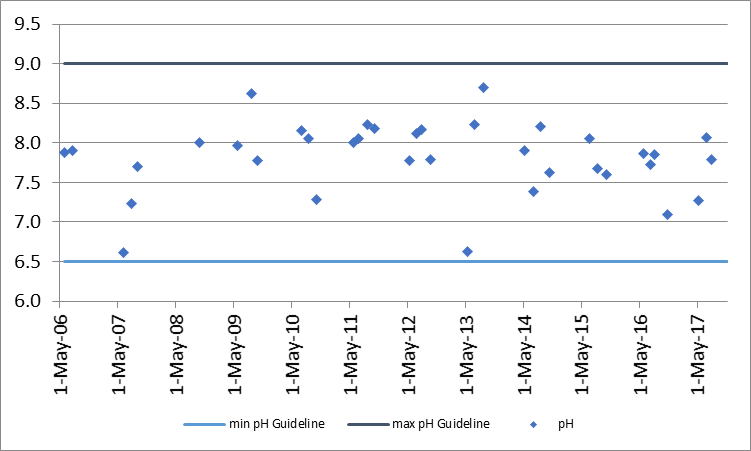
Figure 41 pH concentrations at the deep point site (DP1) on O'Brien Lake, 2006-2017
Table 17 Summary of pH results at the deep point site (DP1) on O'Brien Lake, 2006-2017.
Summary of Water Quality for Fish Habitat in O'Brien Lake
Overall the water chemistry data at the deep point describes suitable habitat conditions for warm water fish species, though these can become limited during warm periods. pH conditions are within the range recommended for the protection of aquatic life. Overall, the data indicates a healthy environment for aquatic species.
2.4.4 O'Brien Lake E. Coli
E. coli is sampled at monitored shoreline sites twice each sampling season. E. coli data was not used in the calculations of the WQI rating for the lake due to differences in sampling frequency and site locations. E. coli data has been summarized in Table 18.
Throughout the 2006-2017 period 100 percent of samples collected by RVCA were below the E. coli guideline of 100 colony forming units (CFU) per 100 ml set by the PWQO; across the lake the count at the geometric mean was 4 CFU/100ml (Table 18). This provides support that there is little indication of bacterial contamination around the lake. Figure 42 show the distribution of counts across all shoreline sites. All sites fell well below the guideline of 100 CFU/100ml.
Table 18 Summary of
E. coli results for O'Brien Lake, 2006-2017
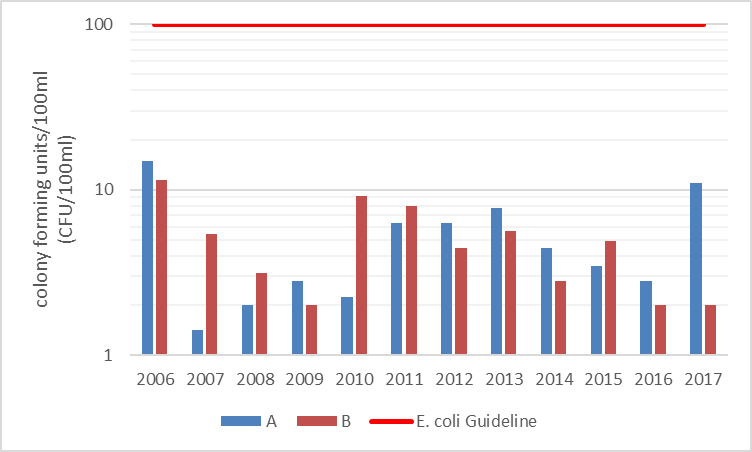
Figure 42 Geometric mean of E.coli counts at shoreline sites monitored on O'Brien Lake, 2006-2017
Summary of O'Brien Lake Bacterial Contamination
The results presented above indicate that bacterial contamination is not a significant concern in O'Brien Lake and the water should be safe for recreational use such as swimming and boating.
2.5 Christie Lake Water Quality
Surface water quality conditions were first monitored in Christie Lake by RVCA’s Watershed Watch Program in 2003. Data from the deep point site (DP1) have been used to calculate the WQI rating for Christie Lake, which averaged “Good to Very Good” over the 2006-2017 period (Table 1). Moderate nutrient concentrations, good oxygen availability and clear water all influenced this rating. The following discussion explains how each of the monitored water quality parameters contributes to the lake’s water quality.
This report also considers data from eight additional shoreline sites that are monitored around the lake. These sites have not been included in the calculation of the CCME WQI rating, as they are not monitored with the same frequency as the deep point site. However, they do provide important information on water quality conditions in the near shore areas. For locations of shoreline sites (A-H), please see Figure 2.
2.5.1 Christie Lake Nutrients
Total phosphorus (TP) is used as a primary indicator of excessive nutrient loading and contributes to abundant aquatic vegetation growth and depleted dissolved oxygen levels. The Provincial Water Quality Objective (PWQO) is used as the TP Guideline and states that in lakes, concentrations greater than 0.020 mg/l indicate an excessive amount of TP within the water column.
Total Kjeldahl nitrogen (TKN) is used as a secondary indicator of nutrient loading. RVCA uses a guideline of 0.500 mg/l to assess TKN[1] within surface waters.
Nutrients at the Christie Lake Deep Point
TP and TKN sampling results collected by the RVCA are presented in Figures 43 to 46. Minimal fluctuations in TP concentrations have occurred (Figures 43 and 44) and there was no significant trend observed in the 2006-2017 data set. All samples analyzed for TP were less than the TP guideline and the average concentration was 0.011 mg/l (Table 19). TKN concentration showed some variability though no significant change was observed (Figures 45 and 46). Ninety-five percent of reported results were below the TKN guideline and the average TKN concentration was 0.343 mg/l (Table 19).
Figure 43 Total phosphorous sampling results at deep point site (DP1) on Christie Lake, 2006-2017
Figure 44 Average total phosphorous results at deep point site (DP1) on Christie Lake, 2006-2017
Figure 45 Total Kjeldahl nitrogen sampling results at deep point site (DP1) on Christie Lake, 2006-2017
Figure 46 Average total Kjeldahl nitrogen results at deep point site (DP1) on Christie Lake, 2006-2017
Table 19 Summary of nutrient results for Christie Lake, 2006-2017.
Overall, the data presented indicates that nutrient concentration may be considered low with very limited instances of elevated concentrations (TKN) in the mid-lake, deep water sites in Christie Lake
Nutrients around Christie Lake
The average nutrient concentrations at monitored shoreline sites around the lake have varied from year to year (Figures 47 and 48). Please note that sites A, E, F and H are monitored each year; while sites B, C, D and G were monitored in 2008 and 2013.
Sites A, E, and H have all had exceedances in various years though the bulk of monitoring results are well below the guideline (Figure 47). TKN concentrations are typically below the guideline, with the exception of samples collected in 2016 (Figure 48).
Figure 47 Average total phosphorous concentrations at shoreline monitoring sites on Christie Lake, 2006-2017
Figure 48 Average total Kjeldahl nitrogen concentrations at shoreline monitoring sites on Christie Lake, 2006-2017
Summary of Christie Lake Nutrients
Christie Lake nutrient data shows that elevated levels of nutrients are not of concern in this waterbody, with the exception of occasional elevated results at various sites. Elevated TKN samples in 2016 may be attributed to runoff following a rain event, as that summer was a period of very high rainfall. It is possible that occasional problems with nutrient enrichment (i.e. algal blooms or excessive plant growth) may be observed in sheltered shallow bays.
Efforts such as the diversion of runoff and enhanced shoreline buffers are important to continue to protect and enhance water quality, and reduce future nutrient increases. Nutrient exceedances may be partially attributed to the natural aging of a lake and basin characteristics. All residents can help minimize their impact on the lake by reducing nutrient inputs through practices such as proper maintenance of septic systems, keeping shorelines natural and using phosphate free soaps and detergents. Promotion of sound stewardship and protection around lake is important to maintain and protect water quality conditions into the future.
2.5.2 Christie Lake Water Clarity
Water clarity is measured using a Secchi disk during each deep point sample. Table 20 summarizes the recorded depths with an average depth of 6.2 m and shows that all readings have exceeded the minimum PWQO of 2 m indicating that algae in the water column are not at excessive levels (good water clarity). Less than 2 m will indicate overproduction in a lake or significant inputs to the water column that are limiting light availability. Figure 49 shows that no individual reading has been below the guideline and measured depths range from 3.2 m to 10.4 m. No significant change was noted in Secchi depth over the 2006-2017 period.
Table 20 Summary of Secchi depths recorded at the deep point site (DP1) on Christie Lake, 2006-2017
Figure 49 Recorded Secchi depths at the deep point site (DP1) on Christie Lake, 2006-2017
Summary of Christie Lake Water Clarity
Waters in Christie Lake are clear and sufficient sunlight is able to penetrate the water column to support aquatic life and provide sufficient visibility for safe recreational use (boating, swimming).
2.5.3 Christie Lake Fish Habitat
Two other factors, dissolved oxygen/temperature and pH were also assessed to provide an overall sense of the health of Christie Lake from a fish habitat perspective.
2.5.3.1 Christie Lake Dissolved Oxygen and Temperature
The red bars in Figure 50 show the depths where suitable conditions exist for warm water fish species (temperature less than 25°C and dissolved oxygen greater than 4 mg/l) at the deep point site. The vertical axis represents the total lake depth at each site where the profile is taken. Suitable conditions typically decline throughout the summer to a depth of approximately 10 m. Overall, no significant change was noted in conditions through the 2006-2017 period.
Figure 50 Depths suitable for warm water fish species at the deep point site (DP1 ) on Christie Lake, 2006-2017.
2.5.3.2 Christie Lake pH
All were within guidelines established by the Canadian Council of Minister's of the Environment which state that pH should be between 6.5 and 9 to protect aquatic life (Table 21, Fgure 51). Surface waters that are found to be more alkaline (higher pH) are common in many regions of the Tay River subwatershed and can generally be attributed to the geology rather than anthropogenic activities. Biological activities such as increased photosynthesis from algal blooms and plant growth may also influence pH. A declining trend was observed in pH concentrations.
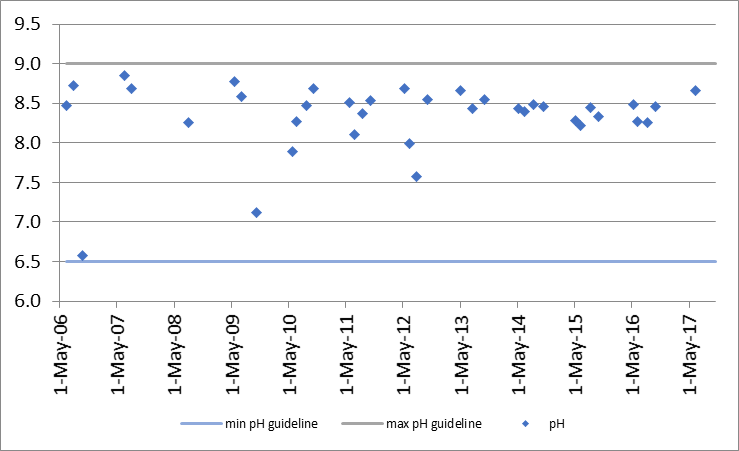
Figure 51 pH concentrations at the deep point site (DP1) on Christie Lake, 2006-2017
Table 21 Summary of pH results at the deep point site (DP1) on Christie Lake, 2006-2017.
Summary of Water Quality for Fish Habitat in Christie Lake
Overall the water chemistry data at the deep point describes suitable habitat conditions for warm water fish species, though these can become limited during warm periods. pH conditions are within the range recommended for the protection of aquatic life. Overall, the data indicates a healthy environment for aquatic species.
2.5.4 Christie Lake E. Coli
E. coli is sampled at monitored shoreline sites twice each sampling season. E. coli data was not used in the calculations of the WQI rating for the lake due to differences in sampling frequency and site locations. E. coli data has been summarized in Table 22.
Throughout the 2006-2017 period 100 percent of samples collected by RVCA were below the E. coli guideline of 100 colony forming units (CFU) per 100 ml set by the PWQO; across the lake the count at the geometric mean was 4 CFU/100ml (Table 18). This provides support that there is little indication of bacterial contamination around the lake. Figure 52 show the distribution of counts across all shoreline sites. All sites fell well below the guideline of 100 CFU/100ml.
Table 22 Summary of
E. coli results for Christie Lake, 2006-2017
Figure 52 Geometric mean of E.coli counts at shoreline sites monitored on Christie Lake, 2006-2017
Summary of Christie Lake Bacterial Contamination
The results presented above indicate that bacterial contamination is not a significant concern in Christie Lake and the water should be safe for recreational use such as swimming and boating.
2.6 Davern Lake Water Quality
Surface water quality conditions were first monitored in Davern Lake by RVCA’s Watershed Watch Program in 2001. Data from the deep point site (DP1) have been used to calculate the WQI rating for Davern Lake, which averaged “Good to Very Good” over the 2006-2017 period (Table 1). Moderate nutrient concentrations, good oxygen availability and clear water all influenced this rating. The following discussion explains how each of the monitored water quality parameters contributes to the lake’s water quality.
This report also considers data from three additional shoreline sites that are monitored around the lake. These sites have not been included in the calculation of the CCME WQI rating, as they are not monitored with the same frequency as the deep point site. However, they do provide important information on water quality conditions in the near shore areas. For locations of shoreline sites (A-C), please see Figure 2.
2.6.1 Davern Lake Nutrients
Total phosphorus (TP) is used as a primary indicator of excessive nutrient loading and contributes to abundant aquatic vegetation growth and depleted dissolved oxygen levels. The Provincial Water Quality Objective (PWQO) is used as the TP Guideline and states that in lakes, concentrations greater than 0.020 mg/l indicate an excessive amount of TP within the water column. Concentrations below 0.010 mg/l are generally considered to be minimal and unlikely to have problems associated with nutrient loading.
Total Kjeldahl nitrogen (TKN) is used as a secondary indicator of nutrient loading. RVCA uses a guideline of 0.500 mg/l to assess TKN within surface waters.
Nutrients at the Davern Lake Deep Point
TP and TKN sampling results collected by the RVCA are presented in Figures 53 to 56. Variability has occurred in the sampled TP concentrations at this site (Figures 53 and 54), however no significant trend was observed in the 2006-2017 dataset. TP results for Davern Lake may be considered low, 98 percent of samples analyzed for TP were less than the TP guideline and the average concentration was 0.014 mg/l (Table 23). One extremely elevated result of 0.220 mg/l was observed on October 8, 2010; due to the significant difference in magnitude it is not shown in Figure 52, though the influence of this value can be see in the elevated average TP concentration for 2010 (Figure 54). TKN concentration also showed variability; however similar to TP results no trend was observed (Figures 55 and 56). Ninety-one percent of reported results were below the TKN guideline and the average TKN concentration was 0.416 mg/l (Table 23).
Figure 53 Total phosphorus sampling results at the deep point site (DP1) in Davern Lake, 2006-2017
Figure 54 Average total phosphorus results at the deep point site (DP1) in Davern Lake, 2006-2017.
Figure 55 Total Kjeldahl nitrogen sampling results at deep point site (DP1) in Davern Lake, 2006-2017
Figure 56 Average total Kjeldahl nitrogen results at the deep point site (DP1) in Davern Lake, 2006-2017.
Table 23 Summary of nutrient results for Davern Lake over the monitoring period, 2006-2017.
Overall, the data presented indicates that nutrient concentrations may be considered low-moderate with few instances of elevated samples in the mid-lake, deep water site.
Nutrients around Davern Lake
The average nutrient concentrations at monitored shoreline sites around the lake vary from year to year (Figures 57 and 58).
Average total phosphorous concentrations are below the TP guideline at all sites (Figure 57). Average TKN concentrations were also typically below the guideline at all monitored sites; with the exception of elevated concentrations at site C in 2015 (Figure 58). At this site it was noted that abundant submergent vegetation was present and that the samples were taken at a natural shoreline with tall grasses.
Figure 57 Average total phosphorous concentrations at shoreline monitoring sites on Davern Lake, 2006-2017.
Figure 58 Average total Kjeldahl nitrogen concentrations at shoreline monitoring sites on Davern Lake, 2006-2017.
Summary of Davern Lake Nutrients
Davern Lake nutrient concentrations are generally below the guidelines, with few samples having elevated results. In the near shore area nutrient loading does not appear to be a concern with the exception of some elevated concentrations that have occurred at site C. Shoreline locations (at monitored sites and around the lake) should be examined to identify if potential sources of nutrient inputs can be reduced through methods such as the diversion or slowing of runoff and enhanced shoreline buffers.
Nutrient exceedances may be partially attributed to the natural aging of a lake and basin characteristics, which occurs as nutrient rich sediment from the surrounding landscape accumulates in the lake over time. Aging of the lake can be slowed with the help of all catchment residents by reducing nutrient inputs through practices such as proper maintenance of septic systems, keeping shorelines natural and using phosphate free soaps and detergents.
2.6.2 Davern Lake Water Clarity
Water clarity is measured using a Secchi disk during each deep point sample. Table 24 summarizes the recorded depths with an average depth of 4.4 m and shows that all readings have exceeded the minimum PWQO of 2m indicating that algae in the water column are not at excessive levels (good water clarity). Less than 2 m will indicate overproduction in a lake or significant inputs to the water column that are limiting light availability. Figure 59 shows that no individual reading has been below the guideline and measured depths range from 2.0 m to 6 m. A declining trend observed in Secchi depths over the 2006-2017 period, indicating that Secchi depths have been reduced over this period.
Table 24 Summary of Secchi depths recorded at the deep point (DP1) on Davern Lake, 2006-2017.
Figure 59 Recorded Secchi depths at the deep point site (DP1) on Davern Lake, 2006-2017.
Summary of Davern Lake Water Clarity
Waters in Davern Lake are clear and sufficient sunlight is able to penetrate the water column to support aquatic life and provide sufficient visibility for safe recreational use (boating, swimming).
2.6.3 Davern Lake Fish Habitat
Two other factors, dissolved oxygen/temperature and pH were also assessed to provide an overall sense of the health of Davern Lake from a fish habitat perspective.
2.6.3.1 Davern Lake Dissolved Oxygen and Temperature
The red bars in Figure 60 show the depths where suitable conditions exist for warm water fish species (temperature less than 25°C and dissolved oxygen greater than 4 mg/l) at the deep point site. The vertical axis represents the total lake depth at each site where the profile is taken. Suitable oxygen temperatures exist over an average depth of 15 m. There is typically a good proportion of the water column available for fish species; habitat conditions do become more limited in the late summer and fall due to depleted of oxygen at deeper depths. Oxygen is depleted in the bottom waters as vegetation matter sinks and undergoes the decaying process.
Figure 60 Depths suitable for warm water fish species at the deep point site (DP1) on Davern Lake, 2006-2017.
2.6.3.2 Davern Lake pH
pH is a basic water quality parameter used to assess the acidity of water, an important factor for aquatic life. Figure 61 shows monitored pH values over the 2006-2017 period.
Figure 61 pH concentrations at the deep point sites (DP1) on Davern Lake, 2006-2017.
All samples (100%, Table 25) were within guidelines established by the Canadian Council of Minister's of the Environment which state that pH should be between 6.5 and 9 to protect aquatic life. So significant change or trend was noted in pH values over the 2006-2017 period. Anthropogenic and biological activities such as increased photosynthesis from algal blooms and plant growth may act to influence pH.
Table 25 Summary of pH results at the deep point site (DP1) on Davern Lake, 2006-2017
Summary of Water Quality for Fish Habitat in Davern Lake
Overall the water chemistry data at the deep point describes suitable habitat conditions for fish species such as bass, walleye and pike. There is some evidence that the warming of the water column in the late summer/fall and limited oxygen availability at deeper depths may minimize the amount of habitat for some more sensitive species. pH conditions are within the range recommended for the protection of aquatic life. Overall, the data indicates a healthy environment for aquatic species.
2.6.4 Davern Lake E. Coli
E. coli is sampled at monitored shoreline sites twice each sampling season. E. coli data was not used in the calculations of the WQI rating for the lake due to differences in sampling frequency and site locations, the results are summarized in Table 26. Throughout the 2006-2017 period 100 percent of samples were below the E. coli guideline of 100 colony forming units (CFU) per 100 ml set by the PWQO; across the lake the count at the geometric mean was 4 CFU/100ml (Table 26).
Table 26 Summary of
E. coli results for Davern Lake, 2006-2017
Figure 62 shows the distribution of counts across all shoreline sites. All sites fell well below the guideline of 100 CFU/100ml.
Figure 62 Geometric mean of E.coli counts at shoreline sites monitored on Davern Lake, 2006-2017
Summary of Davern Lake Bacterial Contamination
The results presented above provide evidence that bacterial contamination is not a significant concern in Davern Lake and the water should be safe for recreational use such as swimming and boating.
2.7 Tay River Water Quality
Two sites along the Tay River in the Chrisite Lake catchment are monitored by the RVCA's Baseline Water Quality Monitoring Program (TAY-15, TAY-16; Figure 2). Analysis of the data is based on samples collected from 2006 to 2017. Table 1 shows water quality at the Bolingbroke site (TAY-16) to be “Very Good” and "Good to Very Good" at the Christie Lake outlet (Tay-15), as determined by the Canadian Council of Ministers of the Environment Water Quality Index (CCME WQI).
The scores at this site indicate favourable water quality conditions, with occasional instances of elevated nutrients and E. coli accounts. For more information on the CCME WQI, please see the Tay River Subwatershed Report. Only those parameters with exceedances that influenced the rating will be discussed in the following sections.
2.7.1 Tay River Nutrients
Total phosphorus (TP) is used as a primary indicator of excessive nutrient loading and may contribute to abundant aquatic vegetation growth and depleted dissolved oxygen levels. The Provincial Water Quality Objective (PWQO) is used as the TP Guideline and states that in streams concentrations greater than 0.030 mg/l indicate an excessive amount of TP.
Total Kjeldahl nitrogen (TKN) is used as a secondary indicator of nutrient loading. RVCA uses a guideline of 0.500 mg/l to assess TKN[1].
Tables 27 and 28 summarize average nutrient concentrations at the monitored sites on this reach of the Tay River and show the proportion of results that meet the guidelines.
Table 27 Summary of total phosphorus results for the Tay River in the Christie Lake catchment, 2006-2017.
Table 28 Summary of total Kjeldahl nitrogen results for the Tay River in the Christie Lake catchment, 2006-2017.
Elevated TP results occurred very rarely at both TAY-16 and TAY-15 throughout the monitoring period; 100% of samples were below the guideline at site TAY-16 and 92% of samples at site TAY-15 (Figures 64 and 68); average concentrations were below the guidelines for each monthly sample (Figures 63 and 67). The average TP concentration was below the guideline at both sites, measuring 0.012 and 0.011 respectively (Table 27). A declining trend was observed in sampled TP concentrations at both sites over the 2006-2017 periods.
The majority of TKN results were also below the guideline (Figure 66 and 70). At site TAY-16, 97% of samples were below the guideline (Figure 66) as were the average monthly samples (Figure 65). At TAY-15, 97% of samples were below the guideline (Figure 70, Table 28) and as with the upstream site (TAY-16) all average concentrations were below the guideline (Figure 69, Table 28). A declining trend was observed in the TKN concentration was noted at site TAY-16, while there was no significant trend in concentrations at TAY-15.
Figure 63 Average monthly total phosphorus concentrations at site TAY-16 in the Tay River, 2006-2017
Figure 64 Distribution of total phosphorus concentrations at site TAY-16 in the Tay River, 2006-2017
Figure 65 Average monthly total Kjeldahl nitrogen concentrations at site TAY-16 in the Tay River, 2006-2017.
Figure 66 Distribution of total Kjeldahl nitrogen concentrations at site TAY-16 in the Tay River, 2006-2017
Figure 67 Average monthly total phosphorus concentrations at site TAY-15 in the Tay River, 2006-2017.
Figure 68 Distribution of total phosphorus concentrations at site TAY-15 in the Tay River, 2006-2017
Figure 69 Average monthly total Kjeldahl nitrogen concentrations at site TAY-15 in the Tay River, 2006-2017.
Figure 70 Distribution of total Kjeldahl nitrogen concentrations at site TAY-15 in the Tay River, 2006-2017
Summary of Tay River Nutrients
This sites along the Tay River have few instances of elevated nutrient concentrations. Overall, a declining trend in both total phosphorus and nitrogen was observed at the upstream site (TAY-16); this trend continued at the downstream site at the outlet to Christie Lake (TAY-15) for sampled TP concentrations. No change was noted in TKN concentrations. While nutrient enrichment is not an issue in this reach of the river, it is important to maintain and adopt good stewardship to ensure good water quality continues into the future. Best management practices such as minimizing storm water runoff, enhanced shoreline buffers, minimizing/discontinuing the use of fertilizers and restricting livestock access in both surrounding agricultural and developed areas can help to reduce additional nutrient enrichment within the Tay River.
2.7.2 Tay River E. coli
Escherichia coli (E. coli) is used as an indicator of bacterial pollution from human or animal waste; in elevated concentrations it can pose a risk to human health. The PWQO of 100 colony forming units/100 millilitres (CFU/100 ml) is used as a guideline. E. coli counts greater than this guideline indicate that bacterial contamination may be a problem within a waterbody.
Table 29 summarizes the geometric means[3] for the monitored sites on the Tay River and show the proportion of samples that meet the E. coli guideline of 100 CFU/100 ml. The results of the geometric mean with respect to the guideline for the 2006-2017 period are shown in Figures 71-74.
Table 29 Summary of
E. coli results for the Tay River in the Christie Lake catchment, 2006-2017
E. coli counts at both sites show that there has been no significant trend in bacterial counts (Figures 72 and 74). At TAY-16 the count at the geometric mean was 10 (Table 29), and all results (100 percent) were below the E. coli guideline. Figure 71 shows that there are slight variations in the counts throughout the monitored seasons. Results at site TAY-15 are very similar to the upstream site, counts at the geometric mean were very low at 8 CFU/100ml (Table 29), with monthly means comparable across the monitoring period (Figure 73).
Figure 71 Geometric mean of monthly E. coli counts at TAY-16 in the Tay River, 2006-2017.
Figure 72 Distribution of E. coli counts at TAY-16 in the Tay River, 2006-2017
Figure 73 Geometric mean of monthly E. coli counts at TAY-15 in the Tay River, 2006-2017.
Figure 74 Distribution of E. coli counts at TAY-15 in the Tay River, 2006-2017
Summary of Tay River Bacterial Contamination
Bacterial contamination does not appear to be a significant concern in this reach of the Tay River. Best management practices such as enhancing shoreline buffers, limiting livestock access and minimizing runoff in both rural and developed areas can help to protect this reach of the Tay River into the future.
[1] No Ontario guideline for TKN is presently available; however, waters not influenced by excessive organic inputs typically range from 0.100 to 0.500 mg/l, Environment Canada (1979) Water Quality Sourcebook, A Guide to Water Quality Parameters, Inland Waters Directorate, Water Quality Branch, Ottawa, Canada
[2] Trends were determined using the Mann-Kendall trend test and Sens slope estimator
[3] A type of mean or average, which indicates the central tendency or typical value of a set of numbers by using the product of their values (as opposed to the arithmetic mean which uses their sum). It is often used to summarize a variable that varies over several orders of magnitude, such as E. coli counts.
3.0 Christie Lake Catchment: Riparian Conditions
The Stream Characterization Program evaluated 5.2 km of the Tay River in 2017 in the Christie Lake catchment. A total of 52 stream survey assessments were completed in the middle of June and July from Bolingbroke Dam to where the Tay River flows into Christie Lake. The Tay River watershed experienced high water levels along the Tay River and its tributaries. In addition many of the Tay watershed lakes also experienced prolonged high water levels including Christie Lake (see photo below). Several roads were temporarily closed due to flooding in the catchment.
Jordans Bridge at Christie Lake on May 12th, 2017
3.1 Tay River River Overbank Zone
3.1.1 Riparian Buffer Evaluation
The quality of the riparian area increases with the width, complexity and linear extent of its vegetation along a stream or creek. A complex riparian community consists of diverse plant species native to the site, with multiple age-classes providing vertical structural diversity along a watercourse.
Here is a list of watershed benefits from a healthy riparian buffer zone:
- Reduces the amount of pollutants that reach the stream from surface runoff
- Helps reduce and mitigates erosion
- Provides a microclimate that is cooler during the summer months providing cooler water for aquatic organisms
- Provides large wood structure from fallen trees and limbs that form instream cover, create pools, stabilize the streambed, and provide habitat for aquatic organisms
- Provides organic material for stream biota that, among other functions, is the base of the food chain in lower order streams
- Provides habitat for terrestrial insects that drop in the stream and become food for fish and travel corridors for other terrestrial animals
- Dissipates energy during flood events
- Often provides the only refuge areas for fish during out-of-bank flows (behind trees, stumps, and logs)
Figure 74 demonstrates the buffer conditions of the left and right banks separately. The Tay River had a buffer of greater than 30 meters along 90 percent of the left bank and 86 percent of the right bank.
Figure 74 Riparian Buffer Evaluation along the Tay River in the Christie Lake catchment
3.1.2 Riparian Buffer Alterations
Alterations within the riparian buffer were assessed within three distinct shoreline zones (0-5m, 5-15m, 15-30m), and evaluated based on the dominant vegetative community and/or land cover type (Figure 75). The riparian buffer zone along the Tay River was found to be dominated by forest, scrubland and wetland conditions. There were two areas that had altered riparian zone conditions along the Tay River.
Figure 75 Riparian buffer alterations along the Tay River in the Christie Lake catchment
3.1.3 Adjacent Land Use
The RVCA’s Stream Characterization Program identifies ten different land uses along the Tay River (Figure 76). Surrounding land use is considered from the beginning to end of the survey section (100m) and up to 100m on each side of the river. Land use outside of this area is not considered for the surveys but is nonetheless part of the subwatershed and will influence the river. Forest habitat was dominant at 96 percent; scrubland was found along 87 percent of the surveyed sections, wetland habitat was observed along 73 percent of the system and 17 percent meadow habitat was present along the Tay River. The remaining land use consisted of residential, pasture, abandoned agriculture, recreational and infrastructure in the form of road crossings.
Figure 76 Land Use along the Tay River in the Christie Lake catchment
3.2 Tay River Shoreline Zone
3.2.1 Instream Erosion
Stream erosion is the process by which water erodes and transports sediments, resulting in dynamic flows and diverse habitat conditions. Excessive erosion can result in drastic environmental changes, as habitat conditions, water quality and aquatic life are all negatively affected. Bank stability was assessed as the overall extent of each section with “unstable” shoreline conditions. These conditions are defined by the presence of significant exposed soils/roots, minimal bank vegetation, severe undercutting, slumping or scour and potential failed erosion measures. The majority of the Tay River had no erosion observed along the surveyed sections with a few small sections having low to moderate levels of erosion (Figure 77).
Figure 77 Erosion levels along the Tay River in the Christie Lake catchment
3.2.2 Undercut Stream Banks
Stream bank undercuts can provide excellent cover habitat for aquatic life, however excessive levels can be an indication of unstable shoreline conditions. Bank undercut was assessed as the overall extent of each surveyed section with overhanging bank cover present. Figure 78 shows that the Tay River had no observed undercut banks along the majority of the system, however there were several sections in the upper and middle reaches with low to moderate levels of undercut banks. Moderate levels were observed immediately downstream of the Bolingbroke dam.
Figure 78 Undercut stream banks along the Tay River in the Christie Lake catchment
3.2.3 Stream Shading
Grasses, shrubs and trees all contribute towards shading a stream. Shade is important in moderating stream temperature, contributing to food supply and helping with nutrient reduction within a stream. Stream cover is assessed as the total coverage area in each section that is shaded by overhanging shrubs/grasses and tree canopy, at greater than 1m above the water surface. Figure 79 shows low levels of stream shading along the majority of the Tay River in the middle and lower reaches, which is consistent with wide open wetland habitat conditions. There were several sections in the upper reaches, where the channel narrows, that had high to moderate levels of stream shading along the Tay River downstream of the Bolingbroke Dam.
Figure 79 Stream shading along the Tay River in the Christie Lake catchment
Tay River with high levels of stream shading, downstream of the Bolingbroke Dam
3.2.4 Instream Wood Structure
Forested shorelines provide essential complex habitat through the perpetual process of shoreline trees falling into the water. This continuous recruitment of trees creates a wood-based physical structure in the littoral zone that is common on natural systems. Insects, fish, amphibians, birds, and other animals have also evolved with this abundance of near shore wood and it is essential to their life cycles. With increased development along many waterways, forested lakeshores have been altered and wood-based physical structure in many waterways has been reduced. It is important to restore this essential habitat to aquatic ecosystems.
Shoreline Protection
- Protects shorelines by providing a barrier from wind and wave erosion
- Reduces sedimentation of the water caused by shoreline slumping due to bank erosion
- Allows detritus to collect and settle on the lake or creek bed providing the substrate structure required for native aquatic vegetation to establish and outcompete invasive species
Food Source
- Wood complexes are an important food source for invertebrates
- Small fish feed on the abundance of invertebrates that are found around these structures
- Larger fish, waterfowl and shorebirds all benefit from the abundance of invertebrates and small fish feeding around woody structures in the littoral zone
Cover
- Cover from predators is essential for many fish and animals to successfully complete their life cycle
- The nooks and crannies of wood complexes offer critters safety from predators while at the same time concentrating prey to make predators more efficient
- Wood provides the structure on which many species must lay or attach their eggs, therefore these complexes provide quality spawning and nesting habitat
Diversity
- Wood complexes in the littoral zone provide unique edge habitat along the shoreline
- Edge habitats contain more species diversity and higher concentrations of species than the adjoining habitats themselves will have
Figure 80 shows that the majority of the Tay River had low levels of instream wood structure along the system. There were several stream survey sections in the middle reach which were characterized as having moderate levels of instream wood structure in the form of branches and trees along the system.
Figure 80 Instream wood structure along the Tay River in the Christie Lake catchment
3.2.5 Overhanging Wood Structure
Trees and branches that are less than one meter from the surface of the water are defined as overhanging. Overhanging wood structure provide a food source, nutrients and shade which helps to moderate instream water temperatures. Figure 81 shows the system is highly variable with no overhanging branches and trees where the river is wide and is dominated by wetland habitat to areas that have high levels of overhanging wood structure along the Tay River.
Figure 81 Overhanging wood structure along the Tay River in the Christie Lake catchment
3.2.6 Anthropogenic Alterations
Stream alterations are classified based on specific functional criteria associated with the flow conditions, the riparian buffer and potential human influences. Figure 82 shows ninety-two percent of the Tay River remains “unaltered” with no anthropogenic alterations. Eight percent of the Tay River was classified as natural with minor anthropogenic changes. The alterations along the Tay River were in the form of shoreline modifications and road crossings. There were no sections that were classified as being altered and highly altered.
Figure 82 Anthropogenic alterations along the Tay River in the Christie Lake catchment
3.3 Tay River Instream Aquatic Habitat
3.3.1 Benthic Invertebrates
Freshwater benthic invertebrates are animals without backbones that live on the stream bottom and include crustaceans such as crayfish, molluscs and immature forms of aquatic insects. Benthos represent an extremely diverse group of aquatic animals and exhibit wide ranges of responses to stressors such as organic pollutants, sediments and toxicants, which allows scientists to use them as bioindicators. As part of the Ontario Benthic Biomonitoring Network (OBBN), the RVCA has been collecting benthic invertebrates at the Crow Lake Road site since 2003. Monitoring data is analyzed for each sample site and the results are presented using the Family Biotic Index, Family Richness and percent Ephemeroptera, Plecoptera and Trichoptera.
OBBN site, replicate number 3 at the Crow Lake Road
Hilsenhoff Family Biotic Index
The Hilsenhoff Family Biotic Index (FBI) is an indicator of organic and nutrient pollution and provides an estimate of water quality conditions for each site using established pollution tolerance values for benthic invertebrates. FBI results for the Christie Lake - Tay River catchment at the Crow Lake Road sample location is summarized by year. “Good” to “Excellent” water quality conditions were observed at the Tay River sample location (Figure 83) using a grading scheme developed by Conservation Authorities in Ontario for benthic invertebrates.
Figure 83 Hilsenhoff Family Biotic Index at the Crow Lake Road sample location
Family Richness
Family Richness measures the health of the community through its diversity and increases with increasing habitat diversity suitability and healthy water quality conditions. Family Richness is equivalent to the total number of benthic invertebrate families found within a sample. The Crow Lake Road location is reported to have “Fair” family richness (Figure 84).
Figure 84 Family Richness at the Crow Lake Road sample location
EPT
Ephemeroptera (Mayflies), Plecoptera (Stoneflies), and Trichoptera (Caddisflies) are species considered to be very sensitive to poor water quality conditions. High abundance of these organisms is generally an indication of good water quality conditions at a sample location. The community structure is typically dominated by species that are sensitive to poor water quality conditions. As a result, the EPT indicates that the Christie Lake - Tay River sample location is reported to have “Good” water quality (Figure 85) during the reporting periods.
Figure 85 EPT on the Tay River at the Crow Lake Road sample location
Summary of Water Quality for Benthic Invertebrates in the Tay River
Overall, the Tay River site in the Christie Lake catchment from a benthic invertebrate perspective is considered “Good” as the samples are dominated with species that are sensitive to high organic pollution levels.
3.3.2 Habitat Complexity
Habitat complexity is a measure of the overall diversity of habitat types and features within a stream. Streams with high habitat complexity support a greater variety of species niches, and therefore contribute to greater diversity. Factors such as substrate, flow conditions (pools, riffles) and cover material (vegetation, wood structure, etc.) all provide crucial habitat to aquatic life. Habitat complexity is assessed based on the presence of boulder, cobble and gravel substrates, as well as the presence of instream wood structure.
Moderate to high habitat complexity was identified for the Tay River in the catchment (Figure 86). Regions with increased habitat complexity were observed throughout the reaches of the system within the catchment.
Figure 86 Habitat complexity along the Tay River in the Christie Lake catchment
3.3.3 Instream Substrate
Diverse substrate is important for fish and benthic invertebrate habitat because some species have specific substrate requirements and for example will only reproduce on certain types of substrate. The absence of diverse substrate types may limit the overall diversity of species within a stream. Substrate conditions were highly diverse along the Tay River with most substrate types being recorded at various locations along the system (Figure 87). The dominant substrate type observed for each section surveyed along the Tay River is shown in Figure 88.
Figure 87 Instream substrate along the Tay River in the Christie Lake catchment
Figure 88 shows the dominant substrate type along the Tay River in the Christie Lake catchment
3.3.4 Instream Morphology
Pools and riffles are important habitat features for aquatic life. Riffles are fast flowing areas characterized by agitation and overturn of the water surface. Riffles thereby play a crucial role in contributing to dissolved oxygen conditions and directly support spawning for some fish species. They are also areas that support high benthic invertebrate populations which are an important food source for many aquatic species. Pools are characterized by minimal flows, with relatively deep water and winter/summer refuge habitat for aquatic species. Runs are moderately shallow, with unagitated surfaces of water and areas where the thalweg (deepest part of the channel) is in the center of the channel. Figure 89 shows that the Tay River is variable; 94 percent of sections recorded runs, 29 percent pools and 23 percent riffles. Figure 90 shows where the riffle habitat areas were observed along the Tay River.
Figure 89 Instream morphology along the Tay River in the Christie Lake catchment
Figure 90 Instream riffle habitat along the Tay River in the Christie Lake catchment
3.3.5 Vegetation Type
Instream vegetation provides a variety of functions and is a critical component of the aquatic ecosystem. Aquatic plants promote stream health by:
- Providing direct riparian/instream habitat
- Stabilizing flows reducing shoreline erosion
- Contributing to dissolved oxygen through photosynthesis
- Maintaining temperature conditions through shading
For example, emergent plants along the shoreline can provide shoreline protection from wave action and important rearing habitat for species of waterfowl. Submerged plants provide habitat for fish to find shelter from predator fish while they feed. Floating plants such as water lilies shade the water and can keep temperatures cool while reducing algae growth. Narrow leaved emergents were observed in 96 percent of sections, submerged plants and robust emergents were both present in 87 percent of the survey sections, 73 percent of sections contained algae, 69 percent floating plants and 58 percent broad leaved emergents. Figure 91 depicts the plant community structure for the Tay River. Figure 92 shows the dominant vegetation type observed for each section surveyed along the Tay River in the Christie Lake catchment.
Figure 91 Vegetation type along the Tay River in the Christie Lake catchment
Figure 92 Dominant vegetation type along the Tay River in the Christie Lake catchment
3.3.6 Instream Vegetation Abundance
Instream vegetation is an important factor for a healthy stream ecosystem. Vegetation helps to remove contaminants from the water, contributes oxygen to the stream, and provides habitat for fish and wildlife. Too much vegetation can also be detrimental. Figure 93 demonstrates that the Tay River had normal to common levels of vegetation recorded at 29 and 42 percent of stream surveys. Extensive levels of vegetation were observed in 54 percent of the surveyed sections and were consistent with areas dominated by the invasive aquatic plant known as European frogbit; while thirteen percent of sections had no vegetation in areas.
Figure 93 Instream vegetation abundance along the Tay River in the Christie Lake catchment
3.3.7 Invasive Species
Invasive species can have major implications on streams and species diversity. Invasive species are one of the largest threats to ecosystems throughout Ontario and can out compete native species, having negative effects on local wildlife, fish and plant populations. Ninety percent of the sections surveyed along the Tay River in the Christie Lake catchment had invasive species. The invasive species observed were European frogbit, banded mystery snail, purple loosestrife and common/glossy buckthorn. Invasive species abundance (i.e. the number of observed invasive species per section) was assessed to determine the potential range/vector of many of these species (Figure 94).
Figure 94 Invasive species abundance along the Tay River in the Christie Lake catchment
3.3.8 Water Chemistry
During the stream characterization survey, a YSI probe is used to collect water chemistry information. Dissolved oxygen (DO), specific conductivity (SPC) and pH are measured at the start and end of each section.
3.3.8.1 Dissolved Oxygen
Dissolved oxygen is a measure of the amount of oxygen dissolved in water. The Canadian Environmental Quality Guidelines of the Canadian Council of Ministers of the Environment (CCME) suggest that for the protection of aquatic life the lowest acceptable dissolved oxygen concentration should be 6 mg/L for warmwater biota and 9.5 mg/L for coldwater biota (CCME, 1999). Figure 95 shows that the dissolved oxygen in Tay River supports warmwater and in certain locations coldwater biota along the system. The average dissolved oxygen level observed within Christie Lake - Tay River catchment was 9.2mg/L which meets the recommended level for warm and cool water biota.
Figure 95 Dissolved oxygen ranges along the Tay River in the Christie Lake catchment
3.3.8.2 Conductivity
Conductivity in streams is primarily influenced by the geology of the surrounding environment, but can vary drastically as a function of surface water runoff. Currently there are no CCME guideline standards for stream conductivity; however readings which are outside the normal range observed within the system are often an indication of unmitigated discharge and/or stormwater input. The average conductivity observed within the Tay River was 138.7 µs/cm. Figure 96 shows the conductivity readings for the Tay River in the Christie Lake catchment.
Figure 96 Specific conductivity ranges in the Tay River in the Christie Lake catchment
3.3.8.3 pH
Based on the PWQO for pH, a range of 6.5 to 8.5 should be maintained for the protection of aquatic life. Average pH values along the Tay River were 7.94 thereby meeting the provincial standard (Figure 97).
Figure 97 pH ranges along the Tay River in the Christie Lake catchment
3.3.8.4 Oxygen Saturation (%)
Oxygen saturation is measured as the ratio of dissolved oxygen relative to the maximum amount of oxygen that will dissolve based on the temperature and atmospheric pressure. Well oxygenated water will stabilize at or above 100% saturation, however the presence of decaying matter/pollutants can drastically reduce these levels. Oxygen input through photosynthesis has the potential to increase saturation above 100% to a maximum of 500%, depending on the productivity level of the environment. In order to represent the relationship between concentration and saturation, the measured values have been summarized into 6 classes:
Figure 98 portrays dissolved oxygen conditions in the upper reach of the Tay River and system variability from Bobs Lake to Christie Lake.
Figure 98 A bivariate assessment of dissolved oxygen concentration (mg/L) and saturation (%) in the Tay River in the Christie Lake catchment
3.3.8.5 Specific Conductivity Assessment
Specific conductivity (SPC) is a standardized measure of electrical conductance, collected at or corrected to a water temperature of 25⁰C. SPC is directly related to the concentration of ions in water, and is commonly influenced by the presence of dissolved salts, alkalis, chlorides, sulfides and carbonate compounds. The higher the concentration of these compounds, the higher the conductivity. Common sources of elevated conductivity include storm water, agricultural inputs and commercial/industrial effluents.
In order to summarize the conditions observed, SPC levels were evaluated as either normal, moderately elevated or highly elevated. These categories correspond directly to the degree of variation (i.e. standard deviation) at each site relative to the average across the system.
Normal levels were maintained in the middle reaches of the Tay River, however there were moderately elevated areas in the upper and lower reaches (Figure 99). One section had high conductivity levels observed in the upper reach and was consistent with an area with stream bank erosion observations.
Figure 99 Relative specific conductivity levels along the Tay River in the Christie Lake catchment
3.3.9 Thermal Regime
Many factors can influence fluctuations in stream temperature, including springs, tributaries, precipitation runoff, discharge pipes and stream shading from riparian vegetation. Water temperature is used along with the maximum air temperature (using the Stoneman and Jones method) to classify a watercourse as either warm water, cool water or cold water. Figure 100 shows where the thermal sampling sites were located on the Tay River in the Christie Lake catchment. Analysis of the data collected indicates that the Tay River is classified as a warm water system (Figure 101).
Figure 100 Temperature logger locations along the Tay River in the Christie Lake catchment
Figure 101 Temperature logger data for the sites along the Tay River in the Christie Lake catchment
Each point on the graph represents a temperature that meets the following criteria:
- Sampling dates between July 1st and September 7th
- Sampling date is preceded by two consecutive days above 24.5 °C, with no rain
- Water temperatures are collected at 4pm
- Air temperature is recorded as the max temperature for that day
3.3.10 Groundwater
Groundwater discharge areas can influence stream temperature, contribute nutrients, and provide important stream habitat for fish and other biota. During stream surveys, indicators of groundwater discharge are noted when observed. Indicators include: springs/seeps, watercress, iron staining, significant temperature change and rainbow mineral film. Figure 102 shows areas where one or more of the above groundwater indicators were observed during stream surveys and headwater assessments.
Figure 102 Groundwater indicators observed in the Christie Lake catchment
3.3.11 Fish Community
The Tay River Christie Lake catchment is classified as a mixed community of warm and cool water recreational and baitfish fishery with 22 species observed. Table 30 contains a list of species identified in the watershed and Figure 103 shows the location of those observations.
Table 30 Fish species observed in the Christie Lake catchment
Figure 103 Fish Community sampling observations along the Tay River in 2017
RVCA fish sampling site on the Tay River
3.3.12 Migratory Obstructions
It is important to know locations of migratory obstructions because these can prevent fish from accessing important spawning and rearing habitat. Migratory obstructions can be natural or man-made, and they can be permanent or seasonal. Figure 104 shows that Christie Lake catchment had six perched culverts and one dam on headwater drainage features within the catchment. The Bolingbroke Dam at the outlet of Bobs Lake is located immediately upstream of where the surveys were completed along the Tay River.
Figure 104 Migratory obstructions in the Christie Lake catchment
3.3.13 Beaver Dams
Overall beaver dams create natural changes in the environment. Some of the benefits include providing habitat for wildlife, flood control, and silt retention. Additional benefits come from bacterial decomposition of woody material used in the dams which removes excess nutrient and toxins. Beaver dams can also result in flooding of agricultural lands and may be potential barriers to fish migration. Two beaver dams were identified on headwater drainage features in the Christie Lake catchment at the time of the survey (Figure 105).
Figure 105 Beaver Dam type and locations in the Christie Lake catchment
3.3.14 Riparian Restoration
Figure 106 depicts the locations of riparian restoration opportunities as a result of observations made during the stream survey. Several riparian planting opportunities were identified in the Christie Lake catchment.
Figure 106 Riparian restoration opportunities along the Tay River in the Christie Lake catchment
3.4 Headwater Drainage Feature Assessment
3.4.1 Headwaters Sampling Locations
The RVCA Stream Characterization program assessed Headwater Drainage Features for the Christie Lake - Tay River catchment in 2016. This protocol measures zero, first and second order headwater drainage features (HDF). It is a rapid assessment method characterizing the amount of water, sediment transport, and storage capacity within headwater drainage features (HDF). RVCA is working with other Conservation Authorities and the Ministry of Natural Resources and Forestry to implement the protocol with the goal of providing standard datasets to support science development and monitoring of headwater drainage features. An HDF is a depression in the land that conveys surface flow. Additionally, this module provides a means of characterizing the connectivity, form and unique features associated with each HDF (OSAP Protocol, 2013). In 2016 the program sampled 29 sites at road crossings in the Christie Lake catchment area (Figure 107).
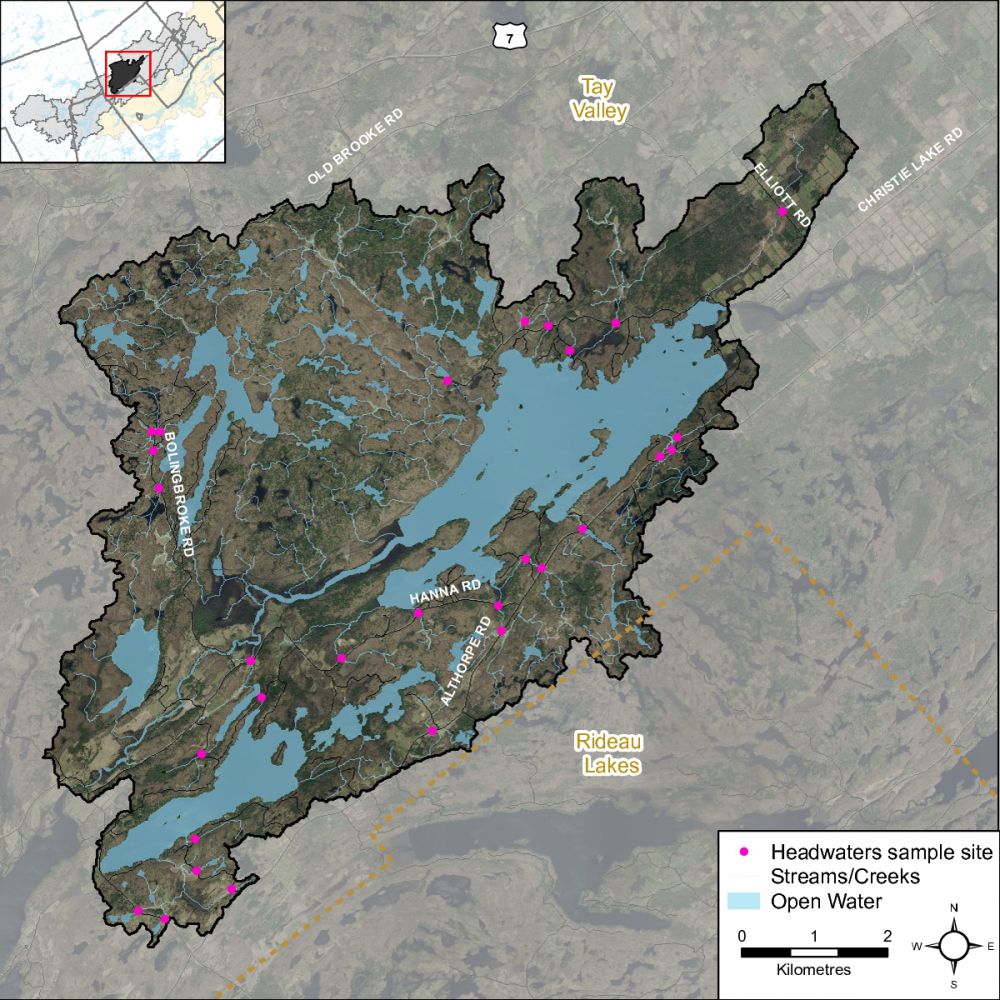
Figure 107 Location of the headwater sampling sites in the Christie Lake catchment
3.4.2 Headwater Feature Type
The headwater sampling protocol assesses the feature type in order to understand the function of each feature. The evaluation includes the following classifications: defined natural channel, channelized or constrained, multi-thread, no defined feature, tiled, wetland, swale, roadside ditch and pond outlet. By assessing the values associated with the headwater drainage features in the catchment area we can understand the ecosystem services that they provide to the watershed in the form of hydrology, sediment transport, and aquatic and terrestrial functions. The headwater drainage features in the Christie Lake catchment are dominated by natural and wetland features. Figure 108 shows the feature type of the primary feature at the sampling locations.
Figure 108 Headwater feature types in the Christie Lake catchment
3.4.3 Headwater Feature Flow
The observed flow condition within headwater drainage features can be highly variable depending on timing relative to the spring freshet, recent rainfall, soil moisture, etc. Flow conditions are assessed in the spring and in the summer to determine if features are perennial and flow year round, if they are intermittent and dry up during the summer months or if they are ephemeral systems that do not flow regularly and generally respond to specific rainstorm events or snowmelt. Flow conditions in headwater systems can change from year to year depending on local precipitation patterns. Even though the subwatershed was in a drought condition in 2016 most features were flowing in the summer months. Figure 109 shows the observed flow condition at the sampling locations in the Christie Lake catchment.
Figure 109 Headwater feature flow conditions in the Christie Lake catchment
A spring photo of the headwater sample site in the Christie Lake catchment located on Hanna Road
A summer photo of the headwater sample site in the Christie Lake catchment located on Hanna Road
3.4.4 Feature Channel Modifications
Channel modifications were assessed at each headwater drainage feature sampling location. Modifications include channelization, dredging, hardening and realignments. The Christie Lake catchment area had a majority of features with no channel modifications observed, two sites as having been historically dredged/channelized and two locations had mixed modifications. Figure 110 shows the channel modifications observed at the sampling locations in the catchment.
Figure 110 Headwater feature channel modifications in the Christie Lake catchment
3.4.5 Headwater Feature Vegetation
Headwater feature vegetation evaluates the type of vegetation that is found within the drainage feature. The type of vegetated within the channel influences the aquatic and terrestrial ecosystem values that the feature provides. For some types of headwater features the vegetation within the feature plays a very important role in flow and sediment movement and provides wildlife habitat. Figure 111 depicts the dominant vegetation observed at the sampled headwater sites in the Christie Lake catchment.
Figure 111 Headwater feature vegetation types in the Christie Lake catchment
3.4.6 Headwater Feature Riparian Vegetation
Headwater riparian vegetation evaluates the type of vegetation that is found along the adjacent lands of a headwater drainage feature. The type of vegetation within the riparian corridor influences the aquatic and terrestrial ecosystem values that the feature provides to the watershed. Figure 112 sepicts the type of riparian vegetation observed at the sampled headwater sites in the Christie Lake catchment.
Figure 112 Headwater feature riparian vegetation types in the Christie Lake catchment
3.4.7 Headwater Feature Sediment Deposition
Assessing the amount of recent sediment deposited in a channel provides an index of the degree to which the feature could be transporting sediment to downstream reaches (OSAP, 2013). Evidence of excessive sediment deposition might indicate the requirement to follow up with more detailed targeted assessments upstream of the site location to identify potential best management practices to be implemented. Sediment deposition ranged from none to substantial for the headwater sites sampled in the catchment. Figure 113 depicts the degree of sediment deposition observed at the sampled headwater sites in the Christie Lake catchment. Sediment deposition conditions ranged from no sediment deposition to extensive.
Figure 113 Headwater feature sediment deposition in the Christie Lake catchment
3.4.8 Headwater Feature Upstream Roughness
Feature roughness will provide a measure of the amount of materials within the bankfull channel that could slow down the velocity of water flowing within the headwater feature (OSAP, 2013). Materials on the channel bottom that provide roughness include vegetation, woody debris and structure and boulders/cobble substrates. Roughness can provide benefits in mitigating downstream erosion on the headwater drainage feature and the receiving watercourse by reducing velocities. Roughness also provides important habitat conditions for aquatic organisms. Figure 114 shows the feature roughness conditions at the sampling locations in the Christie Lake catchment were highly variable ranging from minimal to extreme.
Figure 114 Headwater feature roughness in the Christie Lake catchment
4.0 Christie Lake Catchment: Land Cover
Land cover and any change in coverage that has occurred over a six year period is summarized for the Chrisitie Lake catchment using spatially continuous vector data representing the catchment during the spring of 2008 and 2014. This dataset was developed by the RVCA through heads-up digitization of 20cm DRAPE ortho-imagery at a 1:4000 scale and details the surrounding landscape using 10 land cover classes.
4.1 Christie Lake Catchment Land Cover/Change
As shown in Table 31 and Figure 1, the dominant land cover type in 2014 is woodland.
Table 31 Land cover in the Christie Lake catchment (2008 vs. 2014)
* Does not include treed swamps ** Includes treed swamps
From 2008 to 2014, there was an overall change of four hectares (from one land cover class to another). Most of the change in the Christie Lake catchment is a result of crop and pastureland and woodland being converted to settlement along with woodland reverting to wetland (Figure 115).
Figure 115 Land cover change in the Christie Lake catchment (2008 to 2014)
Table 32 provides a detailed breakdown of all land cover change that has taken place in the Christie Lake catchment between 2008 and 2014.
Table 32 Land cover change in the Christie Lake catchment (2008 to 2014)
4.2 Woodland Cover
In the Environment Canada Guideline (Third Edition) entitled “How Much Habitat Is Enough?” (hereafter referred to as the “Guideline”) the opening narrative under the Forest Habitat Guidelines section states that prior to European settlement, forest was the predominant habitat in the Mixedwood Plains ecozone. The remnants of this once vast forest now exist in a fragmented state in many areas (including the Rideau Valley watershed) with woodland patches of various sizes distributed across the settled landscape along with higher levels of forest cover associated with features such as the Frontenac Axis (within the on-Shield areas of the Rideau Lakes and Tay River subwatersheds). The forest legacy, in terms of the many types of wildlife species found, overall species richness, ecological functions provided and ecosystem complexity is still evident in the patches and regional forest matrices (found in the Tay River subwatershed and elsewhere in the Rideau Valley watershed). These ecological features are in addition to other influences which forests have on water quality and stream hydrology including reducing soil erosion, producing oxygen, storing carbon along with many other ecological services that are essential not only for wildlife but for human well-being.
The Guideline also notes that forests provide a great many habitat niches that are in turn occupied by a great diversity of plant and animal species. They provide food, water and shelter for these species - whether they are breeding and resident locally or using forest cover to help them move across the landscape. This diversity of species includes many that are considered to be species at risk. Furthermore, from a wildlife perspective, there is increasing evidence that the total forest cover in a given area is a major predictor of the persistence and size of bird populations, and it is possible or perhaps likely that this pattern extends to other flora and fauna groups. The overall effect of a decrease in forest cover on birds in fragmented landscapes is that certain species disappear and many of the remaining ones become rare, or fail to reproduce, while species adapted to more open and successional habitats, as well as those that are more tolerant to human-induced disturbances in general, are able to persist and in some cases thrive. Species with specialized-habitat requirements are most likely to be adversely affected. The overall pattern of distribution of forest cover, the shape, area and juxtaposition of remaining forest patches and the quality of forest cover also play major roles in determining how valuable forests will be to wildlife and people alike.
The current science generally supports minimum forest habitat requirements between 30 and 50 percent, with some limited evidence that the upper limit may be even higher, depending on the organism/species phenomenon under investigation or land-use/resource management planning regime being considered/used.
As shown in Figure 116, 57 percent of the Christie Lake catchment contains 3697 hectares of upland forest and 35 hectares of lowland forest (treed swamps) versus the 47 percent of woodland cover in the Tay River subwatershed. This is greater than the 30 percent of forest cover that is identified as the minimum threshold required to sustain forest birds according to the Guideline and which may only support less than one half of potential species richness and marginally healthy aquatic systems. When forest cover drops below 30 percent, forest birds tend to disappear as breeders across the landscape.
Figure 116 Woodland cover and forest interior in the Christie Lake catchment (2014)
4.2.1 Woodland (Patch) Size
According to the Ministry of Natural Resources’ Natural Heritage Reference Manual (Second Edition), larger woodlands are more likely to contain a greater diversity of plant and animal species and communities than smaller woodlands and have a greater relative importance for mobile animal species such as forest birds.
Bigger forests often provide a different type of habitat. Many forest birds breed far more successfully in larger forests than they do in smaller woodlots and some rely heavily on forest interior conditions. Populations are often healthier in regions with more forest cover and where forest fragments are grouped closely together or connected by corridors of natural habitat. Small forests support small numbers of wildlife. Some species are “area-sensitive” and tend not to inhabit small woodlands, regardless of forest interior conditions. Fragmented habitat also isolates local populations, especially small mammals, amphibians and reptiles with limited mobility. This reduces the healthy mixing of genetic traits that helps populations survive over the long run (Conserving the Forest Interior. Ontario Extension Notes, 2000).
The Environment Canada Guideline also notes that for forest plants that do not disperse broadly or quickly, preservation of some relatively undisturbed large forest patches is needed to sustain them because of their restricted dispersal abilities and specialized habitat requirements and to ensure continued seed or propagation sources for restored or regenerating areas nearby.
The Natural Heritage Reference Manual continues by stating that a larger size also allows woodlands to support more resilient nutrient cycles and food webs and to be big enough to permit different and important successional stages to co-exist. Small, isolated woodlands are more susceptible to the effects of blowdown, drought, disease, insect infestations, and invasions by predators and non-indigenous plants. It is also known that the viability of woodland wildlife depends not only on the characteristics of the woodland in which they reside, but also on the characteristics of the surrounding landscape where the woodland is situated. Additionally, the percentage of forest cover in the surrounding landscape, the presence of ecological barriers such as roads, the ability of various species to cross the matrix surrounding the woodland and the proximity of adjacent habitats interact with woodland size in influencing the species assemblage within a woodland.
In the Christie Lake catchment (in 2014), one hundred and fifty-six (56 percent) of the 281 woodland patches are very small, being less than one hectare in size. Another 103 (37 percent) of the woodland patches ranging from one to less than 20 hectares in size tend to be dominated by edge-tolerant bird species. The remaining 22 (seven percent of) woodland patches range between 20 and 1458 hectares in size. Sixteen of these patches contain woodland between 20 and 100 hectares and may support a few area-sensitive species and some edge intolerant species, but will be dominated by edge tolerant species.
Conversely, six (two percent) of the 281 woodland patches in the drainage area exceed the 100 plus hectare size needed to support most forest dependent, area sensitive birds and are large enough to support approximately 60 percent of edge-intolerant species. Three patches top 200 hectares, which according to the Environment Canada Guideline will support 80 percent of edge-intolerant forest bird species (including most area sensitive species) that prefer interior forest habitat conditions.
Table 33 presents a comparison of woodland patch size in 2008 and 2014 along with any changes that have occurred over that time. A small decrease (of three hectares) has been observed in the overall woodland patch area between the two reporting periods with most change occurring in the 20 to 50 woodland patch size class range.
Table 33 Woodland patches in the Christie Lake catchment (2008 and 2014)
*Includes treed swamps
4.2.2 Woodland (Forest) Interior Habitat
The forest interior is habitat deep within woodlands. It is a sheltered, secluded environment away from the influence of forest edges and open habitats. Some people call it the “core” or the “heart” of a woodland. The presence of forest interior is a good sign of woodland health, and is directly related to the woodland’s size and shape. Large woodlands with round or square outlines have the greatest amount of forest interior. Small, narrow woodlands may have no forest interior conditions at all. Forest interior habitat is a remnant natural environment, reminiscent of the extensive, continuous forests of the past. This increasingly rare forest habitat is now a refuge for certain forest-dependent wildlife; they simply must have it to survive and thrive in a fragmented forest landscape (Conserving the Forest Interior. Ontario Extension Notes, 2000).
The Natural Heritage Reference Manual states that woodland interior habitat is usually defined as habitat more than 100 metres from the edge of the woodland and provides for relative seclusion from outside influences along with a moister, more sheltered and productive forest habitat for certain area sensitive species. Woodlands with interior habitat have centres that are more clearly buffered against the edge effects of agricultural activities or more harmful urban activities than those without.
In the Christie Lake catchment (in 2014), the 281 woodland patches contain 37 forest interior patches (Figure 47) that occupy seven percent (469 ha.) of the catchment land area (which is greater than the five percent of interior forest in the Tay River Subwatershed). This is below the ten percent figure referred to in the Environment Canada Guideline that is considered to be the minimum threshold for supporting edge intolerant bird species and other forest dwelling species in the landscape.
Most patches (30) have less than 10 hectares of interior forest, seventeen of which have small areas of interior forest habitat less than one hectare in size. The remaining seven patches contain interior forest between 10 and 127 hectares in area. Between 2008 and 2014, there was no change in the number of woodland patches containing interior habitat (Table 34).
Table 34 Woodland interior in the Christie Lake catchment (2008 and 2014)
4.3 Wetland Cover
Wetlands are habitats forming the interface between aquatic and terrestrial systems. They are among the most productive and biologically diverse habitats on the planet. By the 1980s, according to the Natural Heritage Reference Manual, 68 percent of the original wetlands south of the Precambrian Shield in Ontario had been lost through encroachment, land clearance, drainage and filling.
Wetlands perform a number of important ecological and hydrological functions and provide an array of social and economic benefits that society values. Maintaining wetland cover in a watershed provides many ecological, economic, hydrological and social benefits that are listed in the Reference Manual and which may include:
- contributing to the stabilization of shorelines and to the reduction of erosion damage through the mitigation of water flow and soil binding by plant roots
- mitigating surface water flow by storing water during periods of peak flow (such as spring snowmelt and heavy rainfall events) and releasing water during periods of low flow (this mitigation of water flow also contributes to a reduction of flood damage)
- contributing to an improved water quality through the trapping of sediments, the removal and/or retention of excess nutrients, the immobilization and/or degradation of contaminants and the removal of bacteria
- providing renewable harvesting of timber, fuel wood, fish, wildlife and wild rice
- contributing to a stable, long-term water supply in areas of groundwater recharge and discharge
- providing a high diversity of habitats that support a wide variety of plants and animals
- acting as “carbon sinks” making a significant contribution to carbon storage
- providing opportunities for recreation, education, research and tourism
Historically, the overall wetland coverage within the Great Lakes basin exceeded 10 percent, but there was significant variability among watersheds and jurisdictions, as stated in the Environment Canada Guideline. In the Rideau Valley Watershed, it has been estimated that pre-settlement wetland cover averaged 35 percent using information provided by Ducks Unlimited Canada (2010) versus the 21 percent of wetland cover existing in 2014 derived from DRAPE imagery analysis.
Figure 117 Wetland cover in the Christie Lake catchment (2014)
A less severe decline in wetland cover is evident in the Christie Lake catchment (as seen in Figure 117 and summarized in Table 35), where wetland was reported to cover 15 percent of the area prior to settlement, as compared to 14 percent in 2014. This represents a four percent loss of historic wetland cover. To maintain critical hydrological, ecological functions along with related recreational and economic benefits provided by these wetland habitats in the catchment, a “no net loss” of currently existing wetlands should be employed to ensure the continued provision of tangible benefits accruing from them to landowners and surrounding communities.
Table 35 Wetland cover in the Christie Lake catchment (Historic to 2014)
4.4 Shoreline Cover
The riparian or shoreline zone is that special area where the land meets the water. Well-vegetated shorelines are critically important in protecting water quality and creating healthy aquatic habitats, lakes and rivers. Natural shorelines intercept sediments and contaminants that could impact water quality conditions and harm fish habitat in streams. Well established buffers protect the banks against erosion, improve habitat for fish by shading and cooling the water and provide protection for birds and other wildlife that feed and rear young near water. A recommended target (from the Environment Canada Guideline) is to maintain a minimum 30 metre wide vegetated buffer along at least 75 percent of the length of both sides of rivers, creeks and streams.
Figure 118 shows the extent of the ‘Natural’ vegetated riparian zone (predominantly wetland/woodland features) and ‘Other’ anthropogenic cover (crop/pastureland, roads/railways, settlements) along a 30-metre-wide area of land around Christie, Davern, Farren, Little Silver, O'Brien and Rainbow Lakes and along both sides of the shoreline of the Tay River and the many unnamed watercourses (including headwater streams) found in the Christie Lake catchment.
Figure 118 Natural and other riparian land cover in the Christie Lake catchment (2014)
This analysis shows that the Christie Lake catchment riparian buffer is composed of woodland (59 percent), wetland (31 percent), settlement areas (four percent), crop and pastureland (two percent), roads (two percent), meadow-thicket (two percent) and aggregates (less than one percent). Along the many watercourses (including headwater streams) flowing into Christie, Davern, Farren, Little Silver, O'Brien, Rainbow Lakes and the Tay River, the riparian buffer is composed of woodland (57 percent), wetland (37 percent), crop and pastureland (two percent), meadow-thicket (two percent), roads (two percent), settlement areas and aggregates (less than one percent).
Around Christie Lake itself, the shoreline buffer is dominated by woodland (63 percent) and cottages, houses and camps (27 percent) with the remainder comprised of wetland (five percent) and roads (five percent). Similarly, the shoreline buffer around Farren Lake is dominated by woodland (66 percent) and cottages and houses (31 percent) with the remainder comprised of roads (two percent) and wetland (one percent). Around Little Silver Lake, shoreline is dominated by woodland (81 percent) and cottages and houses (13 percent) with the remainder comprised of wetland (four percent) and roads (two percent). Around O'Brien Lake, the shoreline buffer is dominated by woodland (81 percent) and cottages and houses (12 percent) with the remainder comprised of wetland (five percent), roads (one percent) and meadow-thicket (less than one percent). Around Rainbow Lake, the shoreline buffer is dominated by woodland (80 percent) with the remainder comprised of cottages and houses (11 percent) and wetland (nine percent). Around Davern Lake, the shoreline buffer is dominated by woodland (63 percent) and wetland (29 percent) with the remainder comprised of cottages and houses (seven percent) and roads (one percent). Along the two reaches of the Tay River flowing through the catchment, the riparain zone is comprised of wetland (55 percent), woodland (25 percent), crop and pastureland (11 percent), settlement (five percent), roads (two percent) and aggregates (two percent).
Additional statistics for the Christie Lake catchment are presented in Tables 36 to 45 and show that there has been very little to no change in shoreline cover from 2008 to 2014.
Table 36 Riparian land cover in the Christie Lake catchment (2008 vs. 2014)
Table 37 Riparian land cover around Christie Lake (2008 vs. 2014)
Table 38 Riparian land cover around Davern Lake (2008 vs. 2014)
Table 39 Riparian land cover around Farren Lake (2008 vs. 2014)
Table 40 Riparian land cover around Little Silver Lake (2008 vs. 2014)
Table 41 Riparian land cover around O'Brien Lake (2008 vs. 2014)
Table 42 Riparian land cover around Rainbow Lake (2008 vs. 2014)
Table 43 Riparian land cover along the Tay River in the Christie Lake catchment (2008 vs. 2014)
Table 44 Riparian land cover along Davern Creek in the Christie Lake catchment (2008 vs. 2014)
Table 45 Riparian land cover along streams in the Christie Lake Catchment (2008 vs. 2014)
5.0 Christie Lake Catchment: Stewardship and Water Resources Protection
The RVCA and its partners are working to protect and enhance environmental conditions in the Tay River Watershed. Figure 119 shows the location of all stewardship projects completed in the Christie Lake catchment.
Figure 119 Stewardship site locations in the Christie Lake catchment
5.1 Rural Clean Water
The Rural Clean Water Program provides technical and financial assistance to farmers and other rural landowners, to aid in the implementation of projects that protect water quality. Funding is granted to those projects that support best management practices for application in the protection and improvement of surface and ground water resources. The program also supports climate change adaptation and low impact development projects as well as educating rural landowners about environmental stewardship of private property. Examples of supported projects include livestock exclusion fencing, controlled tile drainage, cover crops, erosion control, well related projects, and many more. For a list of eligible projects and to apply for funding, see Rural Clean Water.
In the Christie Lake catchment from 2011 to 2016, six septic system repairs, one well upgrade, one well decommissioning and one livestock fencing project were completed; prior to this, four septic system repairs, one well decommissioning, one well replacement and one well upgrade had been completed. When combined, these projects are keeping 46.77 kilograms of Phosphorus out of our lakes, rivers and streams every year. Total value of all 16 projects is $121,097 with $16,781 of that amount funded through grant dollars from the RVCA.
5.2 Private Land Forestry
Forest cover and tree planting continues to be one of the most widely supported strategies to improve our environment. The many benefits of forest cover include carbon sequestration, flood mitigation and water quality improvement as well as providing wildlife habitat.
Through the RVCA's Trees for Tomorrow Program (and its predecessors), 10,550 trees were planted at two sites from 2011 to 2016; prior to this, 1,000 trees were planted at one other site. In total, 11,550 trees have been planted resulting in the reforestation of six hectares. Total project value of all three projects in the Christie Lake catchment is $23,189 with $18,786 of that amount coming from fundraising sources. For more information about the Program and landowner eligibility, please see the following: Tree Planting in the Rideau Valley Watershed and Trees for Tomorrow.
An additional 20 butternut trees were planted through the RVCA Butternut Recovery Program as part of efforts to introduce healthy seedlings from tolerant butternuts into various locations across Eastern Ontario.
5.3 Shoreline Naturalization
Natural shoreline buffers rich in native plants are critically important to protecting the health of our lakes, rivers and streams. Shoreline vegetation protects water quality and aquatic habitat by intercepting potentially harmful contaminants such as nutrients, pollutants and sediment, regulating water temperatures, slowing runoff and providing important fish and wildlife habitat. Natural shorelines also help improve climate change resiliency by increasing flood storage and providing protection from erosion during extreme weather events.
Though the RVCA’s Shoreline Naturalization Program, landowners (private and public property owners) have naturalized more than 2.3 km of shoreline in the Tay Watershed by planting over 10,563 native trees and shrubs at 96 sites since 2008. The total value of these projects is $126,000.
In the Chrisite Lake catchment, a total of 1,669 native trees and shrubs have been planted along 582 metres of shoreline at an average buffer width of three metres for a total project value of $28,794.
A number of these projects have been undertaken in partnership with community groups. In 2009 and 2010, the RVCA partnered with the Christie Lake Association to distribute 500 native tree, shrubs and wildflowers to property owners around Christie Lake. In 2014 and 2015, a shoreline restoration project was completed at Camp Opemikon with volunteer assistance from Scouts Canada. Site conditions before and after planting are shown in the photos below.
Camp Opimekon shoreline preparation, before planting
Camp Opimekon naturalized shoreline, after planting
5.4 Fish Habitat Improvement
Since 2013, the Christie Lake Association (CLA) has been placing artificial fish habitat along selected shorelines around Christie Lake. Often referred to as a “Fishsticks” program, it involves the placement of submerged trees along inactive or remote shorelines to provide enhanced aquatic habitat for a variety of fish species as well as other invertebrates, amphibians and reptiles. Trees that have fallen or were cut down by their owners are floated to secluded locations around the lake and anchored to rocks or trees on the shore. These trees slowly submerge to form great subsurface habitats.
In the summer and fall of 2015, the CLA began another fish habitat project to construct “Brushbundles” which are assembled and secured with wire or cable and then anchored and submerged on the bottom of the lake in areas deeper than five meters. The idea is to provide improved fish habitat, in particular a place for young-of–the-year to hang out and avoid predators, similar to the "Fishsticks" initiative. This work was carried out by keen volunteers from around Christie Lake and Venturer Scouts from Camp Opemikon. On five separate occasions, volunteers deployed bundles at 15 locations, mostly in the north and west sectors of the lake (Figure 120). Financial assistance to buy supplies was secured through a Fisheries and Oceans grant submitted in partnership with the Lanark County Stewardship Council, Watersheds Canada and the Rideau Valley Conservation Authority. A "Brushbundles" post effectiveness monitoring video was filmed by the RVCA on June 9, 2017 and shows the diversity of underwater flora and fauna resulting from the project.
Figure 120 Christie Lake brush bundle locations
5.5 Septic System Re-inspection
Septic system re-inspection is provided by the RVCA through the Mississippi Rideau Septic System Office at the request of Tay Valley Township.
Since 2004, the service has performed 510 mandatory and voluntary septic system re-inspections in the Christie Lake catchment.
Of the 342 re-inspections performed on Christie and Farren Lakes and 126 re-inspections conducted on Little Silver and Rainbow Lakes, remedial/maintenance work (i.e. pump outs and baffle replacements that generally do not require a permit) was advocated for 126 septic systems, septic system replacements required at another nine properties along with 15 additional landowners requesting more information about their septic systems.
Another 42 re-inspections were carried out on Davern and O'Brien Lakes as well as on properties along the Tay River. Three septic systems required remedial/maintenance work, three more landowners needed information about their septic systems and none of the inspections identified the need to replace any of the existing systems.
5.6 Valley, Stream, Wetland and Hazard Lands
The Christie Lake catchment covers 65.3 square kilometres with 0.5 square kilometres (or 0.8 percent) of the drainage area being within the regulation limit of Ontario Regulation 174/06 (Figure 121), giving protection to wetland areas and river or stream valleys that are affected by flooding and erosion hazards.
Wetlands occupy nine square kilometres (or 13.7 percent) of the catchment. Of these wetlands, 1.2 square kilometres (or 13 percent) are designated as provincially significant (Christie Lake Wetland) and not included within the RVCA regulation limit. All wetlands in the catchment are outside the regulated area limit administered by the Rideau Valley Conservation Authority..
Of the 194 kilometres of stream in the catchment, regulation limit mapping has been plotted along 1.5 kilometers of streams (representing less than one percent of all streams in the catchment). Plotting of the regulation limit on the remaining 92.5 kilometres (or 99 percent) of streams requires identification of flood and erosion hazards and valley systems.
Within those areas of the Christie Lake catchment subject to the regulation (limit), efforts (have been made and) continue through RVCA planning and regulations input and review to manage the impact of development (and other land management practices) in areas where “natural hazards” are associated with rivers, streams, valley lands and wetlands. For areas beyond the regulation limit, protection of the catchment’s watercourses is only provided through the “alteration to waterways” provision of the regulation.
Figure 121 Regulated natural features and hazards in the Christie Lake catchment
5.7 Vulnerable Drinking Water Areas
Mississippi-Rideau Source Water Protection Program has mapped only two small areas of the Christie Lake catchment as a Significant Groundwater Recharge Areas and all of the catchment as a Highly Vulnerable Aquifer. This means that the nature of the overburden (thin soils, fractured bedrock) does not provide a high level of protection for the underlying groundwater making the aquifer more vulnerable to contaminants released on the surface. There are no Well-Head Protection Areas in the catchment.
The Mississippi-Rideau Source Protection Plan includes policies that focus on the protection of groundwater region-wide due to the fact that most of the region, which encompasses the Mississippi and Rideau watersheds, is considered Highly Vulnerable Aquifer. For detailed maps and policies that have been developed to protect drinking water sources, visit the Mississippi-Rideau Source Protection Region website.
6.0 Christie Lake Catchment: Accomplishments
Developed by the Christie Lake Association, the Farren Lake Property Owners' Association and the Little Silver and Rainbow Lakes Property Owners' Association and their partners, the Christie Lake State of the Lake Report (2009), 2011 Lake Stewardship Guideline (2011) and Christie Lake Brochure (a planned 5 year update of the Lake Stewardship Guide), Farren Lake State of the Lake Report (2009) and Little Silver and Rainbow Lake Stewardship Plan (2018) provide information on many aspects of the lake environment, as well as issues of concern and actions to be taken to maintain and improve the long-term health of the lake. The following list includes some of the accomplishments of the Christie Lake, Farren Lake, Little Silver-Rainbow Lake Associations and residents that have implications for the well-being of the land and water resources of the lake ecosystem. Specific achievements of the Christie, Farren, Little Silver-Rainbow and O'Brien Lake communities are indicated by an asterisk.
Christie Lake and Catchment Health
Septic Inspections
Mandatory septic system inspections for properties on Little Silver and Rainbow Lakes were approved by the Little Silver and Rainbow Lakes Property Owners Association at the 2016 AGM.*
Farren Lake properties are subject to a total septic system inspection of every home/cottage.*
510 septic system re-inspections have been conducted by the Mississippi Rideau Septic System Office as a service provided to Tay Valley Township.
Shoreline Planting
Christie Lake Association has and continues to encourage shoreline naturalization and the re-planting of shorelands with native species. Working with the RVCA and Watersheds Canada, complimentary native plants have been provided at events around Christie Lake such as the Welcome Back Wine and Cheese event and the CLA Annual General Meeting.*
1,669 native trees and shrubs have been planted at 20 project sites in the catchment by the RVCA’s Shoreline Naturalization Program at an average buffer width of three metres along 582 metres of shoreline.
Tree Planting
11,550 trees have been planted at three sites in the Christie Lake catchment by the RVCA Private Land Forestry Program, resulting in the reforestation of six hectares.
Water Levels
Christie Lake Association established a Water Level Committee in the Fall of 2017 - in the aftermath of the severe flooding experienced by Christie Lake residents during the summer of 2017 - to investigate fluctuating water levels on Christie Lake and liaise with agencies responsible for water level management and flood forecasting and warning along the Tay River.*
Water Quality
Water testing on Christie Lake in cooperation with RVCA has been ongoing for many years. Lake residents have assisted RVCA scientists by providing boats to facilitate sampling. Water sampling of inlet streams and creeks around Christie Lake and sampling for total phosphorous was conducted from 2004 until 2014 to assess influent quality.*
Sharing of water quality reports occurs between residents of O'Brien Lake.*
An interim control bylaw has been passed by Tay Valley Township putting a hold on development until a lake capacity study or other measures can be taken to address the factors contributng to the reported water quality on Farren Lake. The Township Council has been most co-operative on this and every other issue regarding water quality issues in Farren Lake.*
One Ontario Benthic Biomonitoring Network site is sampled yearly on the Tay River in the catchment with three replicates, monitored by the RVCA to assess instream biological water quality conditions.
Nine Rural Clean Water Program projects were completed by the RVCA.
Christie Lake, Davern Lake, Farren Lake, Little Silver Lake, O'Brien Lake and Rainbow Lake are each sampled by the RVCA for five parameters, four times a year along with one stream sampling site on the Tay River being sampled for 22 parameters, six times a year to assess surface chemistry water quality conditions.
Christie Lake and Catchment Habitat
Crown-owned Islands
Christie Lake Association worked with MNR to identify Crown-owned islands on the lake and post signs encouraging visitors to treat the islands with respect by applying good stewardship practices when using them.*
Fish and In-stream Habitat
Christie Lake Association has been placing artificial fish habitat along selected shorelines around Christie Lake since 2013. The Fishsticks program involves the placement of submerged trees along the shoreline of Christie Lake to provide enhanced aquatic habitat for a variety of fish species, as well as other invertebrates, amphibians and reptiles. Monitoring of the Fishsticks program's success was conducted by the RVCA in June of 2017 with underwater photos showing that the installed woody brush bundles are providing excellent fish habitat (see Section 5.4).*
5.2 kilometres of the Tay River in the catchment has been surveyed and 29 headwaters sites were sampled by the RVCA Stream Characterization Program.
Invasive Species
Invasive Species Testing Program has occurred on Christie and Little Silver and Rainbow Lakes in partnership with Ontario Federation of Anglers and Hunters.*
Ongoing exchange of invasive species information takes place between residents on O'Brien Lake.*
Loon Survey
Tracking of loons has been ongoing for years on portions of Christie Lake with enhancements in lake coverage having been undertaken over the last two years. This is part of attempts to raise Loon Awareness by enlisting volunteers to track loons and nesting success via the Canadian Lakes Loon Survey coordinated by Bird Studies Canada.*
Wetland Protection
Efforts by the Christie Lake Association and residents led to the re-designation of the Christie Lake Wetland from locally significant to provincially significant and mapping of its land-use status in the Tay Valley Township Official Plan (2016).
Lake Association Leadership
Lake Planning
The Farren Lake Property Owners' Association has been a key player in efforts to have all septic systems around Farren Lake inspected for operational deficiences. It has also been instrumental in convincing the Council of Tay Valley Township to restict future development on the lake until the water quality problem can be addressed.
The Christie Lake Association, the Farren Lake Property Owners' Association and the Little Silver and Rainbow Lakes Property Owners Association and their partners have been instrumental in preparing the following resource management plans to guide lake community activities: the Christie Lake State of the Lake Report (2009), Christie Lake Stewardship Guideline (2011) and 2015 Christie Lake Brochure (a planned 5 year update of the Lake Stewardship Guideline), Farren Lake State of the Lake Report (2009) and Little Silver and Rainbow Lake Stewardship Plan (2018).
7.0 Christie Lake Catchment: Challenges/Issues
Developed by the Christie Lake Association, the Farren Lake Property Owners' Association and the Little Silver and Rainbow Lakes Property Owners Association and their partners, the Christie Lake State of the Lake Report (2009), Christie Lake Stewardship Guideline (2011) and 2015 Christie Lake Brochure (a planned 5 year update of the Lake Stewardship Guide), Farren Lake State of the Lake Report (2009) and Little Silver and Rainbow Lake Stewardship Plan (2018) provide information on many aspects of the lake environment, as well as issues of concern identified by the lake community that could threaten the long-term health of the lake. The following list includes some of those identified issues that have implications for the water and land resources of the lake ecosystem. Specific issues noted by the lake community are indicated by an asterisk.
Development
Waterfront property development is occurring primarily through the transformation of traditional, seasonal cottages into larger year-round dwellings. This transition is taking place either through re-development of an existing cottage lot or incremental alterations (additions, sleeping cabins, gazebos, decks, sheds, boat houses, garages, lawns, docks), all of which may put additional stress on the protective, shoreline zone around the lake along with potential, added septic system loading. These concerns have been noted on Farren and O'Brien Lakes with the conversion of cottages to homes and the lack of appropriate development setbacks from the lake.*
Many waterfront properties contain existing non-complying dwellings with respect to minimum water frontage and lot area and are often located within 30 metres of the water that require minor variances for expansion and/or reconstruction of dwellings where standard development setbacks from water are difficult to achieve. In these cases, of which there are many, staff at Tay Valley Township and the Conservation Authority often meet with resistance and push back when attempts are made to implement standards for development setbacks, vegetated shorelines and septic systems.
Monitoring implementation of conditions of planning and regulatory approvals is challenging due to a lack of resources.
Headwaters/In-water Habitat/Shorelines
Invasive species monitoring on Little Silver and Rainbow Lakes identified an incidence of zebra mussels in 2016.*
Major concern about the introduction of zebra mussels and eurasian milfoil into O'Brien Lake. Both are found in Christie and Farren Lakes, The likelihood of their spread to O'Brien Lake is compounded by lake residents allowing lake visitors to launch their personal watercraft from private property.*
Address the effect of boating (i.e., Seadoos) on the natural environment of O'Brien Lake, which is too small for this type of watercraft.*
Christie Lake has 68 percent of its shoreline composed of natural vegetation. This is below the 75 percent target that is recommended by experts for the catchment’s waterbodies, 30 metres back from the shoreline of streams, rivers and lakes (see Section 4.4 of this report).
Farren Lake has 67 percent of its shoreline composed of natural vegetation. This is below the 75 percent target that is recommended by experts for the catchment’s waterbodies, 30 metres back from the shoreline of streams, rivers and lakes (see Section 4.4 of this report).
A small increase in the area of settlement and roads (0.48 ha.) along the shoreline of Christie Lake has been detected between 2008 and 2014, due primarily to a loss of woodland (see Section 4.4 of this report).
One of twenty-nine sampled headwater sites in the catchment has been modified (i.e., channelized)(see Section 3.4.2 of this report).
Littoral zone mapping identifying substrate type, vegetation and habitat features along with opportunities for shoreline enhancement is unavailable for Christie, Davern, Farren, Little Silver,O'Brien and Rainbow Lakes.
Lake Planning
The Christie Lake Association 2009 State of the Lake Report, 2011 Lake Stewardship Guideline (LSG) and 2015 Christie Lake Brochure (a planned 5 year update of the Lake Stewardship Guide) have been consistent in identification of the lake community's seven core issues. Water Quality has always been at the top of the list while others have changed in priority. The following priorities reflect those issues as identified by the lake community in 2015: 1) Water Quality 2) Wildlife Conservation 3) Building a Sense of Community 4) Fisheries 5) Watercraft Safety 6) Shoreline Naturalization and 7) Development Pressures.*
Land Cover
Land cover has changed across the catchment (2008 to 2014) as a result of an increase in the area of settlement (2 ha.) and wetland (1 ha.) and loss of woodland (2 ha.) and crop and pastureland (1 ha)(see Section 4.1 of this report for more information)(see Section 4.1 of this report).
Wetlands have declined by four percent since European pre-settlement and now cover 14 percent (905 ha.) of the catchment (in 2014). Eighty-seven percent (785 ha.) of these wetlands remain unevaluated and unregulated and although they are not under imminent threat from development activity, they do remain vulnerable to drainage and land clearing activities in the absence of any regulatory and planning controls that would otherwise protect them for the many important hydrological, social, biological and ecological functions/services/values they provide to landowners and the surrounding community (see Section 4.3 of this report).
Water Levels
Christie Lake Association needs confirmation of the 1:100 year flood level on Christie Lake.*
Fluctuating water levels remain an issue for Christie Lake residents. This has been linked to the operation of the Bolingbroke Dam on Bobs Lake and as such, the Christie Lake Association questions the current rule curve for Bobs Lake.*
Water levels are a big concern on O'Brien Lake with a beaver dam controlling lake flows.*
Effort is required to maintain the beaver baffler system on Little Silver Lake to ensure good flow and avoid excessive high water levels without increasing the risk of very low levels with a consequential effect on the lake ecosystem.*
Water Quality
Farren and O'Brien Lakes are some of the smaller lakes in the Christie Lake catchment with many older cottages and aging septic systems built very close to their shorelines. Lake residents believe that these factors are largely responsible for the reported water quality problems, which presents a difficult problem for both lake communities and Tay Valley Township to address and what to do about it.*
No apparent surface chemistry water quality concerns in Christie and Davern Lake and on the Tay River within the catchment.
Farren Lake surface chemistry water quality rating ranges from Fair to Good (see Section 2.3 of this report for more information).
Little Silver Lake surface chemistry water quality rating is Fair (see Section 2.1 of this report for more information).
O'Brien Lake surface chemistry water quality rating ranges from Fair to Very Good (see Section 2.4 of this report for more information).
Rainbow Lake surface chemistry water quality rating ranges from Fair to Good (see Section 2.2 of this report for more information).
8.0 Christie Lake Catchment: Actions/Opportunities
Developed by the Christie Lake Association, Farren Lake Property Owners' Association and the Little Silver and Rainbow Lakes Property Owners Association and their partners, the Christie Lake State of the Lake Report (2009), Christie Lake Stewardship Guideline (2011) and Christie Lake Brochure (a planned 5 year update of the Lake Stewardship Guide), Farren Lake State of the Lake Report (2009) and Little Silver and Rainbow Lake Stewardship Plan (2018) provide information on many aspects of the lake environment, as well as actions to maintain and improve the long-term health of the lake. The following list includes some of those identified actions that have implications for the land and water resources of the lake ecosystem. Specific opportunities noted by the lake community are indicated by an asterisk.
Christie Lake and Catchment Health
Development
Work with approval authorities (Lanark County, Leeds Grenville and Lanark District Health Unit, Mississippi Rideau Septic System Office, RVCA and Tay Valley Township) and waterfront property owners including the Christie Lake, Farren Lake and Little Silver and Rainbow Lake Associations along with the Davern Lake and O'Brien Lake communities to consistently implement current land use planning and development policies for water quality and shoreline protection on Christie Lake, Davern Lake, Farren Lake, Little Silver and Rainbow Lakes and O'Brien Lake and the Tay River and headwater streams in the catchment (i.e., a minimum 30 metre development setback from water).
Explore ways and means to more effectively enforce and implement conditions of land-use planning and development approval to achieve net environmental gains (particularly with respect to rehabilitating or protecting naturally vegetated shorelines and water quality).
Encourage Committees of Adjustment to take advantage of technical and environmental information and recommendations forthcoming from planning and environmental professionals.
Municipalities in the Tay Watershed are encouraged to strengthen natural heritage and water resources official plan policies and zoning provisions (pertaining to water setbacks, frontage and naturalized shorelines and wetland protection) where deemed appropriate.
Work with Lanark County, Tay Valley Township and agencies to ensure that development approvals around lakes and along watercourses take into consideration the protection of fish habitat (including the near-shore nursery and spawning habitat).
Municipal and agency planners together with development proponents are to use the 2014 Site Evaluation Guidelines to inform decision-making about the application of development setbacks on lots with shallow soils/bedrock, steep slopes and sparse vegetation cover along with the use of the appropriate, development related, best management practices.
Utilize RVCA subwatershed and catchment reports to help develop/revise official plan policies to protect surface water resources and the natural environment (including woodlands, wetlands and shoreline cover).
Take advantage of the construction of the new Bolingbroke Dam to complete flood plain mapping of the entire length of the Tay River from Bobs Lake to Lower Rideau Lake. Use 1:100 year flood elevation information available for Christie Lake to complete this task for use in assessing development setbacks along the Christie Lake shoreline and protecting property owners from flood hazards.
Establish RVCA regulation limits around the 87 percent (785 ha.) of wetlands in the catchment that are unevaluated, as well as the Christie Lake Provincially Significant Wetland. Doing this will help protect landowners from natural hazards including mitigating surface water flow by storing water during periods of peak flow (such as spring snowmelt and heavy rainfall events) and releasing water during periods of low flow (this mitigation of water flow reduces flood damage), as well as contributing to the stabilization of shorelines and to the reduction of soil erosion damage through water flow mitigation and plant soil binding/retention.
Shorelines
Assess and approach waterfront property owners on Little Silver and Rainbow Lakes whose shorelines do not conform to RVCA riparian guidelines to see if remedial measures could be applied to improve conditions. Little Silver and Rainbow Lakes Property Owners Association can assist with this initiative by widely advertising the many resources available to achieve this.*
Take advantage of the RVCA Shoreline Naturalization Program to re-naturalize altered creek, lake and stream shoreline identified in this report as “Unnatural Riparian Land Cover". Concentrate stewardship efforts on Christie and Farren Lake waterfront properties shown in orange on the Riparian Land Cover map (see Figure 118 in Section 4.4 in this report). Other stewardship opportunities in the catchment may be determined based on septic system inspections and surface water quality monitoring results.
Promote the use of bioengineering methods (using native shrub/tree planting, fascines, live stakes) as a shoreline erosion mitigation measure as well as a cost effective alternative to shoreline hardening (with rip rap, armour stone, gabion baskets, walls)
Educate landowners about the value and importance of natural shorelines and property best management practices with respect to shoreline use and development, septic system installation and maintenance and, shoreline vegetation retention and enhancement (Christie Lake Association, Davern Lake community, Farren Lake Property Owners' Association, Lanark County, Leeds Grenville and Lanark District Health Unit, Little Silver and Rainbow Lakes Property Owners Association, Mississippi Rideau Septic System Office, O'Brien Lake community, RVCA and Tay Valley Township).
Water Levels
The Friends of the Tay Watershed Association has cooperated with the Greater Bobs and Crow Lakes Association, Christie Lake Association, RVCA and Parks Canada in seeking a practical solution to the operational management of the Bolingbroke Dam, and the discussion is ongoing. The replacement of the Bolingbroke Dam on Bobs Lake is scheduled to be completed in 2019, and as such, the Christie Lake Association recognizes this project as a major enhancement to the operational management of water levels on Christie Lake and along the Tay River. When completed, this project can act as a catalyst to address long-standing water level issues that Christie Lake residents have had for many years.*
A community response for the need to be able to better monitor water levels along the Tay system has been the development of the Tay Net (Tay Waterway Communication Network) over the past two years by the Friends of the Tay Watershed Association to provide early notice of significant changes in water levels. Tay Net is now developing it into a ‘Riverwatch’ program for the Tay waterway.*
Little Silver and Rainbow Lakes Property Owners Association will monitor water flow and levels on Little Silver Lake to assist with the task of improving the operational functionality of the beaver baffler located at its outflow.*
Water Quality
Consider further investigation of the 1) Fair to Good surface chemistry water quality rating on Farren and Rainbow Lakes; 2) Fair to Very Good surface chemistry water quality rating on O'Brien Lake and 3) Fair surface chemistry water quality rating on Little Silver Lake as part of a review of RVCA's Watershed Watch, Baseline and Benthic Invertebrate surface water quality monitoring.
Offer funding provided by the RVCA Rural Clean Water Program to landowners with potential projects that could improve water quality on Farren, Little Silver, O'Brien and Rainbow Lakes and their tributaries (e.g., livestock fencing, septic system repair/replacement and streambank erosion control/stabilisation). Concentrate efforts at septic systems requiring remedial work or replacement, including the 144 identified as needing additional maintenance/remedial/replacement work since 2004.
Educate waterfront property owners about septic system care by providing information about sewage system maintenance (i.e., when to pump out septic systems and holding talks) through initiatives such as the Septic Savvy Workshop and services provided by the Mississippi Rideau Septic System Office.
Reduce pollutant loading to Christie, Davern, Farren, Little Silver, O'Brien and Rainbow Lakes through education about the application of shoreline, stormwater and agricultural best management practices; also consider using low impact development (LID) methods to improve the quality and reduce the amount of stormwater runoff directly reaching the lake ecosystem. This will be particularly beneficial in areas with extensive impervious surfaces (i.e., asphalt, concrete, buildings, and severely compacted soils) or on sensitive waterfront properties (with steep slopes/banks, shallow/impermeable soils).
Christie Lake and Catchment Habitat
Aquatic Habitat/Fisheries/Wildlife
The Christie Lake Association is attempting to raise Loon Awareness by enlisting volunteers to track loons and nesting success via the Canadian Lakes Loon Survey coordinated by Bird Studies Canada. Tracking of loons has been ongoing for years on portions of the lake. Enhancements in lake coverage have been undertaken over the last two years. The Christie Lake Association is also planning to construct and launch loon nesting platforms around Christie Lake in coming years.*
Post signs along O'Brien Lake Lanes about invasive species and educate lake residents and visitors about the effects of introducing invasive species (like zebra mussels and Eurasian milfoil into O'Brien Lake along with the steps to be taken to stop their introduction when launching personal watercraft.*
Monitor and report on invasive aquatic species (like Eurasian water milfoil) in Little Silver and Rainbow Lake; continue monitoring zebra mussels and advise on precautions to take to avoid their transfer to the lakes.*
Educate waterfront property owners about: 1) fish habitat requirements, spawning timing and near-shore and in-water activities that can disturb or destroy fish habitat and spawning sites 2) the causes of excessive algae and aquatic vegetation growth (see the RVCA publication entitled Algae and Aquatic Plant Educational Manual) and 3) healthy lake ecosystems and associated water level fluctuations in a natural environment.
Lake Association Leadership
Lake Planning
The Christie Lake Association is leading the coordination of the implementation of the recommendations of the 2011 Christie Lake Stewardship Guideline (LSG) and 2015 Christie Lake Brochure.
The Farren Lake Property Owners' Association is leading the coordination of the implementation of the recommendations of the Farren Lake State of the Lake Report (2009).
The Little Silver and Rainbow Lakes Property Owners Association will lead the coordination of the implementation of the recommendations of the Little Silver and Rainbow Lake Stewardship Plan (2018).
Use the information contained in the Tay River Subwatershed Report 2017 and Christie Lake Catchment Report 2017 to assist with implementation of the Christie Lake Stewardship Guideline and Christie Lake Brochure, Farren Lake State of the Lake Report and Little Silver and Rainbow Lakes Stewardship Plan.
